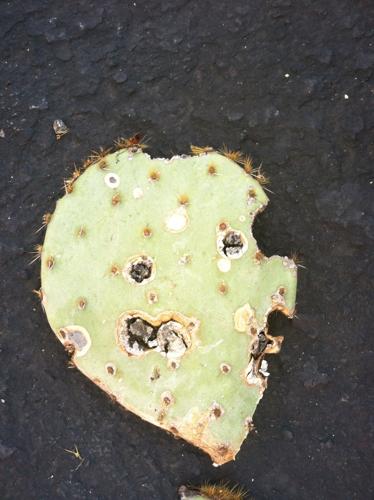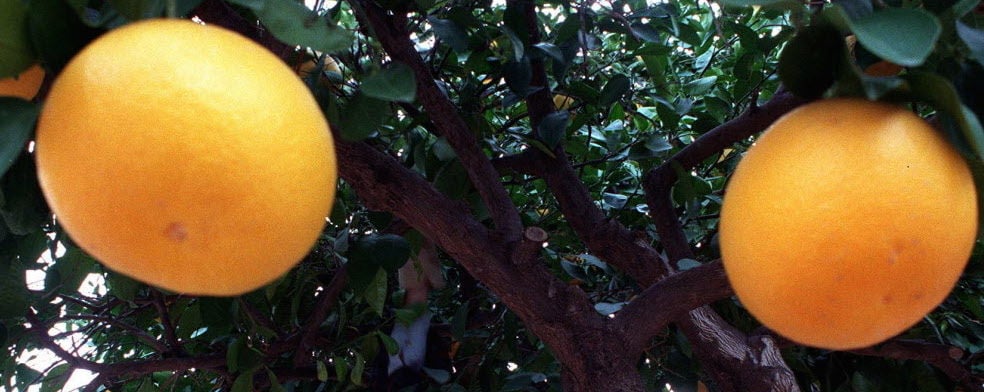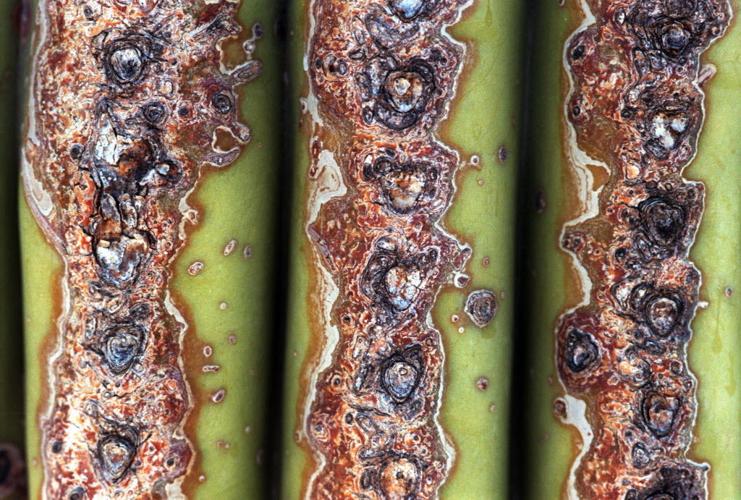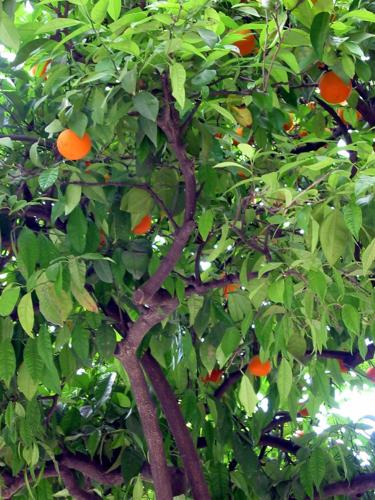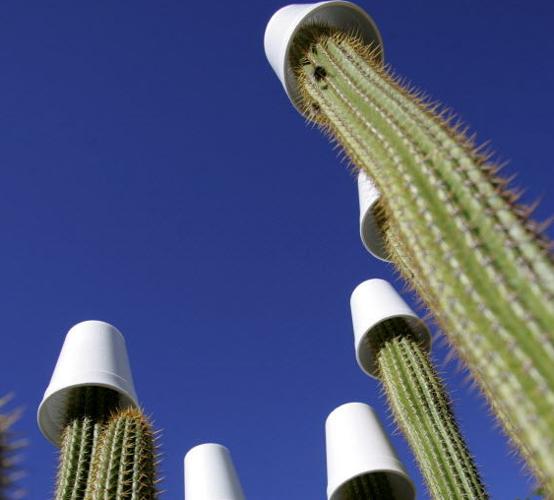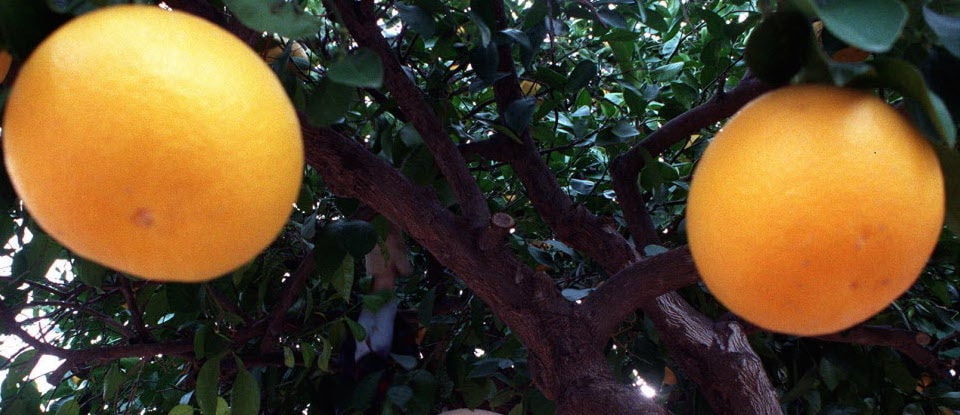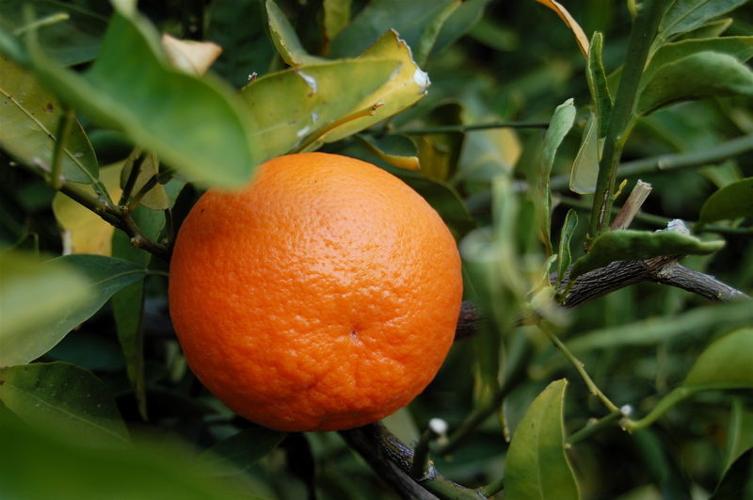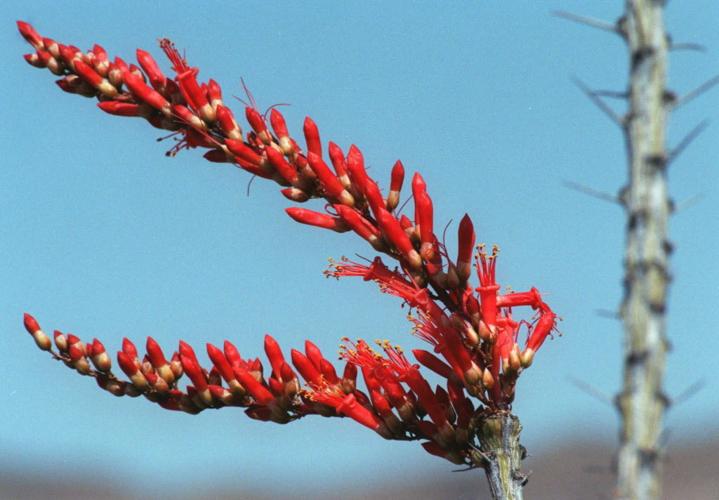Devastation of flea beetles; black splotches; save your pines
- Updated
Answers to your gardening questions from an expert in Southern Arizona.
- By Peter L. Warren Special to the Arizona Daily Star
- Updated
Q: We just installed five viga posts on our back patio. Two of them are where I could plant a vine in the ground; the other three need to be in a pot. Height to the patio roof is about 11 feet. Looking for something I can train to grow up and around the post, but the kind that cling. The area gets morning sun until about 11:30 a.m. and then shade the rest of the day. Flowering, thornless and non-deciduous would be ideal. Would also like to find a vine that I might be able to use along our retaining wall, specifically in the sections that have an iron railing between the stucco posts. This would be full sun most of the day and the height of the iron fence is about 6 feet.
Answer: My first thought is star jasmine because I have it growing at my house and it’s flowering now. It does well in part shade and produces very fragrant flowers in the spring. For the retaining wall, you might consider cat’s claw. This vine loves full sun and will cover a sturdy wall. These are fast growing and need to be managed but most vines are that way to some extent. There are other vines to choose from; search for options at az1606.pdf
Peter L. Warren is the urban horticulture agent for the Pima County Cooperative Extension and the University of Arizona. Questions may be emailed to
- By Peter L. Warren Special to the Arizona Daily Star
- Updated
Q: Thanks for the bug lesson last weekend at the Jewish Community Center. Thanks to you, I was able to identify lace bugs on our sunflowers (you predicted they would show up) and I mitigated with blue Dawn. While there, I noticed that our Japanese eggplant have something going on with them. Are you able to help out based on the two images I am including? No insects were visible.
A: Flea beetles are eating your eggplant leaves. They are tiny and hard to see, and they tend to jump like fleas when they sense danger. They are one of the most difficult-to-manage pests of eggplant and cole crops. They are also a problem on seedlings of tomatoes, potatoes, peppers, turnips, radishes and corn. There are various species of flea beetles, all members of the Chrysomelidae family. The adults are active leaf-feeders that can, in large numbers, rapidly defoliate and kill plants. You are seeing the symptoms of adult flea beetle feeding: small, rounded, irregular holes that make leaves look as if they had been peppered with fine shot. Additional damage may be done by the larvae, which feed on plant roots. Some flea beetles are considered general feeders, though many species attack only one plant or closely related kinds of plants. Because of this you can sometimes use anther crop to lure them away. For example, radishes are sometimes preferred over eggplant. Another tactic is to put yellow sticky traps near your plants to attract and capture these insects. Organic products that have some effectiveness are insecticidal soap and neem oil. Pyrethrin products such as Pyganic as well as hot pepper wax and rotenone are reported to be better.
No matter what you choose, the most important things to do are spray them early in the season before they do too much damage to young plants and read the label before you use these products so you are aware of safety precautions for using them.
Peter L. Warren is the urban horticulture agent for the Pima County Cooperative Extension and the University of Arizona. Questions may be emailed to
- By Peter L. Warren Special to the Arizona Daily Star
- Updated
Q: I live in Barrio Santa Rosa and have two massive Aleppos that were planted on my property in the early 1950s. I have noticed recently that many of the lower branches on one of the trees are dying. I am seeing brown needles throughout the tree, but not a lot. These trees have defined our property and it looks like they may have fallen victim to the bark beetle. One of the trees looks fine; the other I can see a dozen of the lowest limbs dead. This one has brown leaves sporadically throughout, but mostly at the bottom, not at the crown.
I have had the entire property on drip for 15 years or more, so I always considered them adequately watered. Also, the gutters from the roof drain into this part of the yard. Any advice you can give me would be greatly appreciated. What I’d really like to hear you say is that they just need a bit more water!
A: Your trees don’t appear to be infested with bark beetles from the photos. The holes look like woodpecker damage and the dead branches in the crown of the tree are normal as the trees age. It would be good to hire an arborist to climb the trees and cut out the dead and damaged branches both to clean it up and also to prevent dead limbs from falling and hurting you or damaging your property. Watering these large trees is difficult because the root zones extend two to three times the height of the tree. You are likely not getting water to the absorbing roots at the end by using a hose. The best you can do is drip irrigation with emitters arranged in a circular fashion outside the drip line of the tree. The schedule for watering should be every seven to 14 days in the summer, every 10 to 21 days in the spring and summer, and every 14 to 21 days in the winter. The water should reach a depth of 24 to 36 inches each time and you can use a soil probe to determine how deep the water is going. So it’s not time to give up
Peter L. Warren is the urban horticulture agent for the Pima County Cooperative Extension and the University of Arizona. Questions may be emailed to
- By Peter L. Warren Special to the Arizona Daily Star
- Updated
Q: I have Sago and Fan palms with shoots growing out from the base of the plant. Can I remove the shoots and replant them elsewhere? If so, how do I go about removing the shoots?
A: The Sago (Cycas revoluta) is not a true palm, but a cycad. It produces offshoots, sometimes called pups, at the base of the plants. They can be separated using a trowel and transplanted to another location after letting them dry for week or so to seal up the wound.
You might start them in a container in the shade or put some shade cloth over them until they are established if you plant them in the ground. The fan palm shoots are likely growing from seed that fell from nearby trees. These small plants can be moved to other locations by digging them up with the roots and replanting. They typically have small and shallow root systems so it shouldn’t be much trouble while they are young.
Peter L. Warren is the urban horticulture agent for the Pima County Cooperative Extension and the University of Arizona. Questions may be emailed to
- By Peter L. Warren Special to the Arizona Daily Star
- Updated
Q: Please tell me how and when to feed and care for crepe myrtle.
A: The crepe myrtle (Lagerstroemia indica) is an interesting woody Asian tree/shrub that grows well throughout the southern US. It does best in a loam/clay soil and needs regular watering.
By this I mean, every 7 to 14 days in the summer to a depth of 24 to 36 inches. In the spring and fall, water every 10 to 21 days and in the winter water every 14 to 21 days.
Fertilization can be done once each spring with a complete fertilizer such as 10-10-10 or you can use organic products such as composted manure. Make sure you water right after you apply the fertilizer.
In any case, a one to two inch layer of bark mulch over the root zone (being careful to keep it away from the trunk) will provide some protection for the roots from hot temperatures and help keep the root zone moist longer.
Some advocate for renovation pruning in the winter (called crepe murder by others) but this is hard on these plants so I recommend minimal pruning to remove dead and broken limbs, crossing and rubbing branches, and shape as needed.
Peter L. Warren is the urban horticulture agent for the Pima County Cooperative Extension and the University of Arizona. Questions may be emailed to
- By Peter L. Warren Special to the Arizona Daily Star
- Updated
Q: Please tell me the name of this plant. Also if it blooms, will it then die?
A: This is the Queen Victoria agave (Agave victoriae-reginae). According to Greg Starr in his excellent book called “Agaves”, this is a Chihuahuan Desert species. It grows well throughout our area although it doesn’t do as well in the hot sun of the low desert so planting it in a spot with afternoon shade is a good idea. It is a slow growing species and after 20-25 years it will bloom and then die.
Peter L. Warren is the urban horticulture agent for the Pima County Cooperative Extension and the University of Arizona. Questions may be emailed to
- By Peter L. Warren Special to the Arizona Daily Star
- Updated
Q: Our HOA of 40-plus years has numerous sheared shrubs and we’re trying to renovate and naturalize as many as we can. I hope you can follow up your tree pruning advice with some on the positive approach of hard pruning or rejuvenating some currently sheared, older and overly large Texas rangers and oleanders.
A: Renovating or rejuvenating older, overly large, or previously sheared shrubs extends the life and improves the aesthetic value of these plants. One method is to cut all stems to about 12-18 inches above the ground.
This is a severe measure and changes the appearance drastically, however, when done in early spring before bud burst, causes a great number of stems to grow just below each cut by mid-summer. At that time, about half of the stems should be removed and the remaining ones should be cut back to different heights.
Varying the height and cutting just above an outward pointing bud will stimulate growth of new branches out of the canopy. According to University of Arizona Horticulture Specialist, Ursula Schuch, this procedure works well for larger fast growing shrubs like Texas ranger and oleander and for slower growing shrubs like hop bush and creosote.
Some shrubs such as cassias, arborvitae, rosemary, and junipers do not respond favorably to this treatment and might die. A less severe approach to rejuvenating shrubs is to remove half or more of the older unproductive branches at the base of the plant or those growing into the canopy. This thins out the plant to a much greater extent than regular maintenance pruning.
Follow-up care requires removing a portion of the new shoots a couple of weeks later, which might be too numerous and result in an overly dense canopy.
A third method of rejuvenation that spans three to four years and is less noticeable requires removing about one third to a quarter of the oldest unproductive branches each year. This method requires thinning excess branches and cutting back the remaining new branches as described before.
A common practice that is not recommended except in the case of formal hedges and topiaries is shearing. Shearing shrubs means cutting back branches to a uniform surface using heading cuts. We see all sorts of examples in our area where shrubs have been sheared to resemble beer can and meatball shapes. It doesn’t just look weird; it’s bad for other reasons.
The maintenance costs for sheared shrubs increases because they require repeat shearing more frequently than they would need regular pruning and they use more water to recover from this harsh treatment. Shearing stresses plants and can result in decline or death.
Peter L. Warren is the urban horticulture agent for the Pima County Cooperative Extension and the University of Arizona. Questions may be emailed to
- By Peter L. Warren Special to the Arizona Daily Star
- Updated
Q: We live in Tucson and I have a question about an ocotillo we have had for about 10 years. It is watered with drip irrigation, and compared to other ocotillos in our neighborhood, leafs out when they do. It has grown well, is probably 15 feet tall with multiple arms. I have never pruned it; I have just left it alone. One thing that has puzzled me — it has never bloomed. There is one other in our neighborhood that hasn't bloomed, but all the others, including ones that are significantly smaller, bloom every spring. From what I have read online, ocotillos should do well with low maintenance, and ours has seemed healthy in every other way except for blooming. Any hope in that department?
A: I agree that ocotillos do well with little or no maintenance. The first cool rain in the spring of 10mm or more triggers flowering in ocotillos according to Bowers and Dimmitt (1994). Another factor that affects flowering is temperature. The temperature shouldn't be a problem in Tucson so maybe your ocotillo isn't getting enough water. You could provide supplemental water but not too much because that would be bad for the plant. Desert plants like the ocotillo can get by with watering every two weeks in the summer and every three weeks in the spring and fall. No irrigation is required in the winter. Flowering generally occurs between March and May although some bloom in the fall.
Peter L. Warren is the urban horticulture agent for the Pima County Cooperative Extension and the University of Arizona. Questions may be emailed to tucsongardensage@gmail.com
- By Peter L. Warren Special to the Arizona Daily Star
- Updated
Q: My overwintering chard has started to show a "white powdery" substance covering both front and backsides on some of the leaves. Photos are attached comparing normal and white powdery leaves on the chard plants. Any idea what this substance is and are the chard leaves still edible?
A: It looks like powdery mildew. Left alone it can kill the leaves. The organic solution is to spray it with a baking soda and water mixture. There are also conventional fungicides labeled for use on vegetables available if you are okay with that. The mildew washes off and cooking will take care of the fungus so the leaves should still be edible. Make sure your plants have enough room for air circulation to prevent this in the future.
Peter L. Warren is the urban horticulture agent for the Pima County Cooperative Extension and the University of Arizona. Questions may be emailed to tucsongardensage@gmail.com
- By Peter L. Warren Special to the Arizona Daily Star
- Updated
Q: I have several palm trees that produce clumps of seedpods each year. Right now they are yellow and will turn dark burgundy. Should I cut these seed pods off now before they mature? If not, when should I do it?
A: The reason to cut off the pods now would be to avoid having them drop the debris on the ground and to generally clean up the crown of the trees. Some people clean up their trees annually and others let them drop the seed. It is really up to you. The tree doesn't suffer from a light pruning each year and now is a fine time to do it.
Peter L. Warren is the urban horticulture agent for the Pima County Cooperative Extension and the University of Arizona. Questions may be emailed to tucsongardensage@gmail.com
- By Peter L. Warren Special to the Arizona Daily Star
- Updated
Q: We moved into our home in 1970, and there was a small grapefruit tree growing in the back yard. We don't know how old the tree is, but it is healthy and always produces hundreds of delicious grapefruit every year. Today I noticed that a cottontail rabbit was under the tree eating some of the leaves. There are a lot of cottontails in our neighborhood, but I didn't know that they eat grapefruit leaves. In the summer I always see a few damaged leaves in different places in the tree, but I thought that was caused by a leafcutter. My question is: what can I do to keep rabbits from eating the leaves?
A: Fencing is really the only prevention for keeping rabbits and other four-legged creatures away from desirable plants. If that isn’t an option you might consider doing nothing. Since your tree seems to be doing fine producing so much fruit and because rabbits can't climb trees, I recommend letting them eat the low hanging leaves. Most plants can tolerate some defoliation and still remain healthy and produce flowers and fruit. I would say the same thing about leaf-cutter bees. They only cause cosmetic damage to the tree.
Peter L. Warren is the urban horticulture agent for the Pima County Cooperative Extension and the University of Arizona. Questions may be emailed to tucsongardensage@gmail.com.
- By Peter L. Warren Special to the Arizona Daily Star
- Updated
Q: I reside in Scottsdale and I was curious to find out — realistically, how long does a Bermuda grass lawn stay nice and not overrun by weeds, dry patches, and so on before eventually needing to replace it with new sod?
A: The time it takes really depends on the care you are able and willing to give to the grass. Proper mowing, dethatching, fertilizing, irrigating, and pest management are the basic components of a lawn management program. Proper mowing means using a sharpened mower and adjusting it to the best height. This would be somewhere between a half inch to 1 1/2 inches depending on the variety. Mowing is best done on a schedule that keeps up with the growth of the grass. Just like other plants, you don't want to take off too much at one time (one third off the top is a good rule of thumb). Dethatching is something done as needed when the thatch, the spongy layer of plant material between the soil and the green parts of the grass, becomes thicker than half inch. You might need to rent a vertical mower or power rake to do this job. Fertilization with half pound of nitrogen fertilizer per 1,000 square feet each month during the growing season (April through September) promotes good vegetative growth. Make sure you water your lawn after you fertilize. How often you water after that depends on the weather. Typically, every three days to a depth of six to eight inches is good for the summer. This can be reduced if we have significant rain. If you keep up with all of this, the pest problems will be less because healthy grass is likely to shade out weeds and be more tolerant of insects and diseases. Overall, Bermuda grass is a tough plant that does well given the right conditions.
Peter L. Warren is the urban horticulture agent for the Pima County Cooperative Extension and the University of Arizona. Questions may be emailed to tucsongardensage@gmail.com.
- By Peter L. Warren Special to the Arizona Daily Star
- Updated
Question: I have a lemon tree that we planted three years ago. It is not growing well. It is next to an adult California pepper tree. (10 feet away) I would like to dig it out and transfer it. Are there any concerns or special care doing this?
Answer: Ten feet away from another tree is likely too close and the California pepper tree is known for its competitive roots so I am glad you are thinking of moving the lemon. One of the first things to consider when planting is the mature size of the tree so there will be plenty of room between the tree and anything else. There are some basic guidelines when transplanting. Moisten the area where you intend to plant a few days prior to digging to make it easier. Dig the planting hole twice as wide but only as deep as the root ball. The edges of the excavated area should be rough and sloping. A shallow hole prevents the tree from sinking and burying the trunk. One of the most common mistakes is planting too deep. Since your tree has already been in the ground for three years the roots will be growing. You may have to prune some of them back to extract it from the original planting hole. This is a good opportunity to check the root system for matted or circling roots. If needed you can cut and separate roots that are circling or heading in the wrong direction. Place the tree carefully into the planting hole. Remove just enough soil from the top of the root ball to expose the root collar, which should be level or slightly above the surrounding soil. The root collar is where the trunk flares out just above where the roots begin.
Backfill the planting hole with native soil. There is no need to add amendments. Studies show there is no advantage to mixing compost or other organic amendment into the soil. If hand watering or using bubbler irrigation, form a berm just outside the root ball to create an irrigation well. Apply water within this area. As the tree grows, expand the well. If using a drip system, use two or three emitters to wet this same area. Increase the number of emitters and spread them out to stay in line with the edge of the crown as the tree grows. Set your irrigation schedule to supply water every seven to 10 days in the summer and make sure the water reaches a depth of 36 inches. Apply a two to four inch layer of mulch to the entire tilled area. Keep mulch away from the trunk.
Peter L. Warren is the urban horticulture agent for the Pima County Cooperative Extension and the University of Arizona. Questions may be emailed to tucsongardensage@gmail.com.
- By Peter L. Warren Special to the Arizona Daily Star
- Updated
Q: Every gardener has a "great white whale," and mine is the loquat. I have already killed two of them ... one due to insufficient watering, and one for reasons unknown. The third is in a pot, so I can move it if it gets too sun scalded. I'd like to plant it permanently, but don't know what the specific requirements are for it to grow successfully here. Mesquite Valley Growers told me it can't grow in full sun, and Civano showed me theirs...in full sun! Can you help me?
A: Loquats may be grown easily in full sun in some places such as coastal California and there are probably some microclimates in our area where they do fine in full sun. In general, in the Sonoran Desert they do best with western sun protection and in partial shade. Newly planted loquats even benefit with eastern sun protection from a shade structure until they are established. The leaves tend to suffer in extreme heat and fruit can be damaged as well. The trunk may suffer from sun scald if planted in full sun so it’s not a good idea to prune them in that situation and instead, allow the branches to grow down to protect the trunk. Loquats grow well on a variety of soil types but need good drainage and will not tolerate standing water. While they are drought tolerant, they will produce higher quality fruit with regular, deep watering. The deep watering allows the roots grow deeper and it helps wash salt that accumulates through the root zone. This means you should water every seven to 14 days during the summer, every 10 to 21 days in the spring and fall, and every 14 to 21 days in the winter. Loquats benefit from regular, light applications of a complete fertilizer but too much nitrogen will reduce flowering. Composted manures and other natural fertilizers that contain less salt are good alternatives. Micronutrient deficiencies are sometimes a problem so keep an eye on the leaves for symptoms. If you still have problems, please let me know before you shout, "Thus, I give up the spear!"
Peter L. Warren is the urban horticulture agent for the Pima County Cooperative Extension and the University of Arizona. Questions may be emailed to tucsongardensage@gmail.com.
- By Peter L. Warren Special to the Arizona Daily Star
- Updated
Q: I was in a shopping center yesterday and watched a landscape crew trimming the trees, if trimming is the word for what they were doing. I know little about the subject, but why would they cut so far back? There must be some good reason. We don’t get hurricanes, so that isn’t it.
A: There is no good reason for what was done to those trees. The pruning style is called tree topping and it is simply bad for the trees. Trees require a large leaf surface area to provide food for maintenance and growth.
Topping cuts off a major portion of the food making potential and depletes the stored reserves. While removing most of the buds that would form a normal branch system, topping often stimulates the regrowth of dense, unattractive, upright branches (water sprouts) just below the pruning cut. Water sprout regrowth is vigorous. A topped tree will rapidly return to its original height, but will lack its original form.
The branch wounds left from topping are slow to close, therefore more vulnerable to insect attacks and fungal decay. An invasion by either pest can spread into the trunk, killing the tree. Weakened stubs are more prone to wind and storm breakage because they generally begin to die back or decay.
Increased sun exposure on trunk and branches can lead to severe bark damage. Ugly branch stubs, conspicuous pruning cuts, and a broom-like branch growth replace natural beauty and form.
Topping reduces the real estate value of trees by 20 to 100 percent. A correctly trimmed tree increases in value at each pruning. If tree workers suggest topping, I would hire somebody else. I recommend using ISA Certified Arborists whenever possible to assure that your tree workers have received the proper training and passed an exam on the topics most critical to good tree care.
Peter L. Warren is the urban horticulture agent for the Pima County Cooperative Extension and the University of Arizona. Questions may be emailed to tucsongardensage@gmail.com
- By Peter L. Warren Special to the Arizona Daily Star
- Updated
Q: I had an Eremophila racemosa for about three years until last week when it just dried up and died on me. I don’t know what happened. Is there some kind of insect that could have killed my bush? Also I would like to know about removing a stump from a tree that was cut down last year. I remember reading in your Sunday articles about how to remove a stump with some kind of natural items.
A: The emu shrub (Eremophila racemosa) is a desert-adapted plant from Australia. These plants are relatively free of insect pests, so I suspect that lack of water was the cause of its demise. In the summer, it is best to provide water every 7 to 14 days to a depth of 24 to 36 inches. In the spring and fall you can adjust your irrigation to water every 10 to 21 days and in the winter, every 14 to 21 days.
Stumps will naturally degrade in the soil. Depending on the size of the roots and the nature of your soil, it may take years to completely decompose. Fortunately for us, warmer soil temperatures are one factor that speeds up the process.
Other factors than can speed up the process include aerating the soil around the stump, irrigation of the stump as long as the water doesn’t accumulate, adding a small amount of nitrogen fertilizer and a layer of compost will help provide the microorganisms that break down the stump, and drilling holes in and/or scaring the stump and above ground roots provides access to fungi and bacteria that will aid in the process.
Peter L. Warren is the urban horticulture agent for the Pima County Cooperative Extension and the University of Arizona. Questions may be emailed to tucsongardensage@gmail.com
- By Peter L. Warren Special to the Arizona Daily Star
- Updated
Q: We have several different types of trees in our yard that have for the past three to four years been infiltrated by those large green hornworms. It is a complete puzzle to us where they come from, as we have no tomato plants or vegetable garden of any kind, and also why they keep showing up every year.
My husband has sprayed the trees with a solution that usually causes the worms to fall to the ground and thereby easy to find and dispose of, but why are we having this problem year after year and what can we do to avoid it? The trees we find them in are ash and willow. Any advice you can give would be appreciated.
A: The hornworm caterpillars you are finding are related to the tomato hornworm but not necessarily the same species. Tomato hornworms feed on potato, tobacco, tomato, and other plants in the nightshade family (Solanaceae). Other species of hornworms will feed on other plants such as your trees.
The sphinx or hawk moth family (Sphingidae) to which the hornworms belong includes about 125 species in North America. Around 40 or so of these can be found in Pima County. They are called hornworms due to the conspicuous horn on the back end of their abdomen and that is a clue that helps identify them as members of this family.
The adult moths, which are excellent flyers, lay eggs on their host plants, often at night. These caterpillars are not considered to be pests on trees since trees can handle some defoliation without any adverse affects. The caterpillars are also a good food source for birds so you can leave the pest management to them and save yourself some time and money on the insecticides.
Plus, I am guessing you don’t want the birds to eat caterpillars laced with insecticides. There is no practical way to avoid this situation in the future. You like your trees and the caterpillars have to eat.
Peter L. Warren is the urban horticulture agent for the Pima County Cooperative Extension and the University of Arizona. Questions may be emailed to tucsongardensage@gmail.com
- By Peter L. Warren Special to the Arizona Daily Star
- Updated
Q: I have a question about planting Cat Claw vines next to my stucco home. Will it damage the stucco?
A: It doesn't damage it per se although it does sometimes make a stain on the stucco. If you are okay with that then it has a decent reputation in the Southwest as an easy-to-grow vine. People from more humid regions such as Florida and Louisiana have a terrible time controlling this plant and consider it an invasive weed.
Peter L. Warren is the urban horticulture agent for the Pima County Cooperative Extension and the University of Arizona. Questions may be emailed to tucsongardensage@gmail.com
- By Peter L. Warren Special to the Arizona Daily Star
- Updated
Q: I am considering adding straw bales for growing my spring/summer vegetables and the initial treatment required for wetting the bales, adding Nitrogen as part of the preparation for microbial breakdown of straw materials during a two-week period. I read two online extension articles that stated straw bales with the right amount of moisture and outside temperatures may burn. Are you aware of any "spontaneous combustion" that has ever occurred using single straw bales either placed in a row or individually?
A: Straw bale gardening is a nice way to avoid growing in our poor soil, fighting off garden weeds, and preventing some joint and back pain by having a raised area to garden. Spontaneous combustion is a problem for hay stacked in large piles. Single bales used for gardening are not likely to generate enough heat for combustion.
Peter L. Warren is the urban horticulture agent for the Pima County Cooperative Extension and the University of Arizona. Questions may be emailed to tucsongardensage@gmail.com
- By Peter L. Warren Special to the Arizona Daily Star
- Updated
Q: I’m concerned about the recent news stories about new diseases such as the Zika virus spread by mosquitoes. I spend a good amount of time outdoors gardening and mosquitoes usually bite me. Are there any things I can do to prevent this problem?
A: Zika virus is transmitted to people primarily through the bite of an infected Aedes mosquito. These are the same mosquitoes that spread dengue and chikungunya viruses. Aedes mosquitoes prefer to live near people and only female mosquitoes bite. They are mostly daytime biters, but can also bite at night. Mosquitoes acquire the virus when they feed on a person during the first week of infection when they are carrying high numbers of Zika virus in their blood. Once inside the mosquito, the virus moves from the digestive tract into the salivary glands, a process which is thought to take about a week. After that time, the mosquito can spread Zika to the next person she bites. Zika virus can also be transmitted from mother to her fetus during pregnancy, through blood transfusions, and through sexual contact.
The best way to avoid getting Zika virus or other diseases spread by mosquitoes is to avoid being bitten by infected mosquitoes. We can minimize mosquito numbers by eliminating breeding habitats, for example, standing water in containers around our homes. When outdoors, dress properly and apply insect repellent. Here is a link to a publication on choosing repellents: extension.arizona.edu/sites/extension.arizona.edu/files/pubs/az1311.pdf
Other things you can do include the following.
• Switch to LED lights to be used outdoors - these are not attractive to mosquitoes because they have no ultraviolet spectrum.
• Place fine mesh over rain barrels to prevent egg laying.
• Repair screens for windows that may have developed holes.
• Repair leaky pipes and faucets.
• Mosquito dunks for ponds, birdbaths, and other water features with standing water.
What doesn't work - electronic bug zappers and high frequency repellent devices.
Peter L. Warren is the urban horticulture agent for the Pima County Cooperative Extension and the University of Arizona. Questions may be emailed to tucsongardensage@gmail.com
- By Peter L. Warren Special to the Arizona Daily Star
- Updated
Q: I am getting some strange damage on my palo verde tree bark. Do you have any idea what could be causing this damage?
A: Woodpeckers are likely damaging your tree. These birds seek insects to eat that may be on the bark or just under the surface. In some cases, pecking holes in the bark causes sap to flow and attracts insects for the birds to eat later. Because federal law protects most birds, the management of bird damage is limited to exclusion, frightening/repelling, and distraction. Exclusion can be accomplished with hardware cloth or other screens over the area to be protected. Frightening can involve sound or shiny materials that cause the birds to avoid the area. Distraction can be accomplished by providing another food source such as a suet feeder nearby that is more attractive than the tree.
Peter L. Warren is the urban horticulture agent for the Pima County Cooperative Extension and the University of Arizona. Questions may be emailed to tucsongardensage@gmail.com
- By Peter L. Warren Special to the Arizona Daily Star
- Updated
Q: I planted a fig tree for three years in a row and cannot seem to keep them alive. I do not know what I am doing wrong. I live in Catalina, north of Tucson, a little cooler area and my soil is sandy.
A: Figs are certainly a good plant for our area. Some basic things to consider include allowing enough room for them to grow to a mature size, planting them in well-drained soil, and planting them in the fall or early spring to allow them to get established before the hot summer weather. The two varieties that do well here are the brown turkey fig and the black mission fig. Irrigation should be scheduled every week during the summer and every two weeks in the spring, fall, and winter. Light fertilization can be applied during the growing season (May, June, and July). Split a half-pound of nitrogen fertilizer between those three months and water in after applying. If you are seeing other specific symptoms related to the death of your figs, please let me know so we can puzzle them out.
Peter L. Warren is the urban horticulture agent for the Pima County Cooperative Extension and the University of Arizona. Questions may be emailed to tucsongardensage@gmail.com
- By Peter L. Warren Special to the Arizona Daily Star
- Updated
Q: I know this is kind of a stretch, but I got your email off an answered question about caring for a cactus on a website. I bought a cactus in Japan (I'm stationed over here) and I have a couple questions. First is it normal to have that discoloration around the base and arms? Also, what kind of cactus is this? I just want to make sure I'm doing everything for it so it can survive!
A: Your plant is a type of Euphorbia. These plants are in the Euphorbiaceae family rather than the cactus family Cactaceae. They are often confused for cacti due to the spines and general appearance. The browning is a function of age and not anything wrong with the plant. Caring for this plant is similar to what you would do for cacti. Make sure it is in well-drained soil and water once a month if kept indoors in a container. The hot desert sun would be too much and I would recommend indirect sunlight, but in other locations where it’s not so hot make sure it gets plenty of sun. A water-soluble complete fertilizer can be used at a quarter strength monthly during the growing season. Avoid fertilizers that are high in nitrogen.
Peter L. Warren is the urban horticulture agent for the Pima County Cooperative Extension and the University of Arizona. Questions may be emailed to tucsongardensage@gmail.com.
- By Peter L. Warren Special to the Arizona Daily Star
- Updated
Q: My grape arbors are full of these bugs — hundreds of them eating my figs and grapes. I’ve never seen anything like this before. I shake the grape arbors and swarms fly out. Is there something we can do? Help! Attack of the June bugs!
A: They are sometimes called June bugs based on the time of year we see them. Today they are called March bugs. They are also called fig beetles (Cotinis mutabilis) and their white grubs are often found in the soil as people prepare their garden beds for planting. As adults, they can be managed with conventional insecticides, assuming this is not an organic operation. There are a variety of insecticides that work well and are labeled for use on grapes and figs. The problem is the beetles can fly and when there are large numbers of them it requires repeat treatments. So you can’t really stop them, you can only hope to contain them. There aren’t any great organic solutions for the adults unless you count the two brick method. Insecticides should not be sprayed while plants are blooming to conserve our valuable pollinators.
Peter L. Warren is the urban horticulture agent for the Pima County Cooperative Extension and the University of Arizona. Questions may be emailed to tucsongardensage@gmail.com.
- By Peter L. Warren Special to the Arizona Daily Star
- Updated
Q: I see these red bugs on the new growth of my Texas mountain laurel. It did not bloom last year and it was suggested that I am not watering enough. So I have been and now I have these guys. I don’t know if you can see in the picture but there is clear sap all around as well. I am thinking these are not beneficial? What should I do? They appear to be doing a lot of damage to new growth, so I am going to use a soap mixture to deal with them.
A: These red bugs (Lopidea major), also known as the sophora plant bug or mountain laurel bug, are relatively harmless although not beneficial. They will suck some sap and do minor aesthetic damage to the new growth for a short time in the spring. They will not do enough damage to justify spending time and money managing them. Insecticidal soap is a good solution as an irritant for small soft-bodied insects and may disrupt their feeding activity. If your soap solution doesn't work as you hope and you are determined to manage them, you might try an organic pyrethroid product called Pyganic that is more effective against plant bugs of this order.
Peter L. Warren is the urban horticulture agent for the Pima County Cooperative Extension and the University of Arizona. Questions may be emailed to tucsongardensage@gmail.com
- By Peter L. Warren Special to the Arizona Daily Star
- Updated
Q: I recently moved to a house in Phoenix, and am trying to understand the various plants in my yard. I have a couple trees that drop pods, which are very hard and dry when they fall (I haven’t seen them on the tree yet). The tree itself is deciduous, with sturdy branches extending from the trunk and “weeping,” vine-like branches that contain the leaves. Does anyone have any idea what this tree is? If so, are the pods edible?
A: Your trees are called bottle trees (Brachychiton populneus). This is an Australian native that does well here and averages 30 feet tall and wide at maturity. It isn’t supposed to be deciduous, so if it is dropping leaves unexpectedly, there could be a problem. The leaf photo you sent shows a nutrient deficiency, and that could cause the trees to drop leaves.
Make sure you are giving it proper fertilization and irrigation to remedy the leaf symptom. Since it is a relatively large evergreen tree, it is popular for producing shade. However, its size makes it too big for small landscapes and more appropriate for parks. The pods are not edible and might be the downsides of these trees if you use a reel lawn mower, walk around in bare feet, or don’t like picking them up. This species is susceptible to Texas root rot, and should not be planted in areas where this disease is known to occur.
Peter L. Warren is the urban horticulture agent for the Pima County Cooperative Extension and the University of Arizona. Questions may be emailed to tucsongardensage@gmail.com
- By Peter L. Warren Special to the Arizona Daily Star
- Updated
Q: Several months ago, I planted a Sophora secundiflora in a well-prepared, well-drained spot. When I purchased the plant, I asked about watering and was told, “Don’t let it dry out.” The shrub had what I considered a poorly developed root system. I used a 2-inch layer of pea-sized gravel for mulch. About a month after it was planted, I noticed yellowing of the leaves. Thinking this might be chlorosis, I looked for causes of this on the Web. The one that kept coming back up was overwatering. So I decreased watering. Now I am thinking it was not chlorosis, and withholding water was a bad idea. The buds at the base of the leaf petioles still seem hydrated, as do the twigs and stems. Any ideas on what I should or should not do to ensure this shrub survives?
A: Texas mountain laurel is a drought-tolerant species native to the Southwest and requires well-drained soil and infrequent watering. During the first year after it is planted, it can be watered once a week. After that, it is best to change your irrigation schedule to once every 14 to 21 days except for winter, when you can stop irrigating until spring each year. Unfortunately, the symptoms of overwatering can look like underwatering, so it’s understandable how you could mistake one for the other. Transplanting stress may also be a factor in the first year and show up the same way. Many plants purchased in containers have greatly reduced root systems, so some of that is expected. The important thing is to provide good care while the tree becomes established. Time will tell if your tree will survive. It may just drop the yellow leaves and releaf.
- By Peter L. Warren Special to the Arizona Daily Star
- Updated
Q: I know that I and many other readers of the Star would really appreciate advice from you about what to plan regarding cutting back bushes this year. Normally, we would have been thinking no later than mid-March, but with this goofy hot weather we’re having, normal-year planning seems irrelevant. Help, o Garden Sage!
A: Pruning damaged or dead wood may be done anytime, but as you know, we recommend waiting for warm weather for cold-sensitive plants. Pruning for other reasons such as structure, shape and size is typically done with the idea of minimizing stress to the plants, and that is usually accomplished in the cool part of the year, so your mid-March deadline makes sense. With tougher plants, that deadline can be extended into the warmer months. Some plants, however, are pruned with blooming in mind, and timing depends on when each species produces flower buds. We have a pruning calendar you can access on the Internet that has more details (search for az1499.pdf). Regarding the unusual weather this year, it is easy to see how our unseasonably warm weather lately might give us a false sense of security and/or fear about the days and weeks ahead. Our UA climate science specialist, Mike Crimmins, reminds us that it is still technically winter, and the volatile weather patterns we have been seeing this year are difficult to predict. We are still hoping that El Niño will send some rain our way in March. Crimmins says that would reduce the freeze risk since the moisture helps keep overnight temps up. So with all the uncertainty, the best plan would be to stick with the mid-March plan for pruning and starting tender annuals outdoors.
Peter L. Warren is the urban horticulture agent for the Pima County Cooperative Extension and the University of Arizona. Questions may be emailed to tucsongardensage@gmail.com
- By Peter L. Warren Special to the Arizona Daily Star
- Updated
Q: About four to five years ago, I planted an oak tree in my front yard. ... As yet, it has not grown, I don’t think, 1 inch. It does get leaves every year, but that’s it. What can I do to help it grow?
A: Trees transplanted to a new location typically take a couple years to adjust to their new surroundings. A big part of the adjustment is growing new roots, which are usually drastically pruned and damaged in the transplanting process. Since the below-ground root growth is not obvious to us above-ground animals, it appears that nothing is happening for quite a while. The rule of thumb is: The first year they sleep, the second year they creep, and the third year they leap. This growth pattern assumes the tree was planted in a suitable location and the care was appropriate. Care, once established, includes annual fertilization with a complete fertilizer and regular irrigation. For an oak tree that is not a native desert species that means watering to a depth of 24 to 36 inches every seven to 14 days in the summer, every 10 to 14 days in the spring and fall, and every 14 to 21 days in the winter. The emitters for your drip irrigation system should be placed in a ring around the tree at or near the edge of the tree canopy so the water will reach the absorbing roots. You can also put a half-inch of compost on top of the soil around the tree root zone and an inch or two of organic mulch on top of the compost. The slow release of nutrients from these as they decompose, along with their protection of the root zone, can help keep your tree healthy.
Peter L. Warren is the urban horticulture agent for the Pima County Cooperative Extension and the University of Arizona. Questions may be emailed to tucsongardensage@gmail.com
- By Peter L. Warren Special to the Arizona Daily Star
- Updated
Q: I would like to know when and how and what type of fertilizer I should use for plum, apricot, peach and fig trees. My trees are 2 to 3 years old.
A: Once established, fruit trees need to be fertilized each spring to ensure that new healthy growth occurs and fruit will be large and tasty. For trees of 2 to 3 years of age, you can use 3/4 of a pound of a complete fertilizer that contains nitrogen, phosphorus and potassium. Spread the fertilizer evenly under the tree near the edge of the crown of the tree, also known as the drip line where rain falls and your drip irrigation should be installed. Timing your irrigation to coincide with fertilization will help the fertilizer reach the roots and protect the roots.
Peter L. Warren is the urban horticulture agent for the Pima County Cooperative Extension and the University of Arizona. Questions may be emailed to tucsongardensage@gmail.com
- By Peter L. Warren Special to the Arizona Daily Star
- Updated
Q: There is a tree in bloom outside my office and I’m wondering what it is. It has white/green blossoms and looks like a pear tree but doesn’t smell like a fruit tree. It sort of smells like sewage. The smell is similar to a carob tree, but more so. I tried to find it online by googling smelly blooming trees and I think it might be a callery pear.
A: You are correct. The tree in question is a callery pear (Pyrus calleryana). These are ornamental pear trees bred to produce flowers and not edible fruit. They became very popular in the last quarter of the 20th century and can be found in many cities and towns as a street tree. The variety most seen is ‘Bradford’ although there are at least a couple dozen others. The flowers have an unfortunate odor as you noticed and are best observed at a distance. Another unfortunate feature of Bradford pears is their branch structure. The tendency for branches to grow from the trunk at sharp angles predisposes these trees to break in high winds. The one thing this tree has going for it is resistance to fireblight, a disease that affects other pear trees. The newer varieties have been bred for better features but fireblight continues to be a concern.
Peter L. Warren is the urban horticulture agent for the Pima County Cooperative Extension and the University of Arizona. Questions may be emailed to tucsongardensage@gmail.com
- By Peter L. Warren Special to the Arizona Daily Star
- Updated
Q: How can I keep the mice out of my compost? One of the most terrible days of my life was last fall when I used a sharp-bladed shovel to dig out last year’s compost pile. Suddenly and unexpectedly I heard the shrill and amazingly loud screaming of mice. As I quickly removed my shovel I saw with horror that it had sliced a mouse nest in half, decapitating, killing, and wounding three of the blind, hairless baby mice. The two unharmed baby mice I put back in the compost where they were soon rescued by the parents. But I never want to have that experience again.
After the catastrophe, I got rid of my old compost bin that used to sit on the ground and replaced it with a plastic bin raised up 2 feet from the ground on metal legs. I used metal mesh to seal the base of the bin in case mice could actually climb up the slippery metal legs, and this I thought would keep the mice away from my delicious kitchen scraps. Now, two months later I again see small gray mice inside the compost bin. It is winter and they want to be warm and not hungry, but I dread what will happen in the early summer when I want to use that compost in my garden. Any ideas of how to avoid another mouse tragedy?
A: It is difficult to keep rodents out of anything. If you weren’t so concerned about the mice, I would recommend snap traps baited with peanut butter near the base of your compost bin. Since you are concerned, the best bet is excluding them from the compost bin. Exclusion could work with your current compost bin if you can use mesh with small enough holes that they cannot squeeze through. Hardware cloth with quarter-inch holes should be enough to keep out adult mice. Using a bin with a lid can also aid in exclusion. Another idea is to make this compost habitat less appealing by turning your compost once a week. Turning compost with a pitchfork can result in the same deathly experience if not done frequently enough. There are also the sort of bins that can be turned with a crank if that is more your speed. If composted material is decomposing ideally, it reaches a fairly high temperature in the middle and no mouse is going to set up housekeeping in that heat. In the end, you might have to just be more careful digging around the top of your compost pile to avoid more mouse mayhem.
Peter L. Warren is the urban horticulture agent for the Pima County Cooperative Extension and the University of Arizona. Questions may be emailed to tucsongardensage@gmail.com
- By Peter L. Warren Special to the Arizona Daily Star
- Updated
Q: I have attached a photo of my coral aloe (Aloe striata). After much searching, I believe the hideous, growth seen in the photo is aloe cancer/gall/mite? I have dug up, bagged and put the plant in the trash. Apparently, I can never have another aloe again except Blue Elf? Is this true, and is this wretched little mite a menace to my neighbor’s aloes? Is there anything else I should do? It makes me almost miss the killing freezes in Colorado!
A: I believe you are correct about the diagnosis. That appears to be damage caused by the eriophyid mite (Aceria aloinis). Because these mites are microscopic, it is difficult to know they are there until the damage is seen. There is some anecdotal evidence that the “Blue Elf” variety of aloe is unaffected but there is no science to back this up that I have seen. On the other hand, other known host plants include the aloe species arborescens, dichotoma, nobilis, and spinossima as well as Haworthia species. In general, I don’t see these mites as a widespread problem so I wouldn’t put all my aloe investments in one species. They are sporadic pests on aloes and based on the number of questions I get, many people don’t have a problem with them. These mites can spread by crawling and by wind. Because they can’t fly it isn’t a quickly spreading problem and your neighbor’s plants could very well be safe from infestation. What you did by bagging the infested plant and disposing of it is the best thing to do and probably enough to stop it from spreading.
Peter L. Warren is the urban horticulture agent for the Pima County Cooperative Extension and the University of Arizona. Questions may be emailed to
- By Peter L. Warren Special to the Arizona Daily Star
- Updated
Q: We are planting cat claw vines along a fence line for privacy. We chose cat claw for its low water use, fast growing and lower temperature tolerance. We live in Catalina at 3,140 feet. Our soil is gravelly sandy silt for 18 inches with a silty clay layer below. We have built 4-foot wide by 8-foot tall trellises to cover the 50-foot stretch along a chain link fence on the south side of our house. The trellises are rebar and four-by-four-inch welded mesh panels. I just read that cat claw may not be suitable for planting on wire. Why? I had not read that before. If it’s about strength shouldn’t what we have built support them? How far apart should we plant the vines, the nursery told us five feet. Would four feet be too close? Would one foot from the fence be appropriate?
A: The reason wire fences are not recommended is because the foliage of cat claw vine (Macfadyena unguis-cati) tends to concentrate near the top of the plant making it top heavy. The average wire fence would likely not support such a heavy plant. Rebar and welded mesh panels are probably tougher than the wire fence you read about. You might need to add horizontal stretches of wire to prevent the vine from pulling away once it fully covers the trellis. This is a fairly aggressive vine and should ultimately fill in the gaps when planted five feet apart. Growth should start slow and speed up once it becomes established. One foot from the fence seems right.
Peter L. Warren is the urban horticulture agent for the Pima County Cooperative Extension and the University of Arizona. Questions may be emailed to
- By Peter L. Warren Special to the Arizona Daily Star
- Updated
Q: I live in Tucson (caliche paradise). I have a ruby red grapefruit tree in my patio. It is 20 years old, 17 feet tall. Over the years I have trimmed it into a nice shade tree that gives us 150 square feet of shade. It has four separate trunks off the main trunk. The main trunk is 38 inches in circumference. I just harvested it and counted over 500 large grapefruit. I have not fed it in the last 10 years. I deep water every 10 days in the summer and once a month in winter. What is the normal life span? What am I doing wrong?
A: Grapefruit trees do not need a lot of fertilizer. A mature tree of the size you described probably has roots extending past the patio and receiving fertilizer from your turfgrass, garden, etc. Or perhaps the site is on a former agriculture field and there is still some residual fertilizer left in the soil. Or perhaps there is fertilizer in the irrigation water. Sooner or later, the tree will show nutrient deficiencies. Maybe it already is, but your yield is not yet affected. Grapefruit trees can live to be 50 years under ideal conditions but insects, diseases, and user errors often take their toll and shorten life spans. Your irrigation schedule seems to be on track so other than finding a way to add some fertilizer to the outer root zone, I think you are doing a fine job taking care of your tree.
Peter L. Warren is the urban horticulture agent for the Pima County Cooperative Extension and the University of Arizona. Questions may be emailed to
- By Peter L. Warren Special to the Arizona Daily Star
- Updated
Q: We have chickens running free in a backyard of citrus trees, and to protect the flock I’ve avoided using granular citrus fertilizer to feed those trees. I’ve used water-soluble general plant food followed with a top dress of compost or mulch, but want to meet the particular nutritional needs of the citrus. How would you suggest fertilizing the citrus?
A: The way you are fertilizing is fine. The important information to know is how much nitrogen, phosphorus, and potassium (potash) is in your water-soluble plant food. The percent of these three nutrients contained in a particular product are usually listed in that order, separated by dashes, on the front of the fertilizer container. Once you know the percent nitrogen, you can cross-reference that with the size the tree in our handy chart to determine how much fertilizer to put down. The difficult thing to know about compost and mulch is the amount of nitrogen available to the plant. The good companies put an analysis of the compost on the bag but still you have to wait for the compost to be watered into the root zone and that can take varying amounts of time dependent on your soil type and how much water is used. The nice thing about compost and mulch is that independent of the nutrients they provide, there is protection of the root zone that can moderate temperature extremes and increase the water holding capacity of the root zone. By the way, depending on how many chickens you have, you may be getting significant additional fertilizer from them.
Peter L. Warren is the urban horticulture agent for the Pima County Cooperative Extension and the University of Arizona. Questions may be emailed to
- By Peter L. Warren Special to the Arizona Daily Star
- Updated
Q: I was finally sitting outside last week with my soda and had up to five aggressive bees wanting my beverage. Yikes! They even have a memory cause the next day without my beverage, they were still checking me out! I also noticed them in my recycle bin. I don’t remember this happening before. Is anything different going on?
A: The main thing going on this year is a slightly colder winter. Honeybees overwinter in their hives to keep warm and feed on the honey they stored during the warmer months. On nice days, they are as likely to get outside as you are and they will also partake in a sweet beverage. Since not as many flowering plants are available in the winter, you may see honeybees in recycle bins where food and drink residues may be found in addition to having some competition for your beverage.
As you exclaim, “careful man, there’s a beverage here,” be reminded that we all have to eat and a sugary beverage is a food source for a bee.
Peter L. Warren is the urban horticulture agent for the Pima County Cooperative Extension and the University of Arizona. Questions may be emailed to
- By Peter L. Warren Special to the Arizona Daily Star
- Updated
Q: I live in Sierra Vista and have a small peach tree, about 3 to 4 years old. Last spring it bloomed for the first time and set about a dozen peaches. When the fruit was a bit smaller than golf ball size, I noticed each one had a small hole and was oozing a clear sap-like substance. I assume an insect of some kind that had bored into the fruit caused it. Each peach shriveled up and fell off the tree. With what should I treat my tree and when to prevent this again?
A: Peaches and other fruits such as pomegranates are potential food for a few different insect species. Based on your description, I suspect one of the larger plant bugs we refer to as leaf-footed bugs. They have piercing-sucking mouthparts that penetrate the fruit to suck out the sap. Their saliva has a toxin in it that injures the fruit. The resulting wound is also an entry point for disease and that is possibly what caused the fruit to shrivel and fall from the tree. Treating for this insect is challenging because as adults they are fast moving and can fly. The insecticides used are contact poisons so you need to know where they are and hit them directly with the treatment. There are organic and conventional insecticides available for this pest.
The best time to treat for them is when they are young. The young are yellow-orange in color and usually hang out in a group. Since you have a small tree this will be easier than if you had an orchard of trees to monitor.
The other thing you can do is look for eggs on your tree and remove them before they hatch. This hatch occurs in a week or less after they are laid so monitoring once a week is critical to removing them before they emerge. The eggs are laid in a row along a stem or the midrib of a leaf and are golden-brown in color. Since these insects also feed on citrus and pomegranates, it is good to monitor those plants as well if you have them nearby.
Peter L. Warren is the urban horticulture agent for the Pima County Cooperative Extension and the University of Arizona. Questions may be emailed to
- By Peter L. Warren Special to the Arizona Daily Star
- Updated
Q: We have some old mesquite trees and palo verde trees near our walking lanes. There are old clay unsealed sewer pipes nearby at a depth of about 4 feet. Are we at risk for sewer problems? How far should any tree be from a lane with old sewers? As for new trees, we were thinking of planting more of the above but not near the walk lanes. Desert willows were also suggested, but they may need more water. Do you have any other suggestions?
A: Your sewer pipes are at risk with tree roots nearby. Typically, mature tree roots extend 2 to 3 times the width of the crown so it is wise to give any potential obstructions such as sewer pipes, sidewalks and houses enough room. Since the trees are old and so are the pipes, you might wait and see if a problem presents. It is certainly a good idea to have the pipes inspected or monitor the water use rate if you suspect a leak. There are quite a few choices for low water use trees. The decision usually begins by measuring the space you have available both below ground and above ground. The mature size of a tree should be accounted for in any plan to plant. Desert willows are a low water use tree and a good one if your space isn’t large enough for a mesquite tree. Other species to consider include white thorn acacia, ironwood and Texas ebony. Your plan should also include irrigation even though you are planning to go with a low water use tree. Even native desert species need some water.
Peter L. Warren is the urban horticulture agent for the Pima County Cooperative Extension and the University of Arizona. Questions may be emailed to
- By Peter L. Warren Special to the Arizona Daily Star
- Updated
Q: Should I be worried that my landscaper severely trimmed the bottoms of these two old agaves? He said the reason was to keep snakes from hiding there and make it easier for them to clean around. He removed one without notifying me, saying it was too close to the other and was “dying.” I see some evidence of west-side gray leaves; does this mean my agaves are dying or is it sun damage?
A: It is troubling that your landscaper pruned these plants and so severely. Typically, agaves don’t need pruning unless they have diseased or damaged leaves. Some people prune off the pointy leaf ends if they extend into walkways but even this is damaging to the plant. If snakes are a regular problem in your area, maybe there is a good reason for protecting the landscapers.
It’s not clear what sort of cleanup is required from the photos or what you asked him to do in that regard. Removing one because it was too close makes sense although it probably should have been discussed before removing it.
Finally, agaves don’t do great in direct western sun so you might be seeing sunburn on the leaves facing that direction.
Peter L. Warren is the urban horticulture agent for the Pima County Cooperative Extension and the University of Arizona. Questions may be emailed to
- By Peter L. Warren Special to the Arizona Daily Star
- Updated
Q: I’m in SaddleBrooke and have a few Thompson Yuccas. The recent winds caused one yucca to break off half way up, in the middle of its trunk. The breaking point looks to have had an injury at that point in its past. These plants are on the expensive end and are listed as disease- and pest-free, so I’m surprised to find myself with these issues.
A: Thompson yuccas (Yucca thompsoniana) are very tough plants and they do not have any known pests. They are tolerant of extreme heat and cold hardy to minus 10 degrees. The photo you sent shows what appears to be a rotten core and that made it susceptible to the winds that snapped it off. It’s likely that the past injury you noted was the beginning of the problem and may have allowed for disease to enter and progress.
I also noticed the leaves, which are typically darker green; seem to be suffering from lack of moisture and possibly salt damage. While these plants are drought tolerant, providing irrigation every two weeks in the summer and every three weeks in the spring and fall to a depth of 12 to 18 inches is recommended and makes them look better. Regular irrigation will also help wash the salt through the root zone.
Peter L. Warren is the urban horticulture agent for the Pima County Cooperative Extension and the University of Arizona. Questions may be emailed to
- By Peter L. Warren Special to the Arizona Daily Star
- Updated
- By Peter L. Warren Special to the Arizona Daily Star
- Updated
Question: Is there a list of fruit trees that grow in Tucson? Specifically, I am interested in peaches, apricots, cherries (sweet and sour) and apples? If they need a pollinator, which varieties do best together?
Answer: The main limiting factor to successfully growing fruit trees in Tucson is the lack of cold weather. Fruit trees require a certain amount of chilling hours to produce fruit, and we do not consistently get enough cold weather to meet the requirements for many fruit trees you may have seen or heard about in other parts of the country. Fortunately, there is a good selection of fruit trees that do fine here, and as long as you stick with these, you can have many years of harvesting your homegrown fruit. From your list of interests, you can find varieties of peaches, apricots and apples that grow well here. We don’t have cherries, but you can substitute figs, pears, persimmons, plums, quince, grapes, kiwi, blackberries, strawberries and pomegranates. Here is a link to our publication on fruits and nuts that includes much of what you need to know about these varieties. You will notice that the ones that do well in the low desert of Tucson are marked. There is a link to the pdf version that has a nice chart showing when they are harvested and if they require cross-pollination. Go to ag.arizona.edu/pubs/garden/az1269
Peter L. Warren is the urban horticulture agent for the Pima County Cooperative Extension and the University of Arizona. Questions may be emailed to tucsongardensage@gmail.com
- By Peter L. Warren Special to the Arizona Daily Star
- Updated
Question: Thanks to our climate, I’m doing a postmortem for last season’s garden and planning seed starting for next season pretty much simultaneously. About tomatillos: I’ve had rotten luck. I’ve had single plants, mixed varieties, started seeds, bought plants from reputable local nurseries and have tried to appropriately manage watering and soil nitrogen. Tomatoes have done just fine. Tomatillos? I’ve had rotten luck.
Answer: Now is an excellent time to revisit and evaluate your gardening practices in 2015. In theory, growing tomatillos should be easy although they are as sensitive to the heat as tomatoes and there are a few insects to watch for so you don’t lose your crop. Shade cloth can help protect them once the spring heat kicks in and checking for insects once a week should be sufficient to manage pests before they get out of control. Here are some basic guidelines for growing tomatillos. Please let me know if you are already doing all these things.
Tomatillos should be planted in full sun with well-drained soil. Jan. 15 to Feb. 15 is the ideal planting time, although you can wait until March if you are using transplants. Drip irrigation is ideal and should provide an inch of water per week. Multiple plants are required for pollination.
- By Peter L. Warren Special to the Arizona Daily Star
- Updated
Question: Thanks to our climate, I’m doing a postmortem for last season’s garden and planning seed starting for next season pretty much simultaneously. About tomatillos: I’ve had rotten luck. I’ve had single plants, mixed varieties, started seeds, bought plants from reputable local nurseries and have tried to appropriately manage watering and soil nitrogen. Tomatoes have done just fine. Tomatillos? I’ve had rotten luck.
Answer: Now is an excellent time to revisit and evaluate your gardening practices in 2015. In theory, growing tomatillos should be easy although they are as sensitive to the heat as tomatoes and there are a few insects to watch for so you don’t lose your crop. Shade cloth can help protect them once the spring heat kicks in and checking for insects once a week should be sufficient to manage pests before they get out of control. Here are some basic guidelines for growing tomatillos. Please let me know if you are already doing all these things.
Tomatillos should be planted in full sun with well-drained soil. Jan. 15 to Feb. 15 is the ideal planting time, although you can wait until March if you are using transplants. Drip irrigation is ideal and should provide an inch of water per week. Multiple plants are required for pollination.
Question: Is it too late for my bougainvilleas? I was out of town during the recent night freezes in Tucson, and I now have two bougainvilleas that are half frozen (they look great where the branches were protected by my awning). What do I do with the dead half? Pinch off the flowers and leaves? Prune it back? Just leave it alone?
Answer: Since you still have live parts it’s not too late to cover them in case we get more frosts. They will likely come back from this damage. The dead parts will protect the living parts somewhat in case we have more frosty temperatures so leave the dead parts on the plant until the spring when the danger of frost has passed.
Peter L. Warren is the urban horticulture agent for the Pima County Cooperative Extension and the University of Arizona. Questions may be emailed to tucsongardensage@gmail.com
- By Peter L. Warren Special to the Arizona Daily Star
- Updated
Question: I live here in Tucson at Villa Catalina condos at Sixth Street and Country Club Road. We have a small rose garden with some beautiful flowers. My problem is some of our larger flowers don’t fully open. I get a very large ball, very tight, but will not open. Then there are flowers next to them, and they open nicely. Any ideas?
Answer: There are a couple possible answers to this problem. If the rose buds that don’t open appear unhealthy, possibly with a browning on the edges, there are known diseases and insects that can affect them. If the buds appear to be healthy, a more likely problem is environmental stress. According to local rose expert and master gardener volunteer, Lauren Kettenbach, this time of year that is a common problem. Before Thanksgiving there was some pretty cold weather, and then it got warm again. So it could be weather-related, and it’s also very late in the season to have any blooms at all. I would not worry unless there is a problem with the spring bloom.
Peter L. Warren is the urban horticulture agent for the Pima County Cooperative Extension and the University of Arizona. Questions may be emailed to tucsongardensage@gmail.com
- By Peter L. Warren Special to the Arizona Daily Star
- Updated
Question: We live in the Tanque Verde area. In the spring I planted a tomato seedling in very good soil in the planter next to the house on the patio. It grew quite tall and produced tomatoes. I missed the weather forecast for our first frost, and the leaves wilted. Since then I’ve hung frost cloth from the eaves every evening, which traps the heat from the house. Last week when it was 26 on the patio it was 40 inside the frost cloth. Since it was wilted I cut the plant down, intending to uproot it, but noticed new green shoots coming from the bottom. Any hope for the plant, or should I start over in the spring?
Answer: As you saw, even if the temperatures are below freezing for a short time, some plants will die back above the soil and still be alive below ground. It is best to cover frost-sensitive plants when possible. In many cases, protecting plants with frost cloth can make the difference between survival and starting over. Your tomato could be fine since you are seeing new growth now. Time will tell for your plant and for many others. Patience is a virtue when determining how much damage your plants suffered. Some plants will not show new life until mid-spring.
Peter L. Warren is the urban horticulture agent for the Pima County Cooperative Extension and the University of Arizona. Questions may be emailed to tucsongardensage@gmail.com
- By Peter L. Warren Special to the Arizona Daily Star
- Updated
Q: Any idea whose eggs these are? They were on an orange tree in Tucson.
A: Katydid laid those eggs. Technically, katydids are grasshoppers of the long-horned variety (Family Tettigoniidae) due to their long antennae. They get their name from the noise they make in the evenings that seems to say ka-ty-did if you use your imagination. Because they often resemble the leaves of trees they inhabit, it is difficult to see them unless they move about. Their eggs resemble small seeds and are laid in a nice row on foliage or stems mostly. Like other grasshoppers, katydids feed on foliage although no appreciable damage is done so they are more of a curiosity than a pest.
Peter L. Warren is the urban horticulture agent for the Pima County Cooperative Extension and the University of Arizona. Questions may be emailed to tucsongardensage@gmail.com
- By Peter L. Warren Special to the Arizona Daily Star
- Updated
Q: I am writing to see if you have information about peach tree blight. I have two peach trees in Green Valley and both have been affected by a blight that causes the peaches to shrink in size and become inedible. Is there a treatment for this disease? Both trees have produced fruit for many years and are now advanced in age; one tree is 37 years old and the other over 30 years. They both still produce green leaves and fruit.
A: Improper pruning, not enough thinning of fruit, or poor soil fertility, can cause too small fruit. The other factor in your situation is the age of the trees. Peach trees don’t live forever and the average lifespan is around 15 years. I love old trees but if your goal is fruit production, the best thing is to replace your old trees with a couple of younger ones. Peaches typically start producing fruit by age 3 or 4 so if you can’t wait for fresh peaches, select a tree of that age to replace your older trees.
Peter L. Warren is the urban horticulture agent for the Pima County Cooperative Extension and the University of Arizona. Questions may be emailed to tucsongardensage@gmail.com.
- By Peter L. Warren Special to the Arizona Daily Star
- Updated
Q: Our small HOA is trying to convert to desert or semi-desert landscaping. It’s a fight, as some owners want the same flowers they had back east or in California, but we keep trying. We have a number of old Cyprus trees on the property and have been told that it is OK to disconnect the drip irrigation systems currently watering them because they have a well-established root system that will ensure they get enough water. Do you agree it is OK to not water them any longer? We don’t want them anymore, but can’t afford to cut them down. I’d also like to learn what desert plants you recommend that don’t need regular watering, provide color, and, if it’s not asking too much, what months they bloom?
A: Keep up the good fight for native desert or desert-adapted plants. We can always go visit our old plant friends from other places but it is hard to sustain them here. Cypress trees need water just like everyone else. If you cut off the supply, those trees will eventually die of complications from drought. The problem with just letting them die is they might fall and hurt somebody or something. If they are out in the middle of nowhere that might be okay but I am guessing they are not. There are desert plants that don’t need much water but everything needs some water.
The extreme examples get by with seasonal rainfall but even those plants suffer when we have a drought. There are quite a few choices of shrubs you can use that provide color and don’t require much water. A good online source of information for this is amwua.org/plants and of course you can always chat up your local Cooperative Extension agent, plant nurseries and Master Gardener volunteers about specific plants.
Peter L. Warren is the urban horticulture agent for the Pima County Cooperative Extension and the University of Arizona. Questions may be emailed to tucsongardensage@gmail.com
- By Peter L. Warren Special to the Arizona Daily Star
- Updated
Q: We have been having a bad stink bug infestation (hemipterans not pinacate beetles) the past couple of years in the garden. This past year they were out early and often and basically ruined the entire tomato crop. We are at 5,000 feet and don’t plant until May. First fruits are almost never harvested before Aug. 15. It is a cold zone with 46 nights at or below freezing so far this winter (no that is not a misprint). Do you have any suggestions to deal with these pests?
A: There are a couple things you can do. First, it is helpful to scout once a week when your crop comes up to see when the stink bugs begin to lay eggs. They are laid in a mass of 10-25 on the underside of leaves and look like tiny barrels. You can reduce the population significantly by removing the eggs before they hatch. Once they hatch and are actively feeding you can spray them and the sooner, the better while they are still young. If your crop is organic there is a product called PyGanic that works pretty well on hemipterans. If you use conventional pesticides, there are more choices but they may have some restrictions on when you apply them relative to when you harvest.
Peter L. Warren is the urban horticulture agent for the Pima County Cooperative Extension and the University of Arizona. Questions may be emailed to tucsongardensage@gmail.com
- By Peter L. Warren Special to the Arizona Daily Star
- Updated
Q: I have a backyard of Bermuda that is overseeded with annual rye grass. Last year was my first in this house and I moved in during January to find numerous winter weeds sprouting in the over-seeded Bermuda grass. With the recent rains I have the same weeds returning. Will a general-purpose weed and feed fertilizer/herbicide take care of the weeds or should I use another product? When should I apply? Last year I removed the weeds by pulling them out by hand.
A: Without knowing which weeds you are seeing I would guess you are concerned about winter annual broadleaf weeds such as London rocket. These are called winter annuals because they germinate in the fall, survive the winter, and sprout in the spring. Our winter in Tucson being mild and short, these weeds don’t waste time waiting for the vernal equinox and are up and flowering now. The answer to your question is likely yes; any post-emergent broadleaf weed herbicide will take these weeds down. A cautionary note: your trees and shrubs are in the same plant category as your broadleaf weeds so be careful about applying these herbicides on these desired plants and their root zones. In most situations, spot treating your weeds is better than carpeting your lawn with herbicide both for saving your desirable plants and for saving a few bucks on the product.
It is best to treat your weeds now before they go to seed. Be careful to avoid windy days so the herbicide doesn’t drift onto nearby plants and follow any other precautions listed on the label. Pulling weeds is also an option and can be therapeutic, if you have the time and the energy. Finally, keeping your lawn healthy is a good defense against weeds.
Peter L. Warren is the urban horticulture agent for the Pima County Cooperative Extension and the University of Arizona. Questions may be emailed to tucsongardensage@gmail.com
- By Peter L. Warren Special to the Arizona Daily Star
- Updated
Q: What is the best month in the Tucson/Marana area to trim back hibiscus and bougainvillea plants? Also, I need to cut back and trim greasewood so what is the best month for that shrub?
A: Hibiscus species should be pruned in late winter to promote growth in the spring because it blooms from buds produced in the same season. Bougainvillea species can be pruned once the danger of frost has past, usually mid-March. During the growing season, vigorous shoots can be pruned as needed. Greasewood, aka creosote (Larrea tridentata), doesn’t require any pruning except to control the size and that can be done any time.
Peter L. Warren is the urban horticulture agent for the Pima County Cooperative Extension and the University of Arizona. Questions may be emailed to tucsongardensage@gmail.com
- By Peter L. Warren Special to the Arizona Daily Star
- Updated
- By Peter L. Warren Special to the Arizona Daily Star
- Updated
Question: I am trying to find out what kind of plants I can plant in my garden that will help ward off insects.
Answer: Despite a large amount of misinformation published on this topic, there are no plants that can be used to repel insects effectively. There are, however, plants that can be planted together to reap other benefits. Flowering plants can be used to attract beneficial insects that help manage pests. Mostly these helpful plants are flowering plants that supply nectar and pollen to the predators and parasites that prey on pest insects. The nice thing is most any flowering plants can be effective in this way so you can choose ones that you like and that do well in your area. One plant feature that works well is flowers that face up and form a cup or sorts that can hold rainwater since water can be scarce. Another idea is planting varieties that are more attractive to pests and can be used as trap crops to lure the pests away from a desirable crop. The grower then has the option to spray the trap crop with the pests on it or simply let them eat it. Also, some plants act as nurse plants for more sensitive species by shading them. We often see saguaro cacti growing this way naturally in the desert.
Peter L. Warren is the urban horticulture agent for the Pima County Cooperative Extension and the University of Arizona. Questions may be emailed to tucsongardensage@gmail.com
- By Peter L. Warren Special to the Arizona Daily Star
- Updated
Poinsettias thrive on bright natural daylight: at least six hours daily is recommended. Placement near a sunny window is ideal, but avoid locations where hot afternoon sun may shine directly on, and fade colorful bracts.
To prolong the bright red of the bracts, temperatures ideally should not exceed 70 degrees during the day, or fall below 65 degrees at night. Avoid placing poinsettias near drafts, fluctuating air currents, excess heat and dry air from appliances, fireplaces or ventilating ducts. Poinsettias are sensitive to cold temperatures and outside placement during the winter months is not recommended when temperatures are below 55 degrees Leaf drop will occur if poinsettias are exposed to temperatures below 50 degrees
Poinsettias do best with moist soil so water when the soil surface feels dry to the touch. Like other container plants, the best indication of a thorough watering is water begins to seep through the drain holes at the bottom of the pot. Don't leave them sitting in water or they may suffer from root rot. It is not necessary to fertilize your poinsettias during the holiday season, however, beyond the holidays you should apply a balanced, all-purpose household plant fertilizer to promote new growth.
Poinsettias can be grown year round for lush green foliage.
March or April: When the bracts age and turn to a muddy green, cut the stems back to about eight inches in height. After you cut the plant back, it will probably look rather stark, with bare branches and bluntly cut woody stems.
By the end of May, you should see new growth. Keep the plants near a sunny window.
Around July 4: Cut branches back again about half their length to encourage bushy plants. You may place your poinsettias outdoors in indirect sun when night temperatures are warmer. Continue to water the plants regularly during the growing period. Fertilize every two to three weeks throughout the spring, summer and fall months with a complete, indoor plant fertilizer.
The poinsettia is a plant that requires a long period of darkness and is termed a "short day" (long night) plant. Short-day plants form flowers only when day length is less than about 12 hours. Many spring and fall flowering plants are short day plants, including chrysanthemums, poinsettias and Christmas cactus. If these are exposed to more than 12 hours of light per day, bloom formation does not occur.
November or December: Poinsettias will naturally bloom depending upon the flowering response time of the particular cultivar. This can be tricky to do outside of a controlled greenhouse environment, because any stray artificial light could delay or halt the flowering of the plants.
To make this work, the plants must be kept in complete darkness for 14 continuous hours each night beginning Oct. 1. This can be done by moving the plants to a dark room, or placing a large box over them. During this period, the plants require six to eight hours of bright sunlight and night temperatures between 60 and 70 degrees. This regimen must continue for about eight to 10 weeks for the plants to develop colorful bracts for the holiday season.
If this seems like too much effort, you can always support the horticulture industry by purchasing another poinsettia.
Peter L. Warren is the urban horticulture agent for the Pima County Cooperative Extension and the University of Arizona. Questions may be emailed to tucsongardensage@gmail.com
- By Peter L. Warren Special to the Arizona Daily Star
- Updated
Question: I found this insect on my gas grill today. Is this the kissing bug I have been reading about?
Answer: What you are seeing is the giant agave bug (Acanthocephala thomasi). Kissing bugs (Triatoma species) are smaller and don’t have the bright orange feet and orange tips on the antennae. Also, the kissing bugs feed primarily on mammals, such as pack rats and humans, whereas the bug you found feeds on plants. Recently, there was a flurry of news reports in other parts of the country on the kissing bugs and the associated Chagas disease they can transmit. These stories then spread through social media, gathering some misinformation as they went. So I understand why you are concerned. Despite the media hype, this was not actually new information.
Kissing bugs are more common in the Southwest. However, the risk of Chagas disease transmission in Arizona is very low, according to University of Arizona Cooperative Extension Specialist Dawn Gouge. UA researchers found a high rate of infection (about 40 percent) of kissing bugs in southern Arizona by the protozoan Trypanosoma cruzi that causes the Chagas disease infection. However, the kissing bugs in Arizona differ from those in areas where Chagas disease is a health problem and are not as effective in transmitting the disease to humans. The reason has to do with the timing of blood feeding and defecating. Our local species fly then poop as opposed to poop then fly. The protozoa are passed in feces, not during blood feeding, so by waiting to defecate until after they fly from where they eat, their behavior greatly reduces chances for transmission.
Peter L. Warren is the urban horticulture agent for Pima County Cooperative Extension and the University of Arizona. Questions may be emailed to tucsongardensage@gmail.com
- By Peter L. Warren Special to the Arizona Daily Star
- Updated
Question: I have a desert broom plant in my yard that has turned into a tree. I really like it but it is now blooming and is sending cottony stuff all over the yard. My neighbor said it is a weed and a nuisance and I should cut it down. Is there any way I can keep it from blooming?
Answer: Desert broom (Baccharis sarothroides) is a native plant and very common in the Southwest. It is often considered a weed because of its ability to colonize open spaces quickly. My predecessor at the University of Arizona Cooperative Extension, George Brookbank, was a proponent of this plant as a good native shrub for landscape use, so not everyone sees this plant as a weed. There is no way to prevent it from blooming, but you could prune off the flowers before they go to seed and start taking flight. That way you could still enjoy the plant to some extent and hopefully appease your neighbor.
Peter L. Warren is the urban horticulture agent for Pima County Cooperative Extension and the University of Arizona. Questions may be emailed to tucsongardensage@gmail.com
- By Peter L. Warren Special to the Arizona Daily Star
- Updated
Question: Our HOA has declared war on buffelgrass: a good thing. But rather than remove it, they are having intense commercial spraying of glyphosate using concentrations higher than the typical herbicide available to homeowners. I cannot find information (from scientific sources such as .edu) about the immediate or long-term toxicity of the spray on cactus or our desert trees. Do you know of any research showing what it may do?
Answer: According to our University of Arizona Cooperative Extension Weed Specialist, Bill McCloskey, direct spraying of cacti with glyphosate repeatedly will probably kill most cactus species but they can withstand incidental spray contact (i.e., the whole plant is not sprayed) intermittently and can survive a single direct spraying. Generally, we recommend spraying grass-specific herbicides for grass control (e.g., fluaziflop, sethoxydim or clethodim on bermuda grass) to avoid injuring the cacti. Unfortunately, this class of herbicides doesn’t work well on buffelgrass, but maybe repeated spraying would eventually do it. Manual removal of buffelgrass would be effective in this case but understandably hard around cacti.
Peter L. Warren is the urban horticulture agent for Pima County Cooperative Extension and the University of Arizona. Questions may be emailed to tucsongardensage@gmail.com
- Peter L. Warren Special to the Arizona Daily Star
- Updated
Q: Can you tell me if this tree is a cedar of Lebanon?
A: It looks like a deodar cedar (Cedrus deodara) from a distance. Cedar of Lebanon (Cedrus libani) branches usually form level layers in a mature tree. The deodar doesn’t usually look as layered and the branches and the leader tend to droop at the ends.
To be sure, you can count the needles in a cluster and you can measure them. The cedar of Lebanon has clusters of 15 to 45 whereas the deodar cedar has clusters of 20 to 30 so there is some overlap but if you can find some with greater than 30 needles that is a good clue.
Of the three true cedar trees in the genus Cedrus, the longest needles belong to the deodar cedar. If most needles exceed 2ƒ centimeters is likely a deodar cedar.
Peter L. Warren is the urban horticulture agent for Pima County Cooperative Extension and the University of Arizona. Questions may be emailed to tucsongardensage@gmail.com
- By Peter L. Warren Special to the Arizona Daily Star
- Updated
Q: Today I spoke with two lovely ladies at the Oro Valley Farmers market. I asked about this flower that grows wild in my yard. When I first saw it I thought it was a form of dandelion, but it has a gorgeous iridescent white bloom that opens at dusk. The hawk moths love it. The seedpods are plentiful right now, all dried up at the base of the plant. I’m including some pictures to help identify it. One woman showed me a photo of a birdcage primrose, however I’m thinking it is just an evening primrose.
A: There are a few species of primrose so it’s easy to get confused. I checked with our friends at the University of Arizona Herbarium and they think it is Oenothera caespitosa, commonly known as tufted evening primrose and fragrant evening primrose. This low-growing perennial is found throughout the West in sunny, dry, infertile, rocky, well-drained soils. It requires little water, which makes it a good choice for xeriscape gardens. Moderate watering will keep it blooming all summer.
Peter L. Warren is the urban horticulture agent for Pima County Cooperative Extension and the University of Arizona. Questions may be emailed to tucsongardensage@gmail.com
- By Peter L. Warren Special to the Arizona Daily Star
- Updated
Q: Do you have any info that would help our HOA organize its response to its fountain grass infestation? Also, are there any fountain grass variations that local nurseries sell that are sterile and won’t spread?
A: Fountaingrass (Pennisetum setaceum) is a fast growing, attractive, perennial, fire-adapted bunch grass and in our ideal environment can reach several feet tall and wide. It does just fine in dry environments although some rain helps. Unfortunately, it invades desert areas and readily outcompetes native species.
There are some varieties that are purported to be sterile but research shows they’re not 100 percent sterile and that’s a deal breaker considering it is invasive. Since it is a noxious weed in dry areas like ours I recommend removing it when possible, spraying with herbicides when necessary, and not planting it again. As is sometimes the case with invasive plants, humans are guilty of planting this species before we knew it was invasive. When it was first introduced, it was thought to be just another pretty grass for medians and landscapes.
Peter L. Warren is the urban horticulture agent for Pima County Cooperative Extension and the University of Arizona. Questions may be emailed to tucsongardensage@gmail.com
- By Peter L. Warren Special to the Arizona Daily Star
- Updated
Q: We are snowbirds here November through March. Much of our landscape was redone the last week of March and we departed April 3. Now we have just returned and I see our 5-gallon emus (red valentine shrubs) have bit the dust and a couple red barrels are dying. These plants should have been sturdy enough for their western exposure site. Our new sprinkler system is one year old and works fine. Would you guess that these plants should not have been planted so late in the spring before we left right away? Perhaps they needed two to three daily waterings on hot summer days but no one was here? Our gardener/landscaper didn’t indicate that there should be any problems and he knew we are here just part time and he set the sprinklers.
We both chose the plants together and he knew we were leaving immediately after he installed the landscape. He wasn’t able to schedule our work sooner and I think maybe the job shouldn’t have been done after late January to allow the plants to settle in before the heat hit.
A: The last week of March and into April we were seeing temperatures in the high 80s and low 90s. If your irrigation was working properly and delivering the right amount of water then you might have been OK, although western sun exposure is a tough place to get started when it gets hot.
Drip irrigation is the preferred method rather than a sprinkler and the recommended amount for the summer season is once every 14 days to a depth of 12 to 18 inches for the barrel cacti and 24 to 36 inches for the emu shrubs. The barrels (Ferocactus species) are certainly desert plants and the emu (Eremophila maculata) is from Australia and a good desert adapted plant so their chance of survival in your area is good.
You are asking the right questions and if you are planning to try again, I recommend planting earlier, maybe now, so they can get established before the summer and make sure to adjust your irrigation to fit the needs of the plants.
Peter L. Warren is the urban horticulture agent for the Pima County Cooperative Extension and the University of Arizona. Questions may be emailed to tucsongardensage@gmail.com
- By Peter L. Warren Special to the Arizona Daily Star
- Updated
Q: When is the correct time to prune roses in the Tucson area? And do you prune them like we do in the Midwest, i.e. cut back near the ground?
Answer: The pruning of roses is recommended twice per year in Tucson. The first pruning can be done in late January to a height of 15 inches or so. This time remove all dead wood, crossing branches, and small leaves. Seal the fresh pruning cuts with Elmer’s glue to prevent insects from invading the newly cut branches, fertilize, and then water.
In mid-September a lighter pruning is recommended. This time remove one third of the plant along with any diseased or dead wood but leave any leaflets. Seal fresh cuts with Elmer’s Glue, fertilize, and water.
The Pima County Master Gardeners teach classes on roses and other things at some of the public libraries in case you’re interested. Check your library schedules or call the Extension Office for more information,626-5161.
Peter L. Warren is the urban horticulture agent for the Pima County Cooperative Extension and the University of Arizona. Questions may be emailed to tucsongardensage@gmail.com
- By Peter L. Warren Special to the Arizona Daily Star
- Updated
Q: I am writing to inquire about recommendations for a nontoxic approach to controlling citrus leafminer on a young lime tree I am growing in a large pot. I do not recall having this pest in the past and have had limes, grapefruit and lemons for many years. This new lime tree I planted about a year ago is now infested on all the new leaves and I am wondering if there might be a nontoxic method to reduce or eliminate them. I have looked up information on the web but the recommendations seem to be relatively toxic and I would prefer to avoid those if possible.
A: Because your lime tree is young, insecticides are generally recommended to prevent these insects from slowing the growth of the tree. That said, you could let your tree tough it out since there are natural enemies that prey on the citrus leafminer and the leaves they damage are still effective food producers for the tree.
Other things you can do to manage the situation include avoiding pruning except for water sprouts and branches broken by wind, et cetera, and only fertilizing outside of the normal flights of the adults. The adults are most often seen in the summer and fall months. Both pruning and fertilizing promote the new growth that is most attractive to these insects.
Peter L. Warren is the urban horticulture agent for the Pima County Cooperative Extension and the University of Arizona. Questions may be emailed to tucsongardensage@gmail.com
- By Peter L. Warren Special to the Arizona Daily Star
- Updated
Q: I’ve never seen a bug like this one found in my garage. It had eyes and would move quickly when I put my finger in front of it.
A: This is a solpugid. It is a member of the arachnid class in the phylum of arthropods and related to spiders and scorpions but distinct enough to warrant their own order. Their habitat is the desert and they are predators of other arthropods and have a reputation for being fast; their top speed is reportedly around 10mph. They have no venom, are harmless to humans, and do a good bit of pest management for us while we sleep. All things considered, they are good to have around.
Peter L. Warren is the urban horticulture agent for the Pima County Cooperative Extension and the University of Arizona. Questions may be emailed to tucsongardensage@gmail.com
- By Peter L. Warren Special to the Arizona Daily Star
- Updated
Question: I have a palm tree the city wants me to trim. I don’t want to spend the money to have someone else do it. I don’t want to climb a 20-foot ladder with a chainsaw. And I like the way this tree looks. Can you help me by saying something about how this form is considered by many people to be attractive and is a common landscape practice?
Answer: It is a common practice to leave a full skirt on palm trees and you can find others in the city just like yours. Most palm trees with a full skirt are a bit taller and as long as the bottom 10 feet of the tree is bare and the dead fronds are away from anything that might catch fire, everything is deemed okay. Some people find the natural form of these trees with a full skirt to be attractive and others like to see them well pruned. Unfortunately for you, the city requires the latter when the skirt hangs low like yours does. The hazards of palm skirts and the risks are mostly fire and having it fall on someone and crush them.
Peter L. Warren is the urban horticulture agent for the Pima County Cooperative Extension and the University of Arizona. Questions may be emailed to tucsongardensage@gmail.com
- By Peter L. Warren Special to the Arizona Daily Star
- Updated
Question: I found a patch of Aleppo pine that is dying on the west side of La Canada. The road was recently widened (3 years ago) and this whole group fronts close to the road. Could the die-off be due to road widening?
Answer: Yes, the trees could be suffering from the road widening. Construction would likely damage the roots on that side of the tree and typically damage such as this shows up above ground a few years later. It would be difficult to protect such large trees in a road-widening because their roots likely extend two to three times the width of the crown. In a different construction situation the property owner could ask for a protective zone to be fenced off around the tree to help more of the root system to survive. Typically when we see trees that have been attacked by pine engraver beetles, the color of the needles ranges from straw to reddish colors.
Peter L. Warren is the urban horticulture agent for the Pima County Cooperative Extension and the University of Arizona. Questions may be emailed to plwarren@cals.arizona.edu
- By Peter L. Warren Special to the Arizona Daily Star
- Updated
Question: I occasionally run across a dead branch on some of my mesquite trees. The dead branch sticks out like a sore thumb, and on closer inspection, there is a ring around the branch etched into the bark. The foliage in front of the ring is dead, but behind everything appears fine. First, do you know what causes this? Second, should I be concerned. And third, should I be preventing this and how? Right now, all I do is prune the branch out.
Answer: The ring etched in the bark is the work of the mesquite twig girdler (Oncideres rhodosticta). This beetle is in the family Cerambycidae that are commonly referred to as long-horned beetles due to their long antennae. The adults aren’t commonly seen on the trees although they are attracted to lights at night if you want to find them. The female chews a ring in the stem and deposits her eggs further out on the stem. The eggs hatch in the stem and the larvae feed on the dying wood in the stem caused by the girdle cutting off nutrients to the end of the branch. The larvae will overwinter in the wood and adults will emerge in the spring. Research has shown the damage has no affect on the health of mesquite trees and it is simply nature’s way of pruning. So the good news is you don’t have to do anything to prevent these beetles from chewing on your trees.
Peter L. Warren is the urban horticulture agent for Pima County Cooperative Extension and the University of Arizona. Questions may be emailed to tucsongardensage@gmail.com
- By Peter L. Warren Special to the Arizona Daily Star
- Updated
Q: I’m looking for a good tree that gives fall color. I’m trying to decide between a Texas red oak and a red push pistache. Is one a better tree for our desert climate? Which grows quicker and has better form? It would be planted about 20 feet from our home in Marana. Could you give me info about each tree so I could make a good choice?
A: The Texas red oak (Quercus buckleyi), aka the Texas hill country red oak, is a deciduous shade tree that may reach 30 feet in height and 60 feet in width under ideal circumstances. It has excellent fall color and makes a good specimen for our area. The downside might be the leaf litter and the acorns, depending on how you feel about either cleaning up after them or not. The red push pistache (Pistacia chinensis) is a hybrid deciduous tree that also has excellent fall color, maybe even better than the oak. Its growth is moderate and at maturity it typically reaches 40 feet tall by 35 feet wide. The leaflets are smaller and should be less troublesome than the oak leaves. The pistache should just fit your space if you plant it 20 feet away. The Texas red oak is typically a larger tree and would not fit your space as well.
Peter L. Warren is the urban horticulture agent for the Pima County Cooperative Extension and the University of Arizona. Email him at csongardensage@gmail.com
- By Peter L. Warren Special to the Arizona Daily Star
- Updated
Q: I have been buying firewood (mesquite and eucalyptus) to burn some and use some for woodcrafts like lathe-turned vases. It is common for the wood to be full of large round and oblong holes that are caused by some type of insect. Recently I was able to extract two almost whole grubs of some sort from a piece of mesquite. One “grub” is essentially round, and the other has a large head, sort of triangular, and a smaller round body. Can you tell me what these are and if they pose any danger to my house? Is there anything I can do to get rid of them?
Also, I cut some fresh mesquite last spring and left it in my garage to dry over the summer. It became riddled with small circular holes, apparently caused by some different insect. In this case the damage is pretty much limited to the early, or sap wood. Can you also give me some information about the insect that causes this other type of damage?
A: The two grubs are representatives of common wood-boring beetles from the Buprestidae and Cerambycidae families of insects. The round one is a larva of a long-horned beetle and the one with the large head is a larva of a metallic wood-boring beetle. Both of these insects are associated with dying or dead trees. Their galleries can be seen on sapwood, as you described, and the adult beetles are commonly seen emerging from firewood. They are not known to infest or reinfest dry wood so your home is safe. The small circular holes are from bark beetles, another species commonly associated with dying and dead trees in our area. In the forest, these three are examples of insects helping decompose trees into soil. Without them and the associated fungi and bacteria, we would be up to our eyeballs in timber and our soils would have even less organic matter than usual.
Peter L. Warren is the urban horticulture agent for the Pima County Cooperative Extension and the University of Arizona. Email him at csongardensage@gmail.com
- By Peter L. Warren Special to the Arizona Daily Star
- Updated
Q: How can I stop the infestation of Mexican primrose into my Bermuda lawn? Not knowing how invasive this plant can be, I placed several on a slope next to a grass area. Plants have now started growing in the grass.
A: Since Mexican primrose is a broadleaf plant, you can either pull it up as you see it or you can use a broadleaf herbicide to keep it out of your lawn area by spot treating where you see it coming up.
There are many broadleaf herbicides available and some are packaged with nonselective chemicals that also kill grass, like glyphosate.
It is important to read the label to make sure you are not also getting something that will kill your lawn and to make sure you understand the safety precautions for applying it.
Peter L. Warren is the urban horticulture agent for the Pima County Cooperative Extension and the University of Arizona. Questions and requests for site visits may be emailed to
- By Peter L. Warren Special to the Arizona Daily Star
- Updated
Q: I purchased a Hibiscus rosa-sinensis plant and I wonder if it can go in my front (open) patio. I don’t see many others around here in Green Valley, so I guess the javelina like them.
A: The hibiscus you purchased, sometimes called Chinese or Hawaiian hibiscus, is a tropical variety and would probably be best grown in a container in your neighborhood so that you can bring it indoors during the winter.
They don’t tolerate the temperatures we experience in the cool part of the year. The javelina would probably enjoy it as well, so maybe you maybe you can find an elevated place to put it out of reach or grow it indoors.
Peter L. Warren is the urban horticulture agent for the Pima County Cooperative Extension and the University of Arizona. Questions and requests for site visits may be emailed to
- By Peter L. Warren Special to the Arizona Daily Star
- Updated
Q: I saw this plant while walking to work on campus. Can you tell me what it is?
A: The plant is called spotted emu bush (Eremophila divaricata). It’s an Australian native in the figwort or Scrophulariaceae family, which also includes the Texas rangers we see around these parts.
These shrubs do well in arid environments and seem to fair better with afternoon shade in our climate. Although they are desert-adapted plants, they do require some water.
Peter L. Warren is the urban horticulture agent for the Pima County Cooperative Extension and the University of Arizona. Questions and requests for site visits may be emailed to
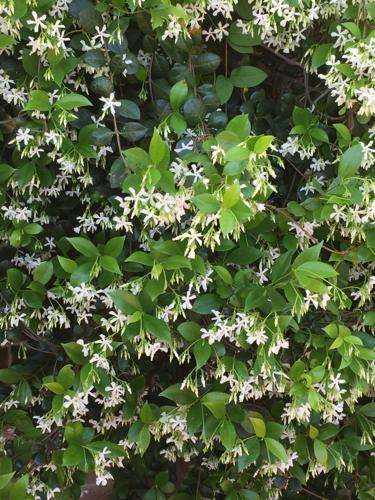
- By Peter L. Warren Special to the Arizona Daily Star
Q: We just installed five viga posts on our back patio. Two of them are where I could plant a vine in the ground; the other three need to be in a pot. Height to the patio roof is about 11 feet. Looking for something I can train to grow up and around the post, but the kind that cling. The area gets morning sun until about 11:30 a.m. and then shade the rest of the day. Flowering, thornless and non-deciduous would be ideal. Would also like to find a vine that I might be able to use along our retaining wall, specifically in the sections that have an iron railing between the stucco posts. This would be full sun most of the day and the height of the iron fence is about 6 feet.
Answer: My first thought is star jasmine because I have it growing at my house and it’s flowering now. It does well in part shade and produces very fragrant flowers in the spring. For the retaining wall, you might consider cat’s claw. This vine loves full sun and will cover a sturdy wall. These are fast growing and need to be managed but most vines are that way to some extent. There are other vines to choose from; search for options at az1606.pdf
Peter L. Warren is the urban horticulture agent for the Pima County Cooperative Extension and the University of Arizona. Questions may be emailed to
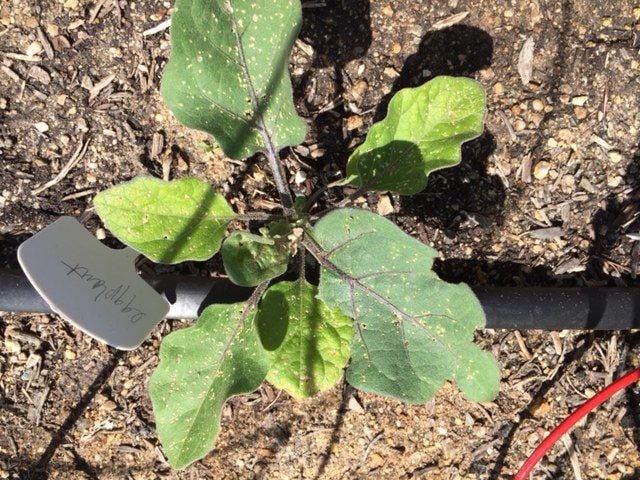
- By Peter L. Warren Special to the Arizona Daily Star
Q: Thanks for the bug lesson last weekend at the Jewish Community Center. Thanks to you, I was able to identify lace bugs on our sunflowers (you predicted they would show up) and I mitigated with blue Dawn. While there, I noticed that our Japanese eggplant have something going on with them. Are you able to help out based on the two images I am including? No insects were visible.
A: Flea beetles are eating your eggplant leaves. They are tiny and hard to see, and they tend to jump like fleas when they sense danger. They are one of the most difficult-to-manage pests of eggplant and cole crops. They are also a problem on seedlings of tomatoes, potatoes, peppers, turnips, radishes and corn. There are various species of flea beetles, all members of the Chrysomelidae family. The adults are active leaf-feeders that can, in large numbers, rapidly defoliate and kill plants. You are seeing the symptoms of adult flea beetle feeding: small, rounded, irregular holes that make leaves look as if they had been peppered with fine shot. Additional damage may be done by the larvae, which feed on plant roots. Some flea beetles are considered general feeders, though many species attack only one plant or closely related kinds of plants. Because of this you can sometimes use anther crop to lure them away. For example, radishes are sometimes preferred over eggplant. Another tactic is to put yellow sticky traps near your plants to attract and capture these insects. Organic products that have some effectiveness are insecticidal soap and neem oil. Pyrethrin products such as Pyganic as well as hot pepper wax and rotenone are reported to be better.
No matter what you choose, the most important things to do are spray them early in the season before they do too much damage to young plants and read the label before you use these products so you are aware of safety precautions for using them.
Peter L. Warren is the urban horticulture agent for the Pima County Cooperative Extension and the University of Arizona. Questions may be emailed to
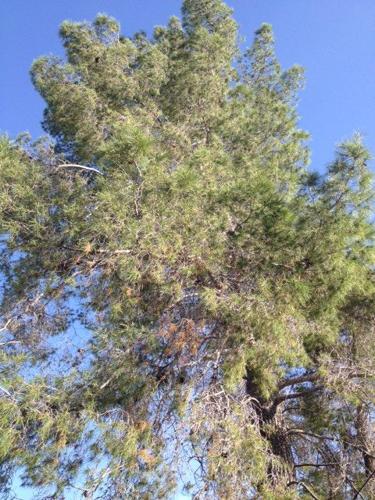
- By Peter L. Warren Special to the Arizona Daily Star
Q: I live in Barrio Santa Rosa and have two massive Aleppos that were planted on my property in the early 1950s. I have noticed recently that many of the lower branches on one of the trees are dying. I am seeing brown needles throughout the tree, but not a lot. These trees have defined our property and it looks like they may have fallen victim to the bark beetle. One of the trees looks fine; the other I can see a dozen of the lowest limbs dead. This one has brown leaves sporadically throughout, but mostly at the bottom, not at the crown.
I have had the entire property on drip for 15 years or more, so I always considered them adequately watered. Also, the gutters from the roof drain into this part of the yard. Any advice you can give me would be greatly appreciated. What I’d really like to hear you say is that they just need a bit more water!
A: Your trees don’t appear to be infested with bark beetles from the photos. The holes look like woodpecker damage and the dead branches in the crown of the tree are normal as the trees age. It would be good to hire an arborist to climb the trees and cut out the dead and damaged branches both to clean it up and also to prevent dead limbs from falling and hurting you or damaging your property. Watering these large trees is difficult because the root zones extend two to three times the height of the tree. You are likely not getting water to the absorbing roots at the end by using a hose. The best you can do is drip irrigation with emitters arranged in a circular fashion outside the drip line of the tree. The schedule for watering should be every seven to 14 days in the summer, every 10 to 21 days in the spring and summer, and every 14 to 21 days in the winter. The water should reach a depth of 24 to 36 inches each time and you can use a soil probe to determine how deep the water is going. So it’s not time to give up
Peter L. Warren is the urban horticulture agent for the Pima County Cooperative Extension and the University of Arizona. Questions may be emailed to
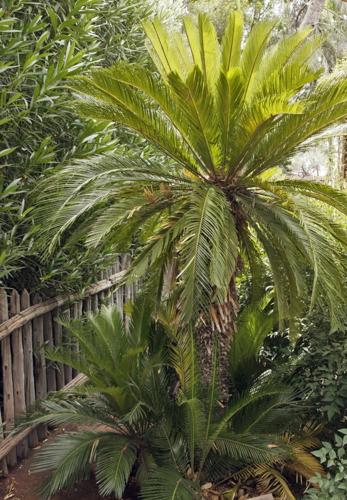
- By Peter L. Warren Special to the Arizona Daily Star
Q: I have Sago and Fan palms with shoots growing out from the base of the plant. Can I remove the shoots and replant them elsewhere? If so, how do I go about removing the shoots?
A: The Sago (Cycas revoluta) is not a true palm, but a cycad. It produces offshoots, sometimes called pups, at the base of the plants. They can be separated using a trowel and transplanted to another location after letting them dry for week or so to seal up the wound.
You might start them in a container in the shade or put some shade cloth over them until they are established if you plant them in the ground. The fan palm shoots are likely growing from seed that fell from nearby trees. These small plants can be moved to other locations by digging them up with the roots and replanting. They typically have small and shallow root systems so it shouldn’t be much trouble while they are young.
Peter L. Warren is the urban horticulture agent for the Pima County Cooperative Extension and the University of Arizona. Questions may be emailed to
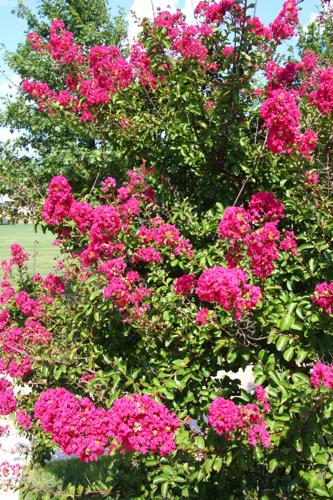
- By Peter L. Warren Special to the Arizona Daily Star
Q: Please tell me how and when to feed and care for crepe myrtle.
A: The crepe myrtle (Lagerstroemia indica) is an interesting woody Asian tree/shrub that grows well throughout the southern US. It does best in a loam/clay soil and needs regular watering.
By this I mean, every 7 to 14 days in the summer to a depth of 24 to 36 inches. In the spring and fall, water every 10 to 21 days and in the winter water every 14 to 21 days.
Fertilization can be done once each spring with a complete fertilizer such as 10-10-10 or you can use organic products such as composted manure. Make sure you water right after you apply the fertilizer.
In any case, a one to two inch layer of bark mulch over the root zone (being careful to keep it away from the trunk) will provide some protection for the roots from hot temperatures and help keep the root zone moist longer.
Some advocate for renovation pruning in the winter (called crepe murder by others) but this is hard on these plants so I recommend minimal pruning to remove dead and broken limbs, crossing and rubbing branches, and shape as needed.
Peter L. Warren is the urban horticulture agent for the Pima County Cooperative Extension and the University of Arizona. Questions may be emailed to
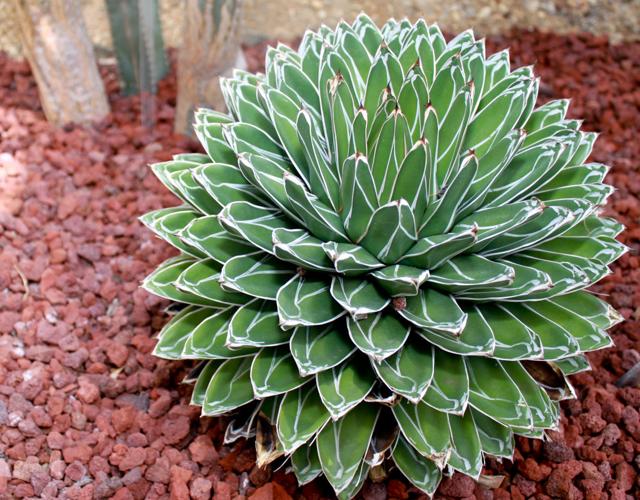
- By Peter L. Warren Special to the Arizona Daily Star
Q: Please tell me the name of this plant. Also if it blooms, will it then die?
A: This is the Queen Victoria agave (Agave victoriae-reginae). According to Greg Starr in his excellent book called “Agaves”, this is a Chihuahuan Desert species. It grows well throughout our area although it doesn’t do as well in the hot sun of the low desert so planting it in a spot with afternoon shade is a good idea. It is a slow growing species and after 20-25 years it will bloom and then die.
Peter L. Warren is the urban horticulture agent for the Pima County Cooperative Extension and the University of Arizona. Questions may be emailed to
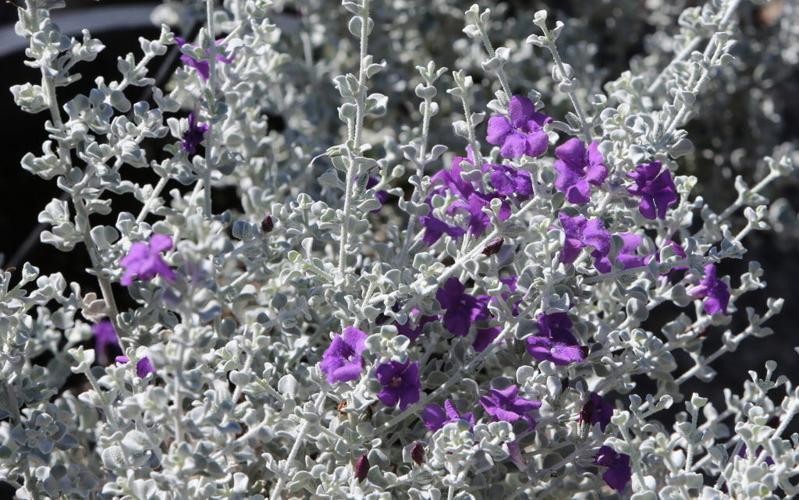
- By Peter L. Warren Special to the Arizona Daily Star
Q: Our HOA of 40-plus years has numerous sheared shrubs and we’re trying to renovate and naturalize as many as we can. I hope you can follow up your tree pruning advice with some on the positive approach of hard pruning or rejuvenating some currently sheared, older and overly large Texas rangers and oleanders.
A: Renovating or rejuvenating older, overly large, or previously sheared shrubs extends the life and improves the aesthetic value of these plants. One method is to cut all stems to about 12-18 inches above the ground.
This is a severe measure and changes the appearance drastically, however, when done in early spring before bud burst, causes a great number of stems to grow just below each cut by mid-summer. At that time, about half of the stems should be removed and the remaining ones should be cut back to different heights.
Varying the height and cutting just above an outward pointing bud will stimulate growth of new branches out of the canopy. According to University of Arizona Horticulture Specialist, Ursula Schuch, this procedure works well for larger fast growing shrubs like Texas ranger and oleander and for slower growing shrubs like hop bush and creosote.
Some shrubs such as cassias, arborvitae, rosemary, and junipers do not respond favorably to this treatment and might die. A less severe approach to rejuvenating shrubs is to remove half or more of the older unproductive branches at the base of the plant or those growing into the canopy. This thins out the plant to a much greater extent than regular maintenance pruning.
Follow-up care requires removing a portion of the new shoots a couple of weeks later, which might be too numerous and result in an overly dense canopy.
A third method of rejuvenation that spans three to four years and is less noticeable requires removing about one third to a quarter of the oldest unproductive branches each year. This method requires thinning excess branches and cutting back the remaining new branches as described before.
A common practice that is not recommended except in the case of formal hedges and topiaries is shearing. Shearing shrubs means cutting back branches to a uniform surface using heading cuts. We see all sorts of examples in our area where shrubs have been sheared to resemble beer can and meatball shapes. It doesn’t just look weird; it’s bad for other reasons.
The maintenance costs for sheared shrubs increases because they require repeat shearing more frequently than they would need regular pruning and they use more water to recover from this harsh treatment. Shearing stresses plants and can result in decline or death.
Peter L. Warren is the urban horticulture agent for the Pima County Cooperative Extension and the University of Arizona. Questions may be emailed to
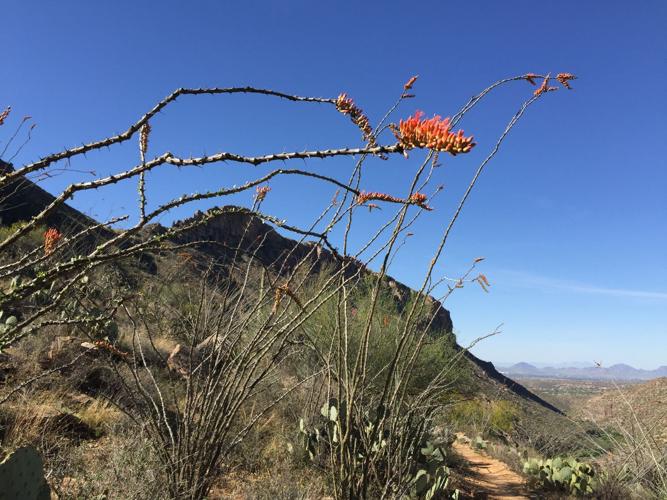
- By Peter L. Warren Special to the Arizona Daily Star
Q: We live in Tucson and I have a question about an ocotillo we have had for about 10 years. It is watered with drip irrigation, and compared to other ocotillos in our neighborhood, leafs out when they do. It has grown well, is probably 15 feet tall with multiple arms. I have never pruned it; I have just left it alone. One thing that has puzzled me — it has never bloomed. There is one other in our neighborhood that hasn't bloomed, but all the others, including ones that are significantly smaller, bloom every spring. From what I have read online, ocotillos should do well with low maintenance, and ours has seemed healthy in every other way except for blooming. Any hope in that department?
A: I agree that ocotillos do well with little or no maintenance. The first cool rain in the spring of 10mm or more triggers flowering in ocotillos according to Bowers and Dimmitt (1994). Another factor that affects flowering is temperature. The temperature shouldn't be a problem in Tucson so maybe your ocotillo isn't getting enough water. You could provide supplemental water but not too much because that would be bad for the plant. Desert plants like the ocotillo can get by with watering every two weeks in the summer and every three weeks in the spring and fall. No irrigation is required in the winter. Flowering generally occurs between March and May although some bloom in the fall.
Peter L. Warren is the urban horticulture agent for the Pima County Cooperative Extension and the University of Arizona. Questions may be emailed to tucsongardensage@gmail.com
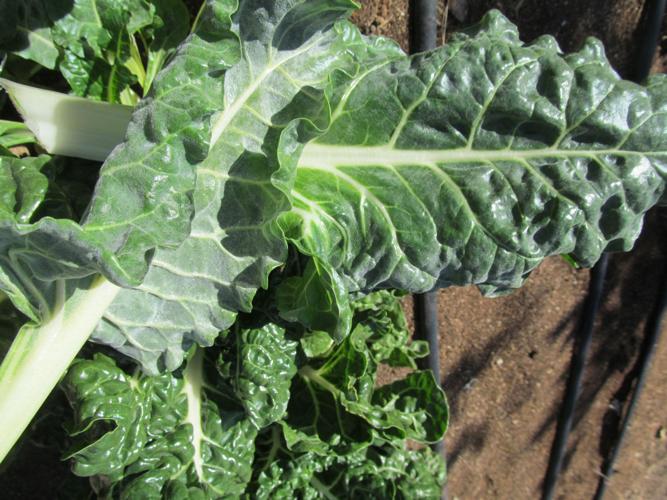
- By Peter L. Warren Special to the Arizona Daily Star
Q: My overwintering chard has started to show a "white powdery" substance covering both front and backsides on some of the leaves. Photos are attached comparing normal and white powdery leaves on the chard plants. Any idea what this substance is and are the chard leaves still edible?
A: It looks like powdery mildew. Left alone it can kill the leaves. The organic solution is to spray it with a baking soda and water mixture. There are also conventional fungicides labeled for use on vegetables available if you are okay with that. The mildew washes off and cooking will take care of the fungus so the leaves should still be edible. Make sure your plants have enough room for air circulation to prevent this in the future.
Peter L. Warren is the urban horticulture agent for the Pima County Cooperative Extension and the University of Arizona. Questions may be emailed to tucsongardensage@gmail.com
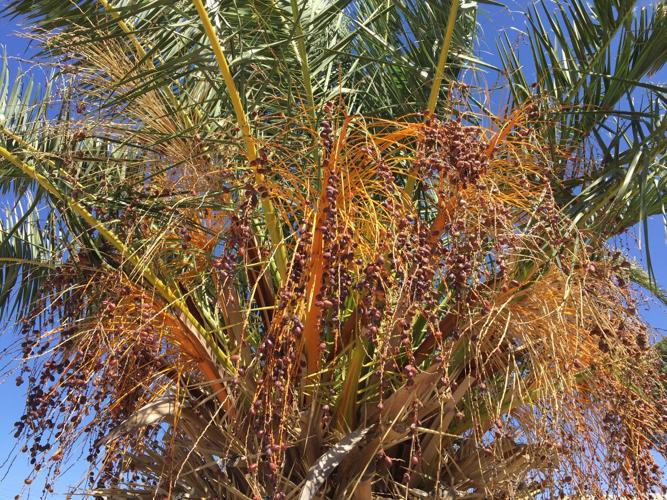
- By Peter L. Warren Special to the Arizona Daily Star
Q: I have several palm trees that produce clumps of seedpods each year. Right now they are yellow and will turn dark burgundy. Should I cut these seed pods off now before they mature? If not, when should I do it?
A: The reason to cut off the pods now would be to avoid having them drop the debris on the ground and to generally clean up the crown of the trees. Some people clean up their trees annually and others let them drop the seed. It is really up to you. The tree doesn't suffer from a light pruning each year and now is a fine time to do it.
Peter L. Warren is the urban horticulture agent for the Pima County Cooperative Extension and the University of Arizona. Questions may be emailed to tucsongardensage@gmail.com
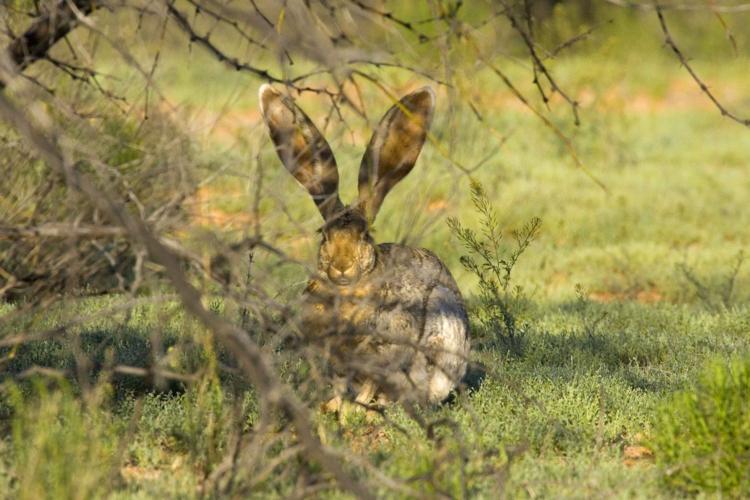
- By Peter L. Warren Special to the Arizona Daily Star
Q: We moved into our home in 1970, and there was a small grapefruit tree growing in the back yard. We don't know how old the tree is, but it is healthy and always produces hundreds of delicious grapefruit every year. Today I noticed that a cottontail rabbit was under the tree eating some of the leaves. There are a lot of cottontails in our neighborhood, but I didn't know that they eat grapefruit leaves. In the summer I always see a few damaged leaves in different places in the tree, but I thought that was caused by a leafcutter. My question is: what can I do to keep rabbits from eating the leaves?
A: Fencing is really the only prevention for keeping rabbits and other four-legged creatures away from desirable plants. If that isn’t an option you might consider doing nothing. Since your tree seems to be doing fine producing so much fruit and because rabbits can't climb trees, I recommend letting them eat the low hanging leaves. Most plants can tolerate some defoliation and still remain healthy and produce flowers and fruit. I would say the same thing about leaf-cutter bees. They only cause cosmetic damage to the tree.
Peter L. Warren is the urban horticulture agent for the Pima County Cooperative Extension and the University of Arizona. Questions may be emailed to tucsongardensage@gmail.com.
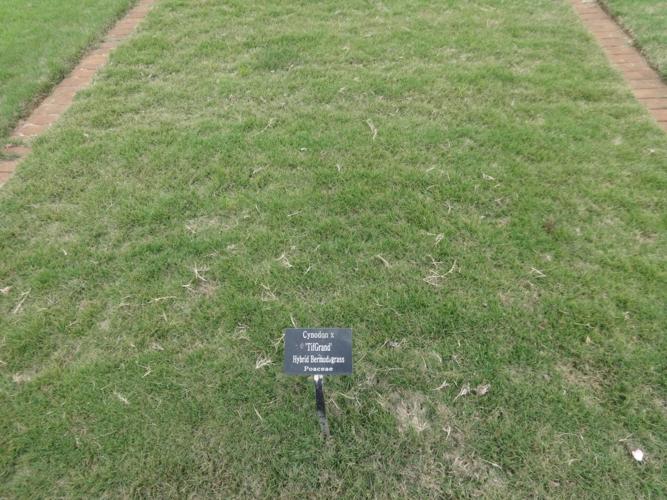
- By Peter L. Warren Special to the Arizona Daily Star
Q: I reside in Scottsdale and I was curious to find out — realistically, how long does a Bermuda grass lawn stay nice and not overrun by weeds, dry patches, and so on before eventually needing to replace it with new sod?
A: The time it takes really depends on the care you are able and willing to give to the grass. Proper mowing, dethatching, fertilizing, irrigating, and pest management are the basic components of a lawn management program. Proper mowing means using a sharpened mower and adjusting it to the best height. This would be somewhere between a half inch to 1 1/2 inches depending on the variety. Mowing is best done on a schedule that keeps up with the growth of the grass. Just like other plants, you don't want to take off too much at one time (one third off the top is a good rule of thumb). Dethatching is something done as needed when the thatch, the spongy layer of plant material between the soil and the green parts of the grass, becomes thicker than half inch. You might need to rent a vertical mower or power rake to do this job. Fertilization with half pound of nitrogen fertilizer per 1,000 square feet each month during the growing season (April through September) promotes good vegetative growth. Make sure you water your lawn after you fertilize. How often you water after that depends on the weather. Typically, every three days to a depth of six to eight inches is good for the summer. This can be reduced if we have significant rain. If you keep up with all of this, the pest problems will be less because healthy grass is likely to shade out weeds and be more tolerant of insects and diseases. Overall, Bermuda grass is a tough plant that does well given the right conditions.
Peter L. Warren is the urban horticulture agent for the Pima County Cooperative Extension and the University of Arizona. Questions may be emailed to tucsongardensage@gmail.com.
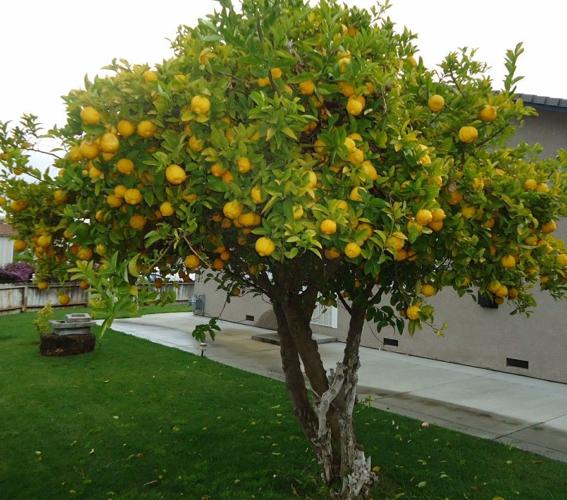
- By Peter L. Warren Special to the Arizona Daily Star
Question: I have a lemon tree that we planted three years ago. It is not growing well. It is next to an adult California pepper tree. (10 feet away) I would like to dig it out and transfer it. Are there any concerns or special care doing this?
Answer: Ten feet away from another tree is likely too close and the California pepper tree is known for its competitive roots so I am glad you are thinking of moving the lemon. One of the first things to consider when planting is the mature size of the tree so there will be plenty of room between the tree and anything else. There are some basic guidelines when transplanting. Moisten the area where you intend to plant a few days prior to digging to make it easier. Dig the planting hole twice as wide but only as deep as the root ball. The edges of the excavated area should be rough and sloping. A shallow hole prevents the tree from sinking and burying the trunk. One of the most common mistakes is planting too deep. Since your tree has already been in the ground for three years the roots will be growing. You may have to prune some of them back to extract it from the original planting hole. This is a good opportunity to check the root system for matted or circling roots. If needed you can cut and separate roots that are circling or heading in the wrong direction. Place the tree carefully into the planting hole. Remove just enough soil from the top of the root ball to expose the root collar, which should be level or slightly above the surrounding soil. The root collar is where the trunk flares out just above where the roots begin.
Backfill the planting hole with native soil. There is no need to add amendments. Studies show there is no advantage to mixing compost or other organic amendment into the soil. If hand watering or using bubbler irrigation, form a berm just outside the root ball to create an irrigation well. Apply water within this area. As the tree grows, expand the well. If using a drip system, use two or three emitters to wet this same area. Increase the number of emitters and spread them out to stay in line with the edge of the crown as the tree grows. Set your irrigation schedule to supply water every seven to 10 days in the summer and make sure the water reaches a depth of 36 inches. Apply a two to four inch layer of mulch to the entire tilled area. Keep mulch away from the trunk.
Peter L. Warren is the urban horticulture agent for the Pima County Cooperative Extension and the University of Arizona. Questions may be emailed to tucsongardensage@gmail.com.
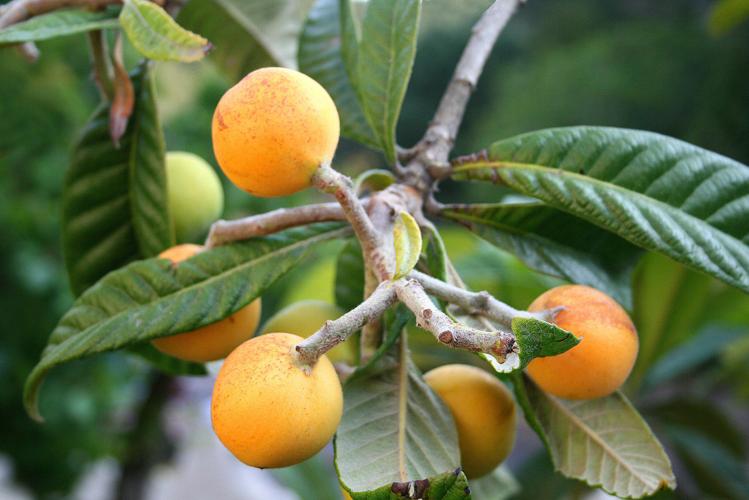
- By Peter L. Warren Special to the Arizona Daily Star
Q: Every gardener has a "great white whale," and mine is the loquat. I have already killed two of them ... one due to insufficient watering, and one for reasons unknown. The third is in a pot, so I can move it if it gets too sun scalded. I'd like to plant it permanently, but don't know what the specific requirements are for it to grow successfully here. Mesquite Valley Growers told me it can't grow in full sun, and Civano showed me theirs...in full sun! Can you help me?
A: Loquats may be grown easily in full sun in some places such as coastal California and there are probably some microclimates in our area where they do fine in full sun. In general, in the Sonoran Desert they do best with western sun protection and in partial shade. Newly planted loquats even benefit with eastern sun protection from a shade structure until they are established. The leaves tend to suffer in extreme heat and fruit can be damaged as well. The trunk may suffer from sun scald if planted in full sun so it’s not a good idea to prune them in that situation and instead, allow the branches to grow down to protect the trunk. Loquats grow well on a variety of soil types but need good drainage and will not tolerate standing water. While they are drought tolerant, they will produce higher quality fruit with regular, deep watering. The deep watering allows the roots grow deeper and it helps wash salt that accumulates through the root zone. This means you should water every seven to 14 days during the summer, every 10 to 21 days in the spring and fall, and every 14 to 21 days in the winter. Loquats benefit from regular, light applications of a complete fertilizer but too much nitrogen will reduce flowering. Composted manures and other natural fertilizers that contain less salt are good alternatives. Micronutrient deficiencies are sometimes a problem so keep an eye on the leaves for symptoms. If you still have problems, please let me know before you shout, "Thus, I give up the spear!"
Peter L. Warren is the urban horticulture agent for the Pima County Cooperative Extension and the University of Arizona. Questions may be emailed to tucsongardensage@gmail.com.
- By Peter L. Warren Special to the Arizona Daily Star
Q: I was in a shopping center yesterday and watched a landscape crew trimming the trees, if trimming is the word for what they were doing. I know little about the subject, but why would they cut so far back? There must be some good reason. We don’t get hurricanes, so that isn’t it.
A: There is no good reason for what was done to those trees. The pruning style is called tree topping and it is simply bad for the trees. Trees require a large leaf surface area to provide food for maintenance and growth.
Topping cuts off a major portion of the food making potential and depletes the stored reserves. While removing most of the buds that would form a normal branch system, topping often stimulates the regrowth of dense, unattractive, upright branches (water sprouts) just below the pruning cut. Water sprout regrowth is vigorous. A topped tree will rapidly return to its original height, but will lack its original form.
The branch wounds left from topping are slow to close, therefore more vulnerable to insect attacks and fungal decay. An invasion by either pest can spread into the trunk, killing the tree. Weakened stubs are more prone to wind and storm breakage because they generally begin to die back or decay.
Increased sun exposure on trunk and branches can lead to severe bark damage. Ugly branch stubs, conspicuous pruning cuts, and a broom-like branch growth replace natural beauty and form.
Topping reduces the real estate value of trees by 20 to 100 percent. A correctly trimmed tree increases in value at each pruning. If tree workers suggest topping, I would hire somebody else. I recommend using ISA Certified Arborists whenever possible to assure that your tree workers have received the proper training and passed an exam on the topics most critical to good tree care.
Peter L. Warren is the urban horticulture agent for the Pima County Cooperative Extension and the University of Arizona. Questions may be emailed to tucsongardensage@gmail.com
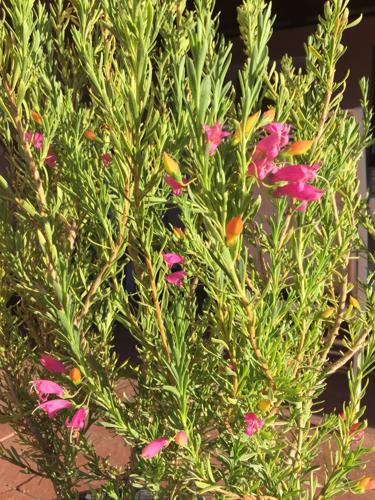
- By Peter L. Warren Special to the Arizona Daily Star
Q: I had an Eremophila racemosa for about three years until last week when it just dried up and died on me. I don’t know what happened. Is there some kind of insect that could have killed my bush? Also I would like to know about removing a stump from a tree that was cut down last year. I remember reading in your Sunday articles about how to remove a stump with some kind of natural items.
A: The emu shrub (Eremophila racemosa) is a desert-adapted plant from Australia. These plants are relatively free of insect pests, so I suspect that lack of water was the cause of its demise. In the summer, it is best to provide water every 7 to 14 days to a depth of 24 to 36 inches. In the spring and fall you can adjust your irrigation to water every 10 to 21 days and in the winter, every 14 to 21 days.
Stumps will naturally degrade in the soil. Depending on the size of the roots and the nature of your soil, it may take years to completely decompose. Fortunately for us, warmer soil temperatures are one factor that speeds up the process.
Other factors than can speed up the process include aerating the soil around the stump, irrigation of the stump as long as the water doesn’t accumulate, adding a small amount of nitrogen fertilizer and a layer of compost will help provide the microorganisms that break down the stump, and drilling holes in and/or scaring the stump and above ground roots provides access to fungi and bacteria that will aid in the process.
Peter L. Warren is the urban horticulture agent for the Pima County Cooperative Extension and the University of Arizona. Questions may be emailed to tucsongardensage@gmail.com
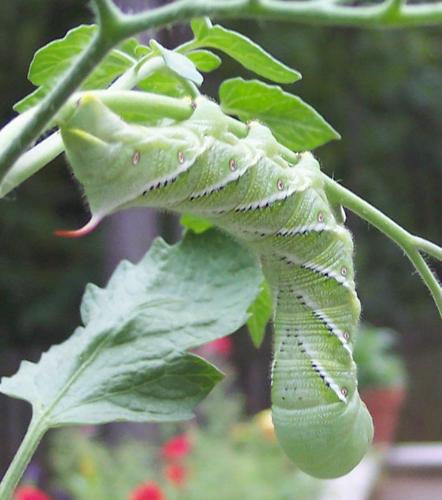
- By Peter L. Warren Special to the Arizona Daily Star
Q: We have several different types of trees in our yard that have for the past three to four years been infiltrated by those large green hornworms. It is a complete puzzle to us where they come from, as we have no tomato plants or vegetable garden of any kind, and also why they keep showing up every year.
My husband has sprayed the trees with a solution that usually causes the worms to fall to the ground and thereby easy to find and dispose of, but why are we having this problem year after year and what can we do to avoid it? The trees we find them in are ash and willow. Any advice you can give would be appreciated.
A: The hornworm caterpillars you are finding are related to the tomato hornworm but not necessarily the same species. Tomato hornworms feed on potato, tobacco, tomato, and other plants in the nightshade family (Solanaceae). Other species of hornworms will feed on other plants such as your trees.
The sphinx or hawk moth family (Sphingidae) to which the hornworms belong includes about 125 species in North America. Around 40 or so of these can be found in Pima County. They are called hornworms due to the conspicuous horn on the back end of their abdomen and that is a clue that helps identify them as members of this family.
The adult moths, which are excellent flyers, lay eggs on their host plants, often at night. These caterpillars are not considered to be pests on trees since trees can handle some defoliation without any adverse affects. The caterpillars are also a good food source for birds so you can leave the pest management to them and save yourself some time and money on the insecticides.
Plus, I am guessing you don’t want the birds to eat caterpillars laced with insecticides. There is no practical way to avoid this situation in the future. You like your trees and the caterpillars have to eat.
Peter L. Warren is the urban horticulture agent for the Pima County Cooperative Extension and the University of Arizona. Questions may be emailed to tucsongardensage@gmail.com
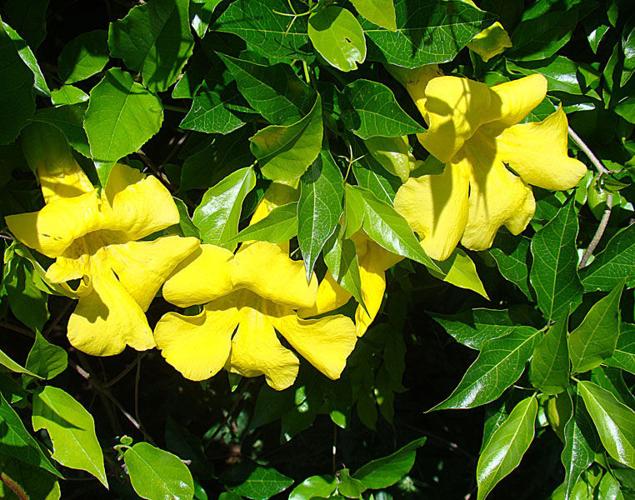
- By Peter L. Warren Special to the Arizona Daily Star
Q: I have a question about planting Cat Claw vines next to my stucco home. Will it damage the stucco?
A: It doesn't damage it per se although it does sometimes make a stain on the stucco. If you are okay with that then it has a decent reputation in the Southwest as an easy-to-grow vine. People from more humid regions such as Florida and Louisiana have a terrible time controlling this plant and consider it an invasive weed.
Peter L. Warren is the urban horticulture agent for the Pima County Cooperative Extension and the University of Arizona. Questions may be emailed to tucsongardensage@gmail.com
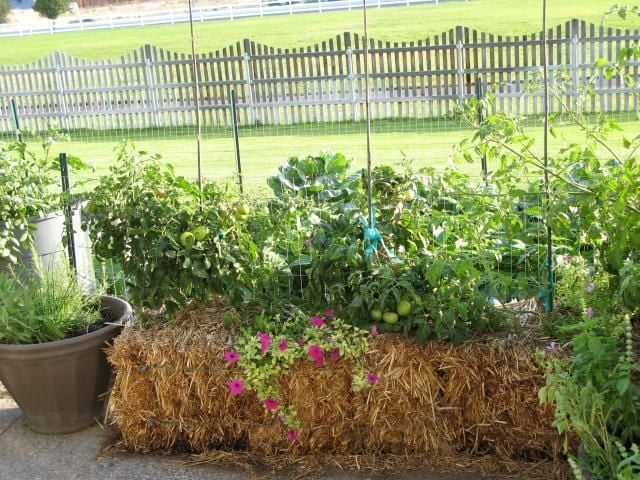
- By Peter L. Warren Special to the Arizona Daily Star
Q: I am considering adding straw bales for growing my spring/summer vegetables and the initial treatment required for wetting the bales, adding Nitrogen as part of the preparation for microbial breakdown of straw materials during a two-week period. I read two online extension articles that stated straw bales with the right amount of moisture and outside temperatures may burn. Are you aware of any "spontaneous combustion" that has ever occurred using single straw bales either placed in a row or individually?
A: Straw bale gardening is a nice way to avoid growing in our poor soil, fighting off garden weeds, and preventing some joint and back pain by having a raised area to garden. Spontaneous combustion is a problem for hay stacked in large piles. Single bales used for gardening are not likely to generate enough heat for combustion.
Peter L. Warren is the urban horticulture agent for the Pima County Cooperative Extension and the University of Arizona. Questions may be emailed to tucsongardensage@gmail.com
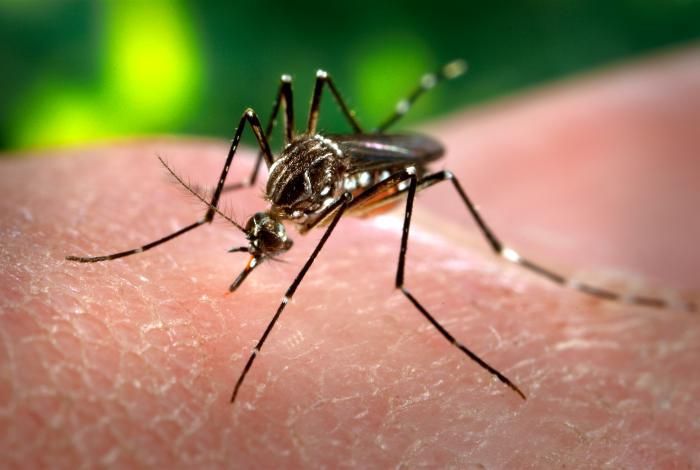
- By Peter L. Warren Special to the Arizona Daily Star
Q: I’m concerned about the recent news stories about new diseases such as the Zika virus spread by mosquitoes. I spend a good amount of time outdoors gardening and mosquitoes usually bite me. Are there any things I can do to prevent this problem?
A: Zika virus is transmitted to people primarily through the bite of an infected Aedes mosquito. These are the same mosquitoes that spread dengue and chikungunya viruses. Aedes mosquitoes prefer to live near people and only female mosquitoes bite. They are mostly daytime biters, but can also bite at night. Mosquitoes acquire the virus when they feed on a person during the first week of infection when they are carrying high numbers of Zika virus in their blood. Once inside the mosquito, the virus moves from the digestive tract into the salivary glands, a process which is thought to take about a week. After that time, the mosquito can spread Zika to the next person she bites. Zika virus can also be transmitted from mother to her fetus during pregnancy, through blood transfusions, and through sexual contact.
The best way to avoid getting Zika virus or other diseases spread by mosquitoes is to avoid being bitten by infected mosquitoes. We can minimize mosquito numbers by eliminating breeding habitats, for example, standing water in containers around our homes. When outdoors, dress properly and apply insect repellent. Here is a link to a publication on choosing repellents: extension.arizona.edu/sites/extension.arizona.edu/files/pubs/az1311.pdf
Other things you can do include the following.
• Switch to LED lights to be used outdoors - these are not attractive to mosquitoes because they have no ultraviolet spectrum.
• Place fine mesh over rain barrels to prevent egg laying.
• Repair screens for windows that may have developed holes.
• Repair leaky pipes and faucets.
• Mosquito dunks for ponds, birdbaths, and other water features with standing water.
What doesn't work - electronic bug zappers and high frequency repellent devices.
Peter L. Warren is the urban horticulture agent for the Pima County Cooperative Extension and the University of Arizona. Questions may be emailed to tucsongardensage@gmail.com

- By Peter L. Warren Special to the Arizona Daily Star
Q: I am getting some strange damage on my palo verde tree bark. Do you have any idea what could be causing this damage?
A: Woodpeckers are likely damaging your tree. These birds seek insects to eat that may be on the bark or just under the surface. In some cases, pecking holes in the bark causes sap to flow and attracts insects for the birds to eat later. Because federal law protects most birds, the management of bird damage is limited to exclusion, frightening/repelling, and distraction. Exclusion can be accomplished with hardware cloth or other screens over the area to be protected. Frightening can involve sound or shiny materials that cause the birds to avoid the area. Distraction can be accomplished by providing another food source such as a suet feeder nearby that is more attractive than the tree.
Peter L. Warren is the urban horticulture agent for the Pima County Cooperative Extension and the University of Arizona. Questions may be emailed to tucsongardensage@gmail.com
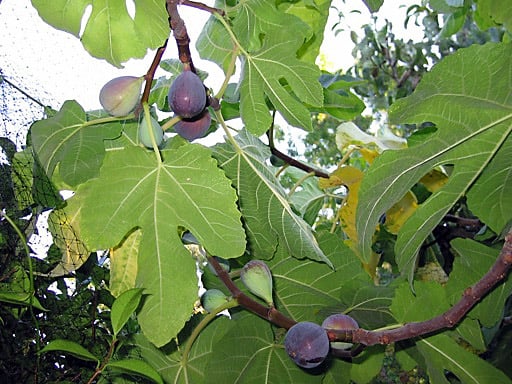
- By Peter L. Warren Special to the Arizona Daily Star
Q: I planted a fig tree for three years in a row and cannot seem to keep them alive. I do not know what I am doing wrong. I live in Catalina, north of Tucson, a little cooler area and my soil is sandy.
A: Figs are certainly a good plant for our area. Some basic things to consider include allowing enough room for them to grow to a mature size, planting them in well-drained soil, and planting them in the fall or early spring to allow them to get established before the hot summer weather. The two varieties that do well here are the brown turkey fig and the black mission fig. Irrigation should be scheduled every week during the summer and every two weeks in the spring, fall, and winter. Light fertilization can be applied during the growing season (May, June, and July). Split a half-pound of nitrogen fertilizer between those three months and water in after applying. If you are seeing other specific symptoms related to the death of your figs, please let me know so we can puzzle them out.
Peter L. Warren is the urban horticulture agent for the Pima County Cooperative Extension and the University of Arizona. Questions may be emailed to tucsongardensage@gmail.com

- By Peter L. Warren Special to the Arizona Daily Star
Q: I know this is kind of a stretch, but I got your email off an answered question about caring for a cactus on a website. I bought a cactus in Japan (I'm stationed over here) and I have a couple questions. First is it normal to have that discoloration around the base and arms? Also, what kind of cactus is this? I just want to make sure I'm doing everything for it so it can survive!
A: Your plant is a type of Euphorbia. These plants are in the Euphorbiaceae family rather than the cactus family Cactaceae. They are often confused for cacti due to the spines and general appearance. The browning is a function of age and not anything wrong with the plant. Caring for this plant is similar to what you would do for cacti. Make sure it is in well-drained soil and water once a month if kept indoors in a container. The hot desert sun would be too much and I would recommend indirect sunlight, but in other locations where it’s not so hot make sure it gets plenty of sun. A water-soluble complete fertilizer can be used at a quarter strength monthly during the growing season. Avoid fertilizers that are high in nitrogen.
Peter L. Warren is the urban horticulture agent for the Pima County Cooperative Extension and the University of Arizona. Questions may be emailed to tucsongardensage@gmail.com.
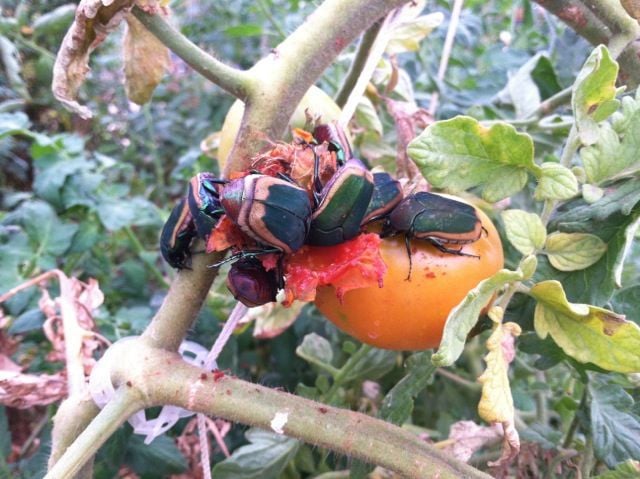
- By Peter L. Warren Special to the Arizona Daily Star
Q: My grape arbors are full of these bugs — hundreds of them eating my figs and grapes. I’ve never seen anything like this before. I shake the grape arbors and swarms fly out. Is there something we can do? Help! Attack of the June bugs!
A: They are sometimes called June bugs based on the time of year we see them. Today they are called March bugs. They are also called fig beetles (Cotinis mutabilis) and their white grubs are often found in the soil as people prepare their garden beds for planting. As adults, they can be managed with conventional insecticides, assuming this is not an organic operation. There are a variety of insecticides that work well and are labeled for use on grapes and figs. The problem is the beetles can fly and when there are large numbers of them it requires repeat treatments. So you can’t really stop them, you can only hope to contain them. There aren’t any great organic solutions for the adults unless you count the two brick method. Insecticides should not be sprayed while plants are blooming to conserve our valuable pollinators.
Peter L. Warren is the urban horticulture agent for the Pima County Cooperative Extension and the University of Arizona. Questions may be emailed to tucsongardensage@gmail.com.

- By Peter L. Warren Special to the Arizona Daily Star
Q: I see these red bugs on the new growth of my Texas mountain laurel. It did not bloom last year and it was suggested that I am not watering enough. So I have been and now I have these guys. I don’t know if you can see in the picture but there is clear sap all around as well. I am thinking these are not beneficial? What should I do? They appear to be doing a lot of damage to new growth, so I am going to use a soap mixture to deal with them.
A: These red bugs (Lopidea major), also known as the sophora plant bug or mountain laurel bug, are relatively harmless although not beneficial. They will suck some sap and do minor aesthetic damage to the new growth for a short time in the spring. They will not do enough damage to justify spending time and money managing them. Insecticidal soap is a good solution as an irritant for small soft-bodied insects and may disrupt their feeding activity. If your soap solution doesn't work as you hope and you are determined to manage them, you might try an organic pyrethroid product called Pyganic that is more effective against plant bugs of this order.
Peter L. Warren is the urban horticulture agent for the Pima County Cooperative Extension and the University of Arizona. Questions may be emailed to tucsongardensage@gmail.com
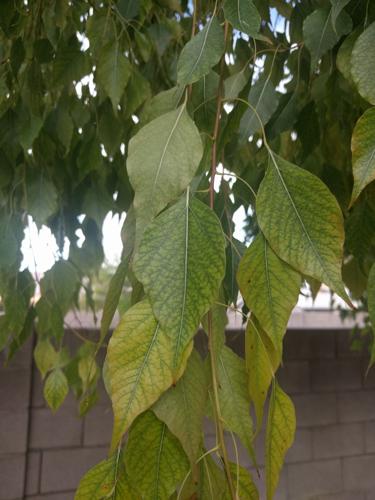
- By Peter L. Warren Special to the Arizona Daily Star
Q: I recently moved to a house in Phoenix, and am trying to understand the various plants in my yard. I have a couple trees that drop pods, which are very hard and dry when they fall (I haven’t seen them on the tree yet). The tree itself is deciduous, with sturdy branches extending from the trunk and “weeping,” vine-like branches that contain the leaves. Does anyone have any idea what this tree is? If so, are the pods edible?
A: Your trees are called bottle trees (Brachychiton populneus). This is an Australian native that does well here and averages 30 feet tall and wide at maturity. It isn’t supposed to be deciduous, so if it is dropping leaves unexpectedly, there could be a problem. The leaf photo you sent shows a nutrient deficiency, and that could cause the trees to drop leaves.
Make sure you are giving it proper fertilization and irrigation to remedy the leaf symptom. Since it is a relatively large evergreen tree, it is popular for producing shade. However, its size makes it too big for small landscapes and more appropriate for parks. The pods are not edible and might be the downsides of these trees if you use a reel lawn mower, walk around in bare feet, or don’t like picking them up. This species is susceptible to Texas root rot, and should not be planted in areas where this disease is known to occur.
Peter L. Warren is the urban horticulture agent for the Pima County Cooperative Extension and the University of Arizona. Questions may be emailed to tucsongardensage@gmail.com
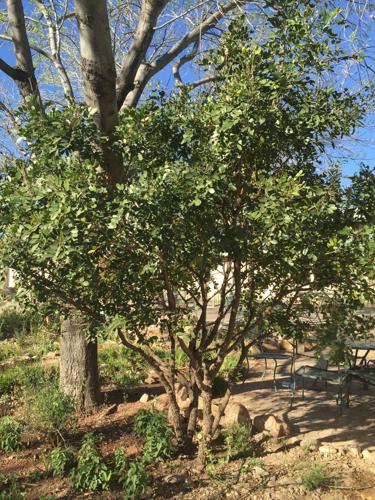
- By Peter L. Warren Special to the Arizona Daily Star
Q: Several months ago, I planted a Sophora secundiflora in a well-prepared, well-drained spot. When I purchased the plant, I asked about watering and was told, “Don’t let it dry out.” The shrub had what I considered a poorly developed root system. I used a 2-inch layer of pea-sized gravel for mulch. About a month after it was planted, I noticed yellowing of the leaves. Thinking this might be chlorosis, I looked for causes of this on the Web. The one that kept coming back up was overwatering. So I decreased watering. Now I am thinking it was not chlorosis, and withholding water was a bad idea. The buds at the base of the leaf petioles still seem hydrated, as do the twigs and stems. Any ideas on what I should or should not do to ensure this shrub survives?
A: Texas mountain laurel is a drought-tolerant species native to the Southwest and requires well-drained soil and infrequent watering. During the first year after it is planted, it can be watered once a week. After that, it is best to change your irrigation schedule to once every 14 to 21 days except for winter, when you can stop irrigating until spring each year. Unfortunately, the symptoms of overwatering can look like underwatering, so it’s understandable how you could mistake one for the other. Transplanting stress may also be a factor in the first year and show up the same way. Many plants purchased in containers have greatly reduced root systems, so some of that is expected. The important thing is to provide good care while the tree becomes established. Time will tell if your tree will survive. It may just drop the yellow leaves and releaf.

- By Peter L. Warren Special to the Arizona Daily Star
Q: I know that I and many other readers of the Star would really appreciate advice from you about what to plan regarding cutting back bushes this year. Normally, we would have been thinking no later than mid-March, but with this goofy hot weather we’re having, normal-year planning seems irrelevant. Help, o Garden Sage!
A: Pruning damaged or dead wood may be done anytime, but as you know, we recommend waiting for warm weather for cold-sensitive plants. Pruning for other reasons such as structure, shape and size is typically done with the idea of minimizing stress to the plants, and that is usually accomplished in the cool part of the year, so your mid-March deadline makes sense. With tougher plants, that deadline can be extended into the warmer months. Some plants, however, are pruned with blooming in mind, and timing depends on when each species produces flower buds. We have a pruning calendar you can access on the Internet that has more details (search for az1499.pdf). Regarding the unusual weather this year, it is easy to see how our unseasonably warm weather lately might give us a false sense of security and/or fear about the days and weeks ahead. Our UA climate science specialist, Mike Crimmins, reminds us that it is still technically winter, and the volatile weather patterns we have been seeing this year are difficult to predict. We are still hoping that El Niño will send some rain our way in March. Crimmins says that would reduce the freeze risk since the moisture helps keep overnight temps up. So with all the uncertainty, the best plan would be to stick with the mid-March plan for pruning and starting tender annuals outdoors.
Peter L. Warren is the urban horticulture agent for the Pima County Cooperative Extension and the University of Arizona. Questions may be emailed to tucsongardensage@gmail.com

- By Peter L. Warren Special to the Arizona Daily Star
Q: About four to five years ago, I planted an oak tree in my front yard. ... As yet, it has not grown, I don’t think, 1 inch. It does get leaves every year, but that’s it. What can I do to help it grow?
A: Trees transplanted to a new location typically take a couple years to adjust to their new surroundings. A big part of the adjustment is growing new roots, which are usually drastically pruned and damaged in the transplanting process. Since the below-ground root growth is not obvious to us above-ground animals, it appears that nothing is happening for quite a while. The rule of thumb is: The first year they sleep, the second year they creep, and the third year they leap. This growth pattern assumes the tree was planted in a suitable location and the care was appropriate. Care, once established, includes annual fertilization with a complete fertilizer and regular irrigation. For an oak tree that is not a native desert species that means watering to a depth of 24 to 36 inches every seven to 14 days in the summer, every 10 to 14 days in the spring and fall, and every 14 to 21 days in the winter. The emitters for your drip irrigation system should be placed in a ring around the tree at or near the edge of the tree canopy so the water will reach the absorbing roots. You can also put a half-inch of compost on top of the soil around the tree root zone and an inch or two of organic mulch on top of the compost. The slow release of nutrients from these as they decompose, along with their protection of the root zone, can help keep your tree healthy.
Peter L. Warren is the urban horticulture agent for the Pima County Cooperative Extension and the University of Arizona. Questions may be emailed to tucsongardensage@gmail.com
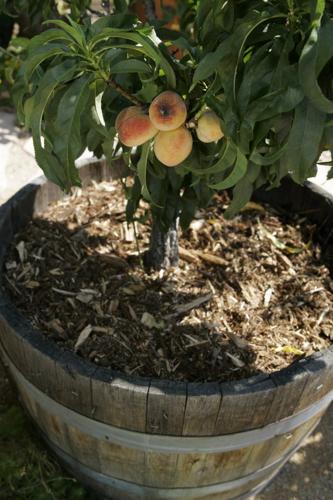
- By Peter L. Warren Special to the Arizona Daily Star
Q: I would like to know when and how and what type of fertilizer I should use for plum, apricot, peach and fig trees. My trees are 2 to 3 years old.
A: Once established, fruit trees need to be fertilized each spring to ensure that new healthy growth occurs and fruit will be large and tasty. For trees of 2 to 3 years of age, you can use 3/4 of a pound of a complete fertilizer that contains nitrogen, phosphorus and potassium. Spread the fertilizer evenly under the tree near the edge of the crown of the tree, also known as the drip line where rain falls and your drip irrigation should be installed. Timing your irrigation to coincide with fertilization will help the fertilizer reach the roots and protect the roots.
Peter L. Warren is the urban horticulture agent for the Pima County Cooperative Extension and the University of Arizona. Questions may be emailed to tucsongardensage@gmail.com
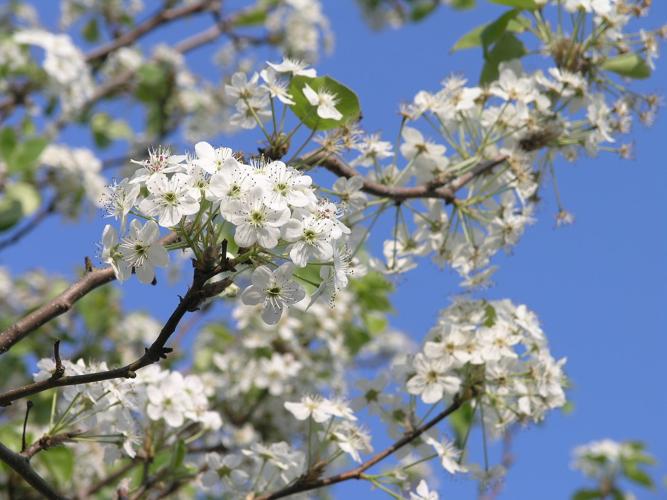
- By Peter L. Warren Special to the Arizona Daily Star
Q: There is a tree in bloom outside my office and I’m wondering what it is. It has white/green blossoms and looks like a pear tree but doesn’t smell like a fruit tree. It sort of smells like sewage. The smell is similar to a carob tree, but more so. I tried to find it online by googling smelly blooming trees and I think it might be a callery pear.
A: You are correct. The tree in question is a callery pear (Pyrus calleryana). These are ornamental pear trees bred to produce flowers and not edible fruit. They became very popular in the last quarter of the 20th century and can be found in many cities and towns as a street tree. The variety most seen is ‘Bradford’ although there are at least a couple dozen others. The flowers have an unfortunate odor as you noticed and are best observed at a distance. Another unfortunate feature of Bradford pears is their branch structure. The tendency for branches to grow from the trunk at sharp angles predisposes these trees to break in high winds. The one thing this tree has going for it is resistance to fireblight, a disease that affects other pear trees. The newer varieties have been bred for better features but fireblight continues to be a concern.
Peter L. Warren is the urban horticulture agent for the Pima County Cooperative Extension and the University of Arizona. Questions may be emailed to tucsongardensage@gmail.com

- By Peter L. Warren Special to the Arizona Daily Star
Q: How can I keep the mice out of my compost? One of the most terrible days of my life was last fall when I used a sharp-bladed shovel to dig out last year’s compost pile. Suddenly and unexpectedly I heard the shrill and amazingly loud screaming of mice. As I quickly removed my shovel I saw with horror that it had sliced a mouse nest in half, decapitating, killing, and wounding three of the blind, hairless baby mice. The two unharmed baby mice I put back in the compost where they were soon rescued by the parents. But I never want to have that experience again.
After the catastrophe, I got rid of my old compost bin that used to sit on the ground and replaced it with a plastic bin raised up 2 feet from the ground on metal legs. I used metal mesh to seal the base of the bin in case mice could actually climb up the slippery metal legs, and this I thought would keep the mice away from my delicious kitchen scraps. Now, two months later I again see small gray mice inside the compost bin. It is winter and they want to be warm and not hungry, but I dread what will happen in the early summer when I want to use that compost in my garden. Any ideas of how to avoid another mouse tragedy?
A: It is difficult to keep rodents out of anything. If you weren’t so concerned about the mice, I would recommend snap traps baited with peanut butter near the base of your compost bin. Since you are concerned, the best bet is excluding them from the compost bin. Exclusion could work with your current compost bin if you can use mesh with small enough holes that they cannot squeeze through. Hardware cloth with quarter-inch holes should be enough to keep out adult mice. Using a bin with a lid can also aid in exclusion. Another idea is to make this compost habitat less appealing by turning your compost once a week. Turning compost with a pitchfork can result in the same deathly experience if not done frequently enough. There are also the sort of bins that can be turned with a crank if that is more your speed. If composted material is decomposing ideally, it reaches a fairly high temperature in the middle and no mouse is going to set up housekeeping in that heat. In the end, you might have to just be more careful digging around the top of your compost pile to avoid more mouse mayhem.
Peter L. Warren is the urban horticulture agent for the Pima County Cooperative Extension and the University of Arizona. Questions may be emailed to tucsongardensage@gmail.com
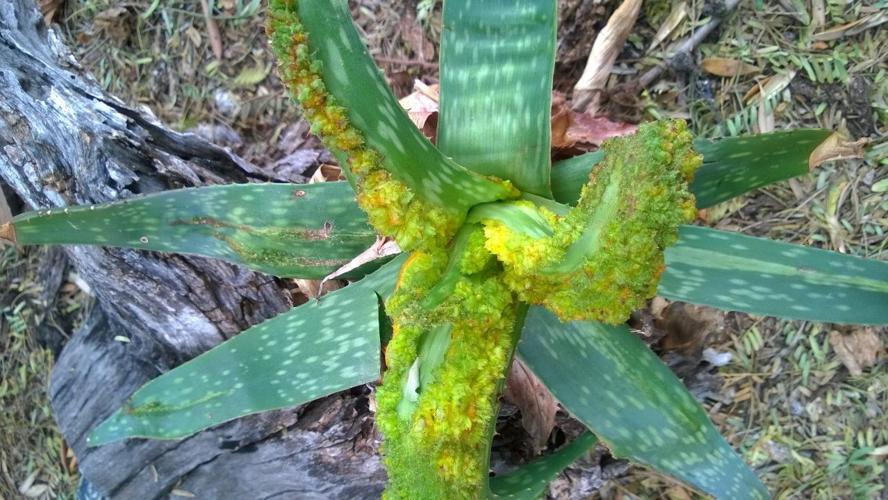
- By Peter L. Warren Special to the Arizona Daily Star
Q: I have attached a photo of my coral aloe (Aloe striata). After much searching, I believe the hideous, growth seen in the photo is aloe cancer/gall/mite? I have dug up, bagged and put the plant in the trash. Apparently, I can never have another aloe again except Blue Elf? Is this true, and is this wretched little mite a menace to my neighbor’s aloes? Is there anything else I should do? It makes me almost miss the killing freezes in Colorado!
A: I believe you are correct about the diagnosis. That appears to be damage caused by the eriophyid mite (Aceria aloinis). Because these mites are microscopic, it is difficult to know they are there until the damage is seen. There is some anecdotal evidence that the “Blue Elf” variety of aloe is unaffected but there is no science to back this up that I have seen. On the other hand, other known host plants include the aloe species arborescens, dichotoma, nobilis, and spinossima as well as Haworthia species. In general, I don’t see these mites as a widespread problem so I wouldn’t put all my aloe investments in one species. They are sporadic pests on aloes and based on the number of questions I get, many people don’t have a problem with them. These mites can spread by crawling and by wind. Because they can’t fly it isn’t a quickly spreading problem and your neighbor’s plants could very well be safe from infestation. What you did by bagging the infested plant and disposing of it is the best thing to do and probably enough to stop it from spreading.
Peter L. Warren is the urban horticulture agent for the Pima County Cooperative Extension and the University of Arizona. Questions may be emailed to
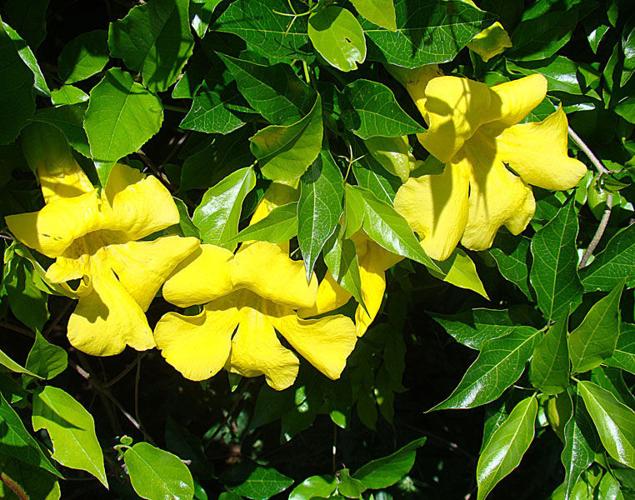
- By Peter L. Warren Special to the Arizona Daily Star
Q: We are planting cat claw vines along a fence line for privacy. We chose cat claw for its low water use, fast growing and lower temperature tolerance. We live in Catalina at 3,140 feet. Our soil is gravelly sandy silt for 18 inches with a silty clay layer below. We have built 4-foot wide by 8-foot tall trellises to cover the 50-foot stretch along a chain link fence on the south side of our house. The trellises are rebar and four-by-four-inch welded mesh panels. I just read that cat claw may not be suitable for planting on wire. Why? I had not read that before. If it’s about strength shouldn’t what we have built support them? How far apart should we plant the vines, the nursery told us five feet. Would four feet be too close? Would one foot from the fence be appropriate?
A: The reason wire fences are not recommended is because the foliage of cat claw vine (Macfadyena unguis-cati) tends to concentrate near the top of the plant making it top heavy. The average wire fence would likely not support such a heavy plant. Rebar and welded mesh panels are probably tougher than the wire fence you read about. You might need to add horizontal stretches of wire to prevent the vine from pulling away once it fully covers the trellis. This is a fairly aggressive vine and should ultimately fill in the gaps when planted five feet apart. Growth should start slow and speed up once it becomes established. One foot from the fence seems right.
Peter L. Warren is the urban horticulture agent for the Pima County Cooperative Extension and the University of Arizona. Questions may be emailed to
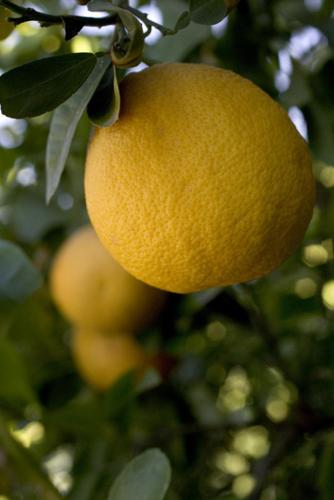
- By Peter L. Warren Special to the Arizona Daily Star
Q: I live in Tucson (caliche paradise). I have a ruby red grapefruit tree in my patio. It is 20 years old, 17 feet tall. Over the years I have trimmed it into a nice shade tree that gives us 150 square feet of shade. It has four separate trunks off the main trunk. The main trunk is 38 inches in circumference. I just harvested it and counted over 500 large grapefruit. I have not fed it in the last 10 years. I deep water every 10 days in the summer and once a month in winter. What is the normal life span? What am I doing wrong?
A: Grapefruit trees do not need a lot of fertilizer. A mature tree of the size you described probably has roots extending past the patio and receiving fertilizer from your turfgrass, garden, etc. Or perhaps the site is on a former agriculture field and there is still some residual fertilizer left in the soil. Or perhaps there is fertilizer in the irrigation water. Sooner or later, the tree will show nutrient deficiencies. Maybe it already is, but your yield is not yet affected. Grapefruit trees can live to be 50 years under ideal conditions but insects, diseases, and user errors often take their toll and shorten life spans. Your irrigation schedule seems to be on track so other than finding a way to add some fertilizer to the outer root zone, I think you are doing a fine job taking care of your tree.
Peter L. Warren is the urban horticulture agent for the Pima County Cooperative Extension and the University of Arizona. Questions may be emailed to

- By Peter L. Warren Special to the Arizona Daily Star
Q: We have chickens running free in a backyard of citrus trees, and to protect the flock I’ve avoided using granular citrus fertilizer to feed those trees. I’ve used water-soluble general plant food followed with a top dress of compost or mulch, but want to meet the particular nutritional needs of the citrus. How would you suggest fertilizing the citrus?
A: The way you are fertilizing is fine. The important information to know is how much nitrogen, phosphorus, and potassium (potash) is in your water-soluble plant food. The percent of these three nutrients contained in a particular product are usually listed in that order, separated by dashes, on the front of the fertilizer container. Once you know the percent nitrogen, you can cross-reference that with the size the tree in our handy chart to determine how much fertilizer to put down. The difficult thing to know about compost and mulch is the amount of nitrogen available to the plant. The good companies put an analysis of the compost on the bag but still you have to wait for the compost to be watered into the root zone and that can take varying amounts of time dependent on your soil type and how much water is used. The nice thing about compost and mulch is that independent of the nutrients they provide, there is protection of the root zone that can moderate temperature extremes and increase the water holding capacity of the root zone. By the way, depending on how many chickens you have, you may be getting significant additional fertilizer from them.
Peter L. Warren is the urban horticulture agent for the Pima County Cooperative Extension and the University of Arizona. Questions may be emailed to
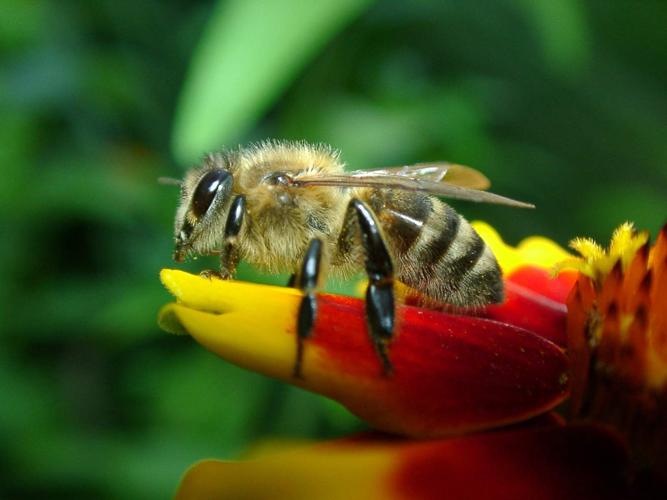
- By Peter L. Warren Special to the Arizona Daily Star
Q: I was finally sitting outside last week with my soda and had up to five aggressive bees wanting my beverage. Yikes! They even have a memory cause the next day without my beverage, they were still checking me out! I also noticed them in my recycle bin. I don’t remember this happening before. Is anything different going on?
A: The main thing going on this year is a slightly colder winter. Honeybees overwinter in their hives to keep warm and feed on the honey they stored during the warmer months. On nice days, they are as likely to get outside as you are and they will also partake in a sweet beverage. Since not as many flowering plants are available in the winter, you may see honeybees in recycle bins where food and drink residues may be found in addition to having some competition for your beverage.
As you exclaim, “careful man, there’s a beverage here,” be reminded that we all have to eat and a sugary beverage is a food source for a bee.
Peter L. Warren is the urban horticulture agent for the Pima County Cooperative Extension and the University of Arizona. Questions may be emailed to

- By Peter L. Warren Special to the Arizona Daily Star
Q: I live in Sierra Vista and have a small peach tree, about 3 to 4 years old. Last spring it bloomed for the first time and set about a dozen peaches. When the fruit was a bit smaller than golf ball size, I noticed each one had a small hole and was oozing a clear sap-like substance. I assume an insect of some kind that had bored into the fruit caused it. Each peach shriveled up and fell off the tree. With what should I treat my tree and when to prevent this again?
A: Peaches and other fruits such as pomegranates are potential food for a few different insect species. Based on your description, I suspect one of the larger plant bugs we refer to as leaf-footed bugs. They have piercing-sucking mouthparts that penetrate the fruit to suck out the sap. Their saliva has a toxin in it that injures the fruit. The resulting wound is also an entry point for disease and that is possibly what caused the fruit to shrivel and fall from the tree. Treating for this insect is challenging because as adults they are fast moving and can fly. The insecticides used are contact poisons so you need to know where they are and hit them directly with the treatment. There are organic and conventional insecticides available for this pest.
The best time to treat for them is when they are young. The young are yellow-orange in color and usually hang out in a group. Since you have a small tree this will be easier than if you had an orchard of trees to monitor.
The other thing you can do is look for eggs on your tree and remove them before they hatch. This hatch occurs in a week or less after they are laid so monitoring once a week is critical to removing them before they emerge. The eggs are laid in a row along a stem or the midrib of a leaf and are golden-brown in color. Since these insects also feed on citrus and pomegranates, it is good to monitor those plants as well if you have them nearby.
Peter L. Warren is the urban horticulture agent for the Pima County Cooperative Extension and the University of Arizona. Questions may be emailed to
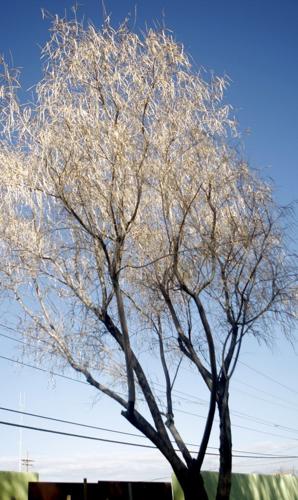
- By Peter L. Warren Special to the Arizona Daily Star
Q: We have some old mesquite trees and palo verde trees near our walking lanes. There are old clay unsealed sewer pipes nearby at a depth of about 4 feet. Are we at risk for sewer problems? How far should any tree be from a lane with old sewers? As for new trees, we were thinking of planting more of the above but not near the walk lanes. Desert willows were also suggested, but they may need more water. Do you have any other suggestions?
A: Your sewer pipes are at risk with tree roots nearby. Typically, mature tree roots extend 2 to 3 times the width of the crown so it is wise to give any potential obstructions such as sewer pipes, sidewalks and houses enough room. Since the trees are old and so are the pipes, you might wait and see if a problem presents. It is certainly a good idea to have the pipes inspected or monitor the water use rate if you suspect a leak. There are quite a few choices for low water use trees. The decision usually begins by measuring the space you have available both below ground and above ground. The mature size of a tree should be accounted for in any plan to plant. Desert willows are a low water use tree and a good one if your space isn’t large enough for a mesquite tree. Other species to consider include white thorn acacia, ironwood and Texas ebony. Your plan should also include irrigation even though you are planning to go with a low water use tree. Even native desert species need some water.
Peter L. Warren is the urban horticulture agent for the Pima County Cooperative Extension and the University of Arizona. Questions may be emailed to

- By Peter L. Warren Special to the Arizona Daily Star
Q: Should I be worried that my landscaper severely trimmed the bottoms of these two old agaves? He said the reason was to keep snakes from hiding there and make it easier for them to clean around. He removed one without notifying me, saying it was too close to the other and was “dying.” I see some evidence of west-side gray leaves; does this mean my agaves are dying or is it sun damage?
A: It is troubling that your landscaper pruned these plants and so severely. Typically, agaves don’t need pruning unless they have diseased or damaged leaves. Some people prune off the pointy leaf ends if they extend into walkways but even this is damaging to the plant. If snakes are a regular problem in your area, maybe there is a good reason for protecting the landscapers.
It’s not clear what sort of cleanup is required from the photos or what you asked him to do in that regard. Removing one because it was too close makes sense although it probably should have been discussed before removing it.
Finally, agaves don’t do great in direct western sun so you might be seeing sunburn on the leaves facing that direction.
Peter L. Warren is the urban horticulture agent for the Pima County Cooperative Extension and the University of Arizona. Questions may be emailed to

- By Peter L. Warren Special to the Arizona Daily Star
Q: I’m in SaddleBrooke and have a few Thompson Yuccas. The recent winds caused one yucca to break off half way up, in the middle of its trunk. The breaking point looks to have had an injury at that point in its past. These plants are on the expensive end and are listed as disease- and pest-free, so I’m surprised to find myself with these issues.
A: Thompson yuccas (Yucca thompsoniana) are very tough plants and they do not have any known pests. They are tolerant of extreme heat and cold hardy to minus 10 degrees. The photo you sent shows what appears to be a rotten core and that made it susceptible to the winds that snapped it off. It’s likely that the past injury you noted was the beginning of the problem and may have allowed for disease to enter and progress.
I also noticed the leaves, which are typically darker green; seem to be suffering from lack of moisture and possibly salt damage. While these plants are drought tolerant, providing irrigation every two weeks in the summer and every three weeks in the spring and fall to a depth of 12 to 18 inches is recommended and makes them look better. Regular irrigation will also help wash the salt through the root zone.
Peter L. Warren is the urban horticulture agent for the Pima County Cooperative Extension and the University of Arizona. Questions may be emailed to
- By Peter L. Warren Special to the Arizona Daily Star
Question: Is there a list of fruit trees that grow in Tucson? Specifically, I am interested in peaches, apricots, cherries (sweet and sour) and apples? If they need a pollinator, which varieties do best together?
Answer: The main limiting factor to successfully growing fruit trees in Tucson is the lack of cold weather. Fruit trees require a certain amount of chilling hours to produce fruit, and we do not consistently get enough cold weather to meet the requirements for many fruit trees you may have seen or heard about in other parts of the country. Fortunately, there is a good selection of fruit trees that do fine here, and as long as you stick with these, you can have many years of harvesting your homegrown fruit. From your list of interests, you can find varieties of peaches, apricots and apples that grow well here. We don’t have cherries, but you can substitute figs, pears, persimmons, plums, quince, grapes, kiwi, blackberries, strawberries and pomegranates. Here is a link to our publication on fruits and nuts that includes much of what you need to know about these varieties. You will notice that the ones that do well in the low desert of Tucson are marked. There is a link to the pdf version that has a nice chart showing when they are harvested and if they require cross-pollination. Go to ag.arizona.edu/pubs/garden/az1269
Peter L. Warren is the urban horticulture agent for the Pima County Cooperative Extension and the University of Arizona. Questions may be emailed to tucsongardensage@gmail.com

- By Peter L. Warren Special to the Arizona Daily Star
Question: Thanks to our climate, I’m doing a postmortem for last season’s garden and planning seed starting for next season pretty much simultaneously. About tomatillos: I’ve had rotten luck. I’ve had single plants, mixed varieties, started seeds, bought plants from reputable local nurseries and have tried to appropriately manage watering and soil nitrogen. Tomatoes have done just fine. Tomatillos? I’ve had rotten luck.
Answer: Now is an excellent time to revisit and evaluate your gardening practices in 2015. In theory, growing tomatillos should be easy although they are as sensitive to the heat as tomatoes and there are a few insects to watch for so you don’t lose your crop. Shade cloth can help protect them once the spring heat kicks in and checking for insects once a week should be sufficient to manage pests before they get out of control. Here are some basic guidelines for growing tomatillos. Please let me know if you are already doing all these things.
Tomatillos should be planted in full sun with well-drained soil. Jan. 15 to Feb. 15 is the ideal planting time, although you can wait until March if you are using transplants. Drip irrigation is ideal and should provide an inch of water per week. Multiple plants are required for pollination.

- By Peter L. Warren Special to the Arizona Daily Star
Question: Thanks to our climate, I’m doing a postmortem for last season’s garden and planning seed starting for next season pretty much simultaneously. About tomatillos: I’ve had rotten luck. I’ve had single plants, mixed varieties, started seeds, bought plants from reputable local nurseries and have tried to appropriately manage watering and soil nitrogen. Tomatoes have done just fine. Tomatillos? I’ve had rotten luck.
Answer: Now is an excellent time to revisit and evaluate your gardening practices in 2015. In theory, growing tomatillos should be easy although they are as sensitive to the heat as tomatoes and there are a few insects to watch for so you don’t lose your crop. Shade cloth can help protect them once the spring heat kicks in and checking for insects once a week should be sufficient to manage pests before they get out of control. Here are some basic guidelines for growing tomatillos. Please let me know if you are already doing all these things.
Tomatillos should be planted in full sun with well-drained soil. Jan. 15 to Feb. 15 is the ideal planting time, although you can wait until March if you are using transplants. Drip irrigation is ideal and should provide an inch of water per week. Multiple plants are required for pollination.
Question: Is it too late for my bougainvilleas? I was out of town during the recent night freezes in Tucson, and I now have two bougainvilleas that are half frozen (they look great where the branches were protected by my awning). What do I do with the dead half? Pinch off the flowers and leaves? Prune it back? Just leave it alone?
Answer: Since you still have live parts it’s not too late to cover them in case we get more frosts. They will likely come back from this damage. The dead parts will protect the living parts somewhat in case we have more frosty temperatures so leave the dead parts on the plant until the spring when the danger of frost has passed.
Peter L. Warren is the urban horticulture agent for the Pima County Cooperative Extension and the University of Arizona. Questions may be emailed to tucsongardensage@gmail.com

- By Peter L. Warren Special to the Arizona Daily Star
Question: I live here in Tucson at Villa Catalina condos at Sixth Street and Country Club Road. We have a small rose garden with some beautiful flowers. My problem is some of our larger flowers don’t fully open. I get a very large ball, very tight, but will not open. Then there are flowers next to them, and they open nicely. Any ideas?
Answer: There are a couple possible answers to this problem. If the rose buds that don’t open appear unhealthy, possibly with a browning on the edges, there are known diseases and insects that can affect them. If the buds appear to be healthy, a more likely problem is environmental stress. According to local rose expert and master gardener volunteer, Lauren Kettenbach, this time of year that is a common problem. Before Thanksgiving there was some pretty cold weather, and then it got warm again. So it could be weather-related, and it’s also very late in the season to have any blooms at all. I would not worry unless there is a problem with the spring bloom.
Peter L. Warren is the urban horticulture agent for the Pima County Cooperative Extension and the University of Arizona. Questions may be emailed to tucsongardensage@gmail.com
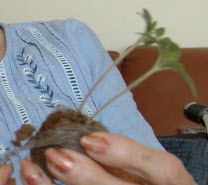
- By Peter L. Warren Special to the Arizona Daily Star
Question: We live in the Tanque Verde area. In the spring I planted a tomato seedling in very good soil in the planter next to the house on the patio. It grew quite tall and produced tomatoes. I missed the weather forecast for our first frost, and the leaves wilted. Since then I’ve hung frost cloth from the eaves every evening, which traps the heat from the house. Last week when it was 26 on the patio it was 40 inside the frost cloth. Since it was wilted I cut the plant down, intending to uproot it, but noticed new green shoots coming from the bottom. Any hope for the plant, or should I start over in the spring?
Answer: As you saw, even if the temperatures are below freezing for a short time, some plants will die back above the soil and still be alive below ground. It is best to cover frost-sensitive plants when possible. In many cases, protecting plants with frost cloth can make the difference between survival and starting over. Your tomato could be fine since you are seeing new growth now. Time will tell for your plant and for many others. Patience is a virtue when determining how much damage your plants suffered. Some plants will not show new life until mid-spring.
Peter L. Warren is the urban horticulture agent for the Pima County Cooperative Extension and the University of Arizona. Questions may be emailed to tucsongardensage@gmail.com
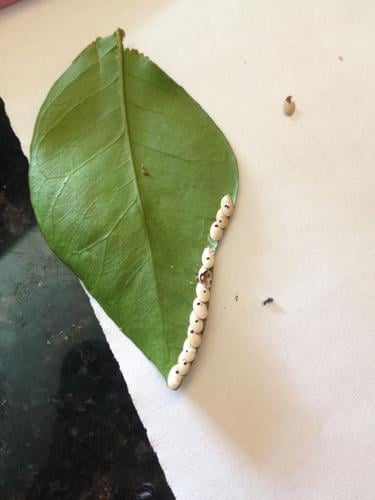
- By Peter L. Warren Special to the Arizona Daily Star
Q: Any idea whose eggs these are? They were on an orange tree in Tucson.
A: Katydid laid those eggs. Technically, katydids are grasshoppers of the long-horned variety (Family Tettigoniidae) due to their long antennae. They get their name from the noise they make in the evenings that seems to say ka-ty-did if you use your imagination. Because they often resemble the leaves of trees they inhabit, it is difficult to see them unless they move about. Their eggs resemble small seeds and are laid in a nice row on foliage or stems mostly. Like other grasshoppers, katydids feed on foliage although no appreciable damage is done so they are more of a curiosity than a pest.
Peter L. Warren is the urban horticulture agent for the Pima County Cooperative Extension and the University of Arizona. Questions may be emailed to tucsongardensage@gmail.com

- By Peter L. Warren Special to the Arizona Daily Star
Q: I am writing to see if you have information about peach tree blight. I have two peach trees in Green Valley and both have been affected by a blight that causes the peaches to shrink in size and become inedible. Is there a treatment for this disease? Both trees have produced fruit for many years and are now advanced in age; one tree is 37 years old and the other over 30 years. They both still produce green leaves and fruit.
A: Improper pruning, not enough thinning of fruit, or poor soil fertility, can cause too small fruit. The other factor in your situation is the age of the trees. Peach trees don’t live forever and the average lifespan is around 15 years. I love old trees but if your goal is fruit production, the best thing is to replace your old trees with a couple of younger ones. Peaches typically start producing fruit by age 3 or 4 so if you can’t wait for fresh peaches, select a tree of that age to replace your older trees.
Peter L. Warren is the urban horticulture agent for the Pima County Cooperative Extension and the University of Arizona. Questions may be emailed to tucsongardensage@gmail.com.

- By Peter L. Warren Special to the Arizona Daily Star
Q: Our small HOA is trying to convert to desert or semi-desert landscaping. It’s a fight, as some owners want the same flowers they had back east or in California, but we keep trying. We have a number of old Cyprus trees on the property and have been told that it is OK to disconnect the drip irrigation systems currently watering them because they have a well-established root system that will ensure they get enough water. Do you agree it is OK to not water them any longer? We don’t want them anymore, but can’t afford to cut them down. I’d also like to learn what desert plants you recommend that don’t need regular watering, provide color, and, if it’s not asking too much, what months they bloom?
A: Keep up the good fight for native desert or desert-adapted plants. We can always go visit our old plant friends from other places but it is hard to sustain them here. Cypress trees need water just like everyone else. If you cut off the supply, those trees will eventually die of complications from drought. The problem with just letting them die is they might fall and hurt somebody or something. If they are out in the middle of nowhere that might be okay but I am guessing they are not. There are desert plants that don’t need much water but everything needs some water.
The extreme examples get by with seasonal rainfall but even those plants suffer when we have a drought. There are quite a few choices of shrubs you can use that provide color and don’t require much water. A good online source of information for this is amwua.org/plants and of course you can always chat up your local Cooperative Extension agent, plant nurseries and Master Gardener volunteers about specific plants.
Peter L. Warren is the urban horticulture agent for the Pima County Cooperative Extension and the University of Arizona. Questions may be emailed to tucsongardensage@gmail.com

- By Peter L. Warren Special to the Arizona Daily Star
Q: We have been having a bad stink bug infestation (hemipterans not pinacate beetles) the past couple of years in the garden. This past year they were out early and often and basically ruined the entire tomato crop. We are at 5,000 feet and don’t plant until May. First fruits are almost never harvested before Aug. 15. It is a cold zone with 46 nights at or below freezing so far this winter (no that is not a misprint). Do you have any suggestions to deal with these pests?
A: There are a couple things you can do. First, it is helpful to scout once a week when your crop comes up to see when the stink bugs begin to lay eggs. They are laid in a mass of 10-25 on the underside of leaves and look like tiny barrels. You can reduce the population significantly by removing the eggs before they hatch. Once they hatch and are actively feeding you can spray them and the sooner, the better while they are still young. If your crop is organic there is a product called PyGanic that works pretty well on hemipterans. If you use conventional pesticides, there are more choices but they may have some restrictions on when you apply them relative to when you harvest.
Peter L. Warren is the urban horticulture agent for the Pima County Cooperative Extension and the University of Arizona. Questions may be emailed to tucsongardensage@gmail.com

- By Peter L. Warren Special to the Arizona Daily Star
Q: I have a backyard of Bermuda that is overseeded with annual rye grass. Last year was my first in this house and I moved in during January to find numerous winter weeds sprouting in the over-seeded Bermuda grass. With the recent rains I have the same weeds returning. Will a general-purpose weed and feed fertilizer/herbicide take care of the weeds or should I use another product? When should I apply? Last year I removed the weeds by pulling them out by hand.
A: Without knowing which weeds you are seeing I would guess you are concerned about winter annual broadleaf weeds such as London rocket. These are called winter annuals because they germinate in the fall, survive the winter, and sprout in the spring. Our winter in Tucson being mild and short, these weeds don’t waste time waiting for the vernal equinox and are up and flowering now. The answer to your question is likely yes; any post-emergent broadleaf weed herbicide will take these weeds down. A cautionary note: your trees and shrubs are in the same plant category as your broadleaf weeds so be careful about applying these herbicides on these desired plants and their root zones. In most situations, spot treating your weeds is better than carpeting your lawn with herbicide both for saving your desirable plants and for saving a few bucks on the product.
It is best to treat your weeds now before they go to seed. Be careful to avoid windy days so the herbicide doesn’t drift onto nearby plants and follow any other precautions listed on the label. Pulling weeds is also an option and can be therapeutic, if you have the time and the energy. Finally, keeping your lawn healthy is a good defense against weeds.
Peter L. Warren is the urban horticulture agent for the Pima County Cooperative Extension and the University of Arizona. Questions may be emailed to tucsongardensage@gmail.com
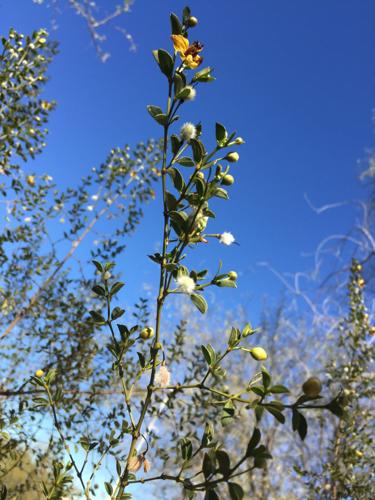
- By Peter L. Warren Special to the Arizona Daily Star
Q: What is the best month in the Tucson/Marana area to trim back hibiscus and bougainvillea plants? Also, I need to cut back and trim greasewood so what is the best month for that shrub?
A: Hibiscus species should be pruned in late winter to promote growth in the spring because it blooms from buds produced in the same season. Bougainvillea species can be pruned once the danger of frost has past, usually mid-March. During the growing season, vigorous shoots can be pruned as needed. Greasewood, aka creosote (Larrea tridentata), doesn’t require any pruning except to control the size and that can be done any time.
Peter L. Warren is the urban horticulture agent for the Pima County Cooperative Extension and the University of Arizona. Questions may be emailed to tucsongardensage@gmail.com

- By Peter L. Warren Special to the Arizona Daily Star
Question: I am trying to find out what kind of plants I can plant in my garden that will help ward off insects.
Answer: Despite a large amount of misinformation published on this topic, there are no plants that can be used to repel insects effectively. There are, however, plants that can be planted together to reap other benefits. Flowering plants can be used to attract beneficial insects that help manage pests. Mostly these helpful plants are flowering plants that supply nectar and pollen to the predators and parasites that prey on pest insects. The nice thing is most any flowering plants can be effective in this way so you can choose ones that you like and that do well in your area. One plant feature that works well is flowers that face up and form a cup or sorts that can hold rainwater since water can be scarce. Another idea is planting varieties that are more attractive to pests and can be used as trap crops to lure the pests away from a desirable crop. The grower then has the option to spray the trap crop with the pests on it or simply let them eat it. Also, some plants act as nurse plants for more sensitive species by shading them. We often see saguaro cacti growing this way naturally in the desert.
Peter L. Warren is the urban horticulture agent for the Pima County Cooperative Extension and the University of Arizona. Questions may be emailed to tucsongardensage@gmail.com
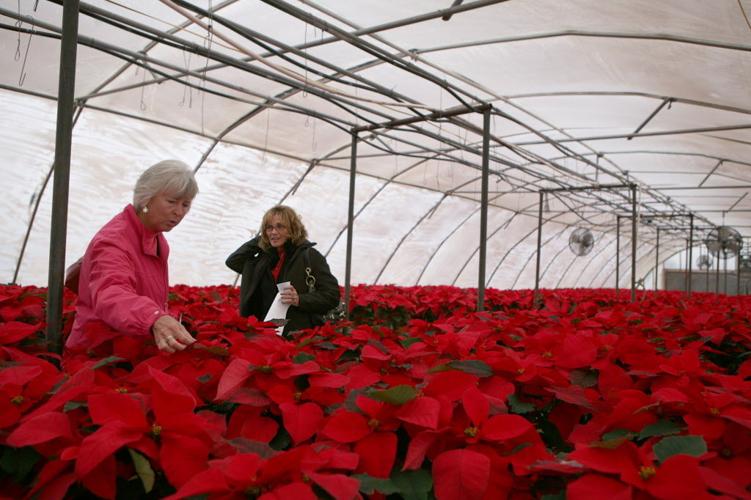
- By Peter L. Warren Special to the Arizona Daily Star
Poinsettias thrive on bright natural daylight: at least six hours daily is recommended. Placement near a sunny window is ideal, but avoid locations where hot afternoon sun may shine directly on, and fade colorful bracts.
To prolong the bright red of the bracts, temperatures ideally should not exceed 70 degrees during the day, or fall below 65 degrees at night. Avoid placing poinsettias near drafts, fluctuating air currents, excess heat and dry air from appliances, fireplaces or ventilating ducts. Poinsettias are sensitive to cold temperatures and outside placement during the winter months is not recommended when temperatures are below 55 degrees Leaf drop will occur if poinsettias are exposed to temperatures below 50 degrees
Poinsettias do best with moist soil so water when the soil surface feels dry to the touch. Like other container plants, the best indication of a thorough watering is water begins to seep through the drain holes at the bottom of the pot. Don't leave them sitting in water or they may suffer from root rot. It is not necessary to fertilize your poinsettias during the holiday season, however, beyond the holidays you should apply a balanced, all-purpose household plant fertilizer to promote new growth.
Poinsettias can be grown year round for lush green foliage.
March or April: When the bracts age and turn to a muddy green, cut the stems back to about eight inches in height. After you cut the plant back, it will probably look rather stark, with bare branches and bluntly cut woody stems.
By the end of May, you should see new growth. Keep the plants near a sunny window.
Around July 4: Cut branches back again about half their length to encourage bushy plants. You may place your poinsettias outdoors in indirect sun when night temperatures are warmer. Continue to water the plants regularly during the growing period. Fertilize every two to three weeks throughout the spring, summer and fall months with a complete, indoor plant fertilizer.
The poinsettia is a plant that requires a long period of darkness and is termed a "short day" (long night) plant. Short-day plants form flowers only when day length is less than about 12 hours. Many spring and fall flowering plants are short day plants, including chrysanthemums, poinsettias and Christmas cactus. If these are exposed to more than 12 hours of light per day, bloom formation does not occur.
November or December: Poinsettias will naturally bloom depending upon the flowering response time of the particular cultivar. This can be tricky to do outside of a controlled greenhouse environment, because any stray artificial light could delay or halt the flowering of the plants.
To make this work, the plants must be kept in complete darkness for 14 continuous hours each night beginning Oct. 1. This can be done by moving the plants to a dark room, or placing a large box over them. During this period, the plants require six to eight hours of bright sunlight and night temperatures between 60 and 70 degrees. This regimen must continue for about eight to 10 weeks for the plants to develop colorful bracts for the holiday season.
If this seems like too much effort, you can always support the horticulture industry by purchasing another poinsettia.
Peter L. Warren is the urban horticulture agent for the Pima County Cooperative Extension and the University of Arizona. Questions may be emailed to tucsongardensage@gmail.com

- By Peter L. Warren Special to the Arizona Daily Star
Question: I found this insect on my gas grill today. Is this the kissing bug I have been reading about?
Answer: What you are seeing is the giant agave bug (Acanthocephala thomasi). Kissing bugs (Triatoma species) are smaller and don’t have the bright orange feet and orange tips on the antennae. Also, the kissing bugs feed primarily on mammals, such as pack rats and humans, whereas the bug you found feeds on plants. Recently, there was a flurry of news reports in other parts of the country on the kissing bugs and the associated Chagas disease they can transmit. These stories then spread through social media, gathering some misinformation as they went. So I understand why you are concerned. Despite the media hype, this was not actually new information.
Kissing bugs are more common in the Southwest. However, the risk of Chagas disease transmission in Arizona is very low, according to University of Arizona Cooperative Extension Specialist Dawn Gouge. UA researchers found a high rate of infection (about 40 percent) of kissing bugs in southern Arizona by the protozoan Trypanosoma cruzi that causes the Chagas disease infection. However, the kissing bugs in Arizona differ from those in areas where Chagas disease is a health problem and are not as effective in transmitting the disease to humans. The reason has to do with the timing of blood feeding and defecating. Our local species fly then poop as opposed to poop then fly. The protozoa are passed in feces, not during blood feeding, so by waiting to defecate until after they fly from where they eat, their behavior greatly reduces chances for transmission.
Peter L. Warren is the urban horticulture agent for Pima County Cooperative Extension and the University of Arizona. Questions may be emailed to tucsongardensage@gmail.com
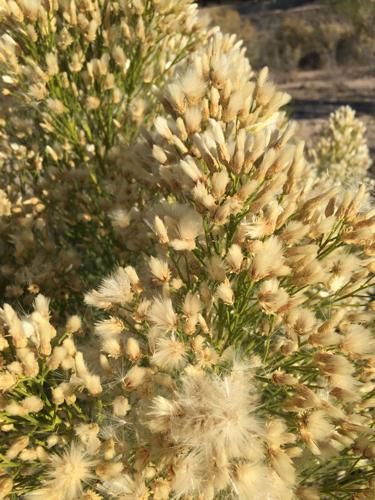
- By Peter L. Warren Special to the Arizona Daily Star
Question: I have a desert broom plant in my yard that has turned into a tree. I really like it but it is now blooming and is sending cottony stuff all over the yard. My neighbor said it is a weed and a nuisance and I should cut it down. Is there any way I can keep it from blooming?
Answer: Desert broom (Baccharis sarothroides) is a native plant and very common in the Southwest. It is often considered a weed because of its ability to colonize open spaces quickly. My predecessor at the University of Arizona Cooperative Extension, George Brookbank, was a proponent of this plant as a good native shrub for landscape use, so not everyone sees this plant as a weed. There is no way to prevent it from blooming, but you could prune off the flowers before they go to seed and start taking flight. That way you could still enjoy the plant to some extent and hopefully appease your neighbor.
Peter L. Warren is the urban horticulture agent for Pima County Cooperative Extension and the University of Arizona. Questions may be emailed to tucsongardensage@gmail.com

- By Peter L. Warren Special to the Arizona Daily Star
Question: Our HOA has declared war on buffelgrass: a good thing. But rather than remove it, they are having intense commercial spraying of glyphosate using concentrations higher than the typical herbicide available to homeowners. I cannot find information (from scientific sources such as .edu) about the immediate or long-term toxicity of the spray on cactus or our desert trees. Do you know of any research showing what it may do?
Answer: According to our University of Arizona Cooperative Extension Weed Specialist, Bill McCloskey, direct spraying of cacti with glyphosate repeatedly will probably kill most cactus species but they can withstand incidental spray contact (i.e., the whole plant is not sprayed) intermittently and can survive a single direct spraying. Generally, we recommend spraying grass-specific herbicides for grass control (e.g., fluaziflop, sethoxydim or clethodim on bermuda grass) to avoid injuring the cacti. Unfortunately, this class of herbicides doesn’t work well on buffelgrass, but maybe repeated spraying would eventually do it. Manual removal of buffelgrass would be effective in this case but understandably hard around cacti.
Peter L. Warren is the urban horticulture agent for Pima County Cooperative Extension and the University of Arizona. Questions may be emailed to tucsongardensage@gmail.com
- Peter L. Warren Special to the Arizona Daily Star
Q: Can you tell me if this tree is a cedar of Lebanon?
A: It looks like a deodar cedar (Cedrus deodara) from a distance. Cedar of Lebanon (Cedrus libani) branches usually form level layers in a mature tree. The deodar doesn’t usually look as layered and the branches and the leader tend to droop at the ends.
To be sure, you can count the needles in a cluster and you can measure them. The cedar of Lebanon has clusters of 15 to 45 whereas the deodar cedar has clusters of 20 to 30 so there is some overlap but if you can find some with greater than 30 needles that is a good clue.
Of the three true cedar trees in the genus Cedrus, the longest needles belong to the deodar cedar. If most needles exceed 2ƒ centimeters is likely a deodar cedar.
Peter L. Warren is the urban horticulture agent for Pima County Cooperative Extension and the University of Arizona. Questions may be emailed to tucsongardensage@gmail.com

- By Peter L. Warren Special to the Arizona Daily Star
Q: Today I spoke with two lovely ladies at the Oro Valley Farmers market. I asked about this flower that grows wild in my yard. When I first saw it I thought it was a form of dandelion, but it has a gorgeous iridescent white bloom that opens at dusk. The hawk moths love it. The seedpods are plentiful right now, all dried up at the base of the plant. I’m including some pictures to help identify it. One woman showed me a photo of a birdcage primrose, however I’m thinking it is just an evening primrose.
A: There are a few species of primrose so it’s easy to get confused. I checked with our friends at the University of Arizona Herbarium and they think it is Oenothera caespitosa, commonly known as tufted evening primrose and fragrant evening primrose. This low-growing perennial is found throughout the West in sunny, dry, infertile, rocky, well-drained soils. It requires little water, which makes it a good choice for xeriscape gardens. Moderate watering will keep it blooming all summer.
Peter L. Warren is the urban horticulture agent for Pima County Cooperative Extension and the University of Arizona. Questions may be emailed to tucsongardensage@gmail.com

- By Peter L. Warren Special to the Arizona Daily Star
Q: Do you have any info that would help our HOA organize its response to its fountain grass infestation? Also, are there any fountain grass variations that local nurseries sell that are sterile and won’t spread?
A: Fountaingrass (Pennisetum setaceum) is a fast growing, attractive, perennial, fire-adapted bunch grass and in our ideal environment can reach several feet tall and wide. It does just fine in dry environments although some rain helps. Unfortunately, it invades desert areas and readily outcompetes native species.
There are some varieties that are purported to be sterile but research shows they’re not 100 percent sterile and that’s a deal breaker considering it is invasive. Since it is a noxious weed in dry areas like ours I recommend removing it when possible, spraying with herbicides when necessary, and not planting it again. As is sometimes the case with invasive plants, humans are guilty of planting this species before we knew it was invasive. When it was first introduced, it was thought to be just another pretty grass for medians and landscapes.
Peter L. Warren is the urban horticulture agent for Pima County Cooperative Extension and the University of Arizona. Questions may be emailed to tucsongardensage@gmail.com

- By Peter L. Warren Special to the Arizona Daily Star
Q: We are snowbirds here November through March. Much of our landscape was redone the last week of March and we departed April 3. Now we have just returned and I see our 5-gallon emus (red valentine shrubs) have bit the dust and a couple red barrels are dying. These plants should have been sturdy enough for their western exposure site. Our new sprinkler system is one year old and works fine. Would you guess that these plants should not have been planted so late in the spring before we left right away? Perhaps they needed two to three daily waterings on hot summer days but no one was here? Our gardener/landscaper didn’t indicate that there should be any problems and he knew we are here just part time and he set the sprinklers.
We both chose the plants together and he knew we were leaving immediately after he installed the landscape. He wasn’t able to schedule our work sooner and I think maybe the job shouldn’t have been done after late January to allow the plants to settle in before the heat hit.
A: The last week of March and into April we were seeing temperatures in the high 80s and low 90s. If your irrigation was working properly and delivering the right amount of water then you might have been OK, although western sun exposure is a tough place to get started when it gets hot.
Drip irrigation is the preferred method rather than a sprinkler and the recommended amount for the summer season is once every 14 days to a depth of 12 to 18 inches for the barrel cacti and 24 to 36 inches for the emu shrubs. The barrels (Ferocactus species) are certainly desert plants and the emu (Eremophila maculata) is from Australia and a good desert adapted plant so their chance of survival in your area is good.
You are asking the right questions and if you are planning to try again, I recommend planting earlier, maybe now, so they can get established before the summer and make sure to adjust your irrigation to fit the needs of the plants.
Peter L. Warren is the urban horticulture agent for the Pima County Cooperative Extension and the University of Arizona. Questions may be emailed to tucsongardensage@gmail.com

- By Peter L. Warren Special to the Arizona Daily Star
Q: When is the correct time to prune roses in the Tucson area? And do you prune them like we do in the Midwest, i.e. cut back near the ground?
Answer: The pruning of roses is recommended twice per year in Tucson. The first pruning can be done in late January to a height of 15 inches or so. This time remove all dead wood, crossing branches, and small leaves. Seal the fresh pruning cuts with Elmer’s glue to prevent insects from invading the newly cut branches, fertilize, and then water.
In mid-September a lighter pruning is recommended. This time remove one third of the plant along with any diseased or dead wood but leave any leaflets. Seal fresh cuts with Elmer’s Glue, fertilize, and water.
The Pima County Master Gardeners teach classes on roses and other things at some of the public libraries in case you’re interested. Check your library schedules or call the Extension Office for more information,626-5161.
Peter L. Warren is the urban horticulture agent for the Pima County Cooperative Extension and the University of Arizona. Questions may be emailed to tucsongardensage@gmail.com

- By Peter L. Warren Special to the Arizona Daily Star
Q: I am writing to inquire about recommendations for a nontoxic approach to controlling citrus leafminer on a young lime tree I am growing in a large pot. I do not recall having this pest in the past and have had limes, grapefruit and lemons for many years. This new lime tree I planted about a year ago is now infested on all the new leaves and I am wondering if there might be a nontoxic method to reduce or eliminate them. I have looked up information on the web but the recommendations seem to be relatively toxic and I would prefer to avoid those if possible.
A: Because your lime tree is young, insecticides are generally recommended to prevent these insects from slowing the growth of the tree. That said, you could let your tree tough it out since there are natural enemies that prey on the citrus leafminer and the leaves they damage are still effective food producers for the tree.
Other things you can do to manage the situation include avoiding pruning except for water sprouts and branches broken by wind, et cetera, and only fertilizing outside of the normal flights of the adults. The adults are most often seen in the summer and fall months. Both pruning and fertilizing promote the new growth that is most attractive to these insects.
Peter L. Warren is the urban horticulture agent for the Pima County Cooperative Extension and the University of Arizona. Questions may be emailed to tucsongardensage@gmail.com

- By Peter L. Warren Special to the Arizona Daily Star
Q: I’ve never seen a bug like this one found in my garage. It had eyes and would move quickly when I put my finger in front of it.
A: This is a solpugid. It is a member of the arachnid class in the phylum of arthropods and related to spiders and scorpions but distinct enough to warrant their own order. Their habitat is the desert and they are predators of other arthropods and have a reputation for being fast; their top speed is reportedly around 10mph. They have no venom, are harmless to humans, and do a good bit of pest management for us while we sleep. All things considered, they are good to have around.
Peter L. Warren is the urban horticulture agent for the Pima County Cooperative Extension and the University of Arizona. Questions may be emailed to tucsongardensage@gmail.com

- By Peter L. Warren Special to the Arizona Daily Star
Question: I have a palm tree the city wants me to trim. I don’t want to spend the money to have someone else do it. I don’t want to climb a 20-foot ladder with a chainsaw. And I like the way this tree looks. Can you help me by saying something about how this form is considered by many people to be attractive and is a common landscape practice?
Answer: It is a common practice to leave a full skirt on palm trees and you can find others in the city just like yours. Most palm trees with a full skirt are a bit taller and as long as the bottom 10 feet of the tree is bare and the dead fronds are away from anything that might catch fire, everything is deemed okay. Some people find the natural form of these trees with a full skirt to be attractive and others like to see them well pruned. Unfortunately for you, the city requires the latter when the skirt hangs low like yours does. The hazards of palm skirts and the risks are mostly fire and having it fall on someone and crush them.
Peter L. Warren is the urban horticulture agent for the Pima County Cooperative Extension and the University of Arizona. Questions may be emailed to tucsongardensage@gmail.com
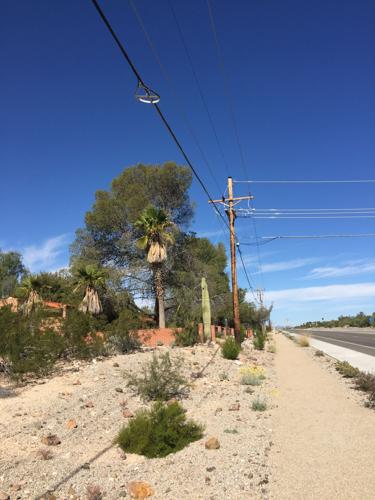
- By Peter L. Warren Special to the Arizona Daily Star
Question: I found a patch of Aleppo pine that is dying on the west side of La Canada. The road was recently widened (3 years ago) and this whole group fronts close to the road. Could the die-off be due to road widening?
Answer: Yes, the trees could be suffering from the road widening. Construction would likely damage the roots on that side of the tree and typically damage such as this shows up above ground a few years later. It would be difficult to protect such large trees in a road-widening because their roots likely extend two to three times the width of the crown. In a different construction situation the property owner could ask for a protective zone to be fenced off around the tree to help more of the root system to survive. Typically when we see trees that have been attacked by pine engraver beetles, the color of the needles ranges from straw to reddish colors.
Peter L. Warren is the urban horticulture agent for the Pima County Cooperative Extension and the University of Arizona. Questions may be emailed to plwarren@cals.arizona.edu

- By Peter L. Warren Special to the Arizona Daily Star
Question: I occasionally run across a dead branch on some of my mesquite trees. The dead branch sticks out like a sore thumb, and on closer inspection, there is a ring around the branch etched into the bark. The foliage in front of the ring is dead, but behind everything appears fine. First, do you know what causes this? Second, should I be concerned. And third, should I be preventing this and how? Right now, all I do is prune the branch out.
Answer: The ring etched in the bark is the work of the mesquite twig girdler (Oncideres rhodosticta). This beetle is in the family Cerambycidae that are commonly referred to as long-horned beetles due to their long antennae. The adults aren’t commonly seen on the trees although they are attracted to lights at night if you want to find them. The female chews a ring in the stem and deposits her eggs further out on the stem. The eggs hatch in the stem and the larvae feed on the dying wood in the stem caused by the girdle cutting off nutrients to the end of the branch. The larvae will overwinter in the wood and adults will emerge in the spring. Research has shown the damage has no affect on the health of mesquite trees and it is simply nature’s way of pruning. So the good news is you don’t have to do anything to prevent these beetles from chewing on your trees.
Peter L. Warren is the urban horticulture agent for Pima County Cooperative Extension and the University of Arizona. Questions may be emailed to tucsongardensage@gmail.com

- By Peter L. Warren Special to the Arizona Daily Star
Q: I’m looking for a good tree that gives fall color. I’m trying to decide between a Texas red oak and a red push pistache. Is one a better tree for our desert climate? Which grows quicker and has better form? It would be planted about 20 feet from our home in Marana. Could you give me info about each tree so I could make a good choice?
A: The Texas red oak (Quercus buckleyi), aka the Texas hill country red oak, is a deciduous shade tree that may reach 30 feet in height and 60 feet in width under ideal circumstances. It has excellent fall color and makes a good specimen for our area. The downside might be the leaf litter and the acorns, depending on how you feel about either cleaning up after them or not. The red push pistache (Pistacia chinensis) is a hybrid deciduous tree that also has excellent fall color, maybe even better than the oak. Its growth is moderate and at maturity it typically reaches 40 feet tall by 35 feet wide. The leaflets are smaller and should be less troublesome than the oak leaves. The pistache should just fit your space if you plant it 20 feet away. The Texas red oak is typically a larger tree and would not fit your space as well.
Peter L. Warren is the urban horticulture agent for the Pima County Cooperative Extension and the University of Arizona. Email him at csongardensage@gmail.com
- By Peter L. Warren Special to the Arizona Daily Star
Q: I have been buying firewood (mesquite and eucalyptus) to burn some and use some for woodcrafts like lathe-turned vases. It is common for the wood to be full of large round and oblong holes that are caused by some type of insect. Recently I was able to extract two almost whole grubs of some sort from a piece of mesquite. One “grub” is essentially round, and the other has a large head, sort of triangular, and a smaller round body. Can you tell me what these are and if they pose any danger to my house? Is there anything I can do to get rid of them?
Also, I cut some fresh mesquite last spring and left it in my garage to dry over the summer. It became riddled with small circular holes, apparently caused by some different insect. In this case the damage is pretty much limited to the early, or sap wood. Can you also give me some information about the insect that causes this other type of damage?
A: The two grubs are representatives of common wood-boring beetles from the Buprestidae and Cerambycidae families of insects. The round one is a larva of a long-horned beetle and the one with the large head is a larva of a metallic wood-boring beetle. Both of these insects are associated with dying or dead trees. Their galleries can be seen on sapwood, as you described, and the adult beetles are commonly seen emerging from firewood. They are not known to infest or reinfest dry wood so your home is safe. The small circular holes are from bark beetles, another species commonly associated with dying and dead trees in our area. In the forest, these three are examples of insects helping decompose trees into soil. Without them and the associated fungi and bacteria, we would be up to our eyeballs in timber and our soils would have even less organic matter than usual.
Peter L. Warren is the urban horticulture agent for the Pima County Cooperative Extension and the University of Arizona. Email him at csongardensage@gmail.com
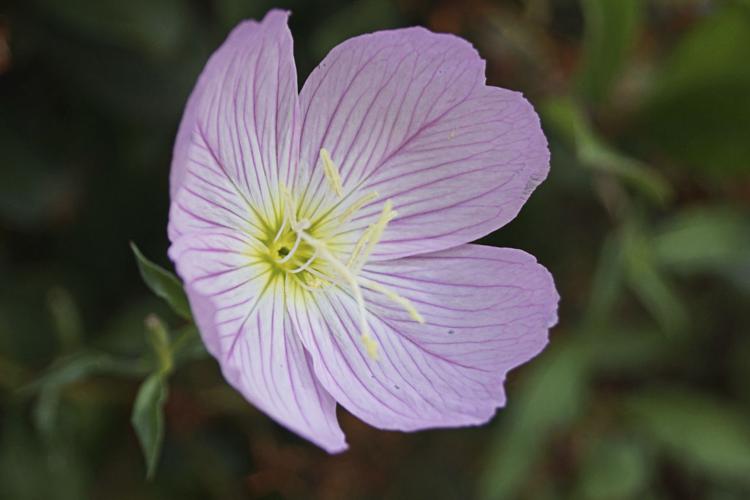
- By Peter L. Warren Special to the Arizona Daily Star
Q: How can I stop the infestation of Mexican primrose into my Bermuda lawn? Not knowing how invasive this plant can be, I placed several on a slope next to a grass area. Plants have now started growing in the grass.
A: Since Mexican primrose is a broadleaf plant, you can either pull it up as you see it or you can use a broadleaf herbicide to keep it out of your lawn area by spot treating where you see it coming up.
There are many broadleaf herbicides available and some are packaged with nonselective chemicals that also kill grass, like glyphosate.
It is important to read the label to make sure you are not also getting something that will kill your lawn and to make sure you understand the safety precautions for applying it.
Peter L. Warren is the urban horticulture agent for the Pima County Cooperative Extension and the University of Arizona. Questions and requests for site visits may be emailed to
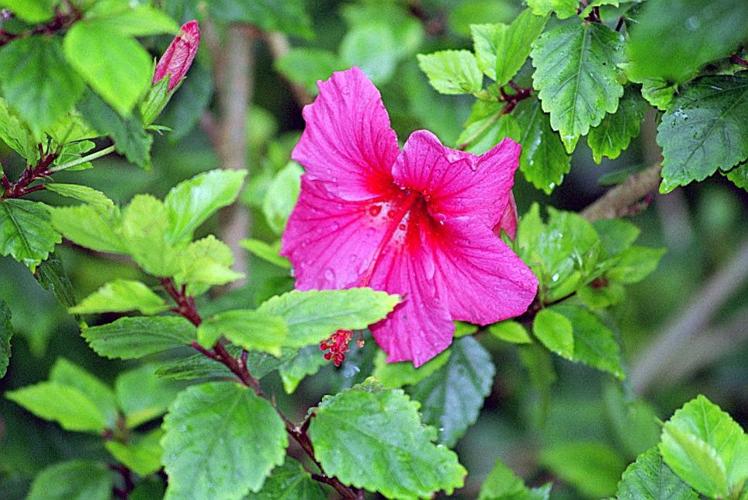
- By Peter L. Warren Special to the Arizona Daily Star
Q: I purchased a Hibiscus rosa-sinensis plant and I wonder if it can go in my front (open) patio. I don’t see many others around here in Green Valley, so I guess the javelina like them.
A: The hibiscus you purchased, sometimes called Chinese or Hawaiian hibiscus, is a tropical variety and would probably be best grown in a container in your neighborhood so that you can bring it indoors during the winter.
They don’t tolerate the temperatures we experience in the cool part of the year. The javelina would probably enjoy it as well, so maybe you maybe you can find an elevated place to put it out of reach or grow it indoors.
Peter L. Warren is the urban horticulture agent for the Pima County Cooperative Extension and the University of Arizona. Questions and requests for site visits may be emailed to
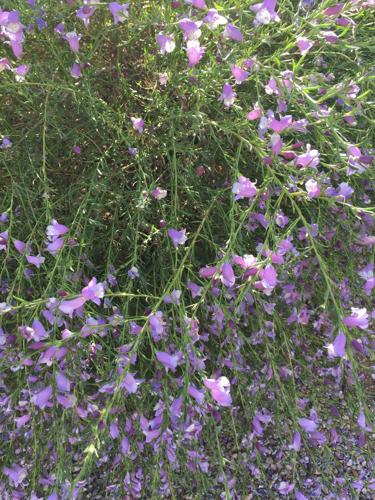
- By Peter L. Warren Special to the Arizona Daily Star
Q: I saw this plant while walking to work on campus. Can you tell me what it is?
A: The plant is called spotted emu bush (Eremophila divaricata). It’s an Australian native in the figwort or Scrophulariaceae family, which also includes the Texas rangers we see around these parts.
These shrubs do well in arid environments and seem to fair better with afternoon shade in our climate. Although they are desert-adapted plants, they do require some water.
Peter L. Warren is the urban horticulture agent for the Pima County Cooperative Extension and the University of Arizona. Questions and requests for site visits may be emailed to
Tags
View this profile on Instagram#ThisIsTucson 🌵 (@this_is_tucson) • Instagram photos and videos
Most viewed stories
-
Tucson is now home to the largest outdoor mural in the state 🎨
-
50 fun events happening in Tucson this weekend Nov. 7-10 🧵🎞
-
Tucson tattoo artist inked into the spotlight as contestant on 'Ink Master' season 16
-
Turkey and pie: where to get free Thanksgiving dinners this month
-
34 FREE events happening in Tucson this November 2024 💸
-
10 beautiful photos from Sunday's All Souls Procession ❤️
-
100 fun events happening this November 2024 🦖🎨
-
Everything you need to know about this year's All Souls Procession
-
A giant list of restaurant patios in Tucson: brunch, fine dining and more
-
Fabulous science: this burlesque show combines glamour, dance and STEM



